








A longeva atuação do Serviço Social do Comércio – Sesc, em seus 76 anos de existência, demonstra a solidez de uma instituição presente em todo o território nacional e empenhada em produzir efeitos positivos nos lugares em que atua. Criada pelo empresariado do comércio de bens, serviços e turismo, suas ações voltam-se prioritariamente aos trabalhadores desses setores, mas também a seus familiares e a sociedade em geral.
No estado de São Paulo, a instituição segue em expansão, ampliando sua capacidade de atendimento e articulando interesses de acordo com o reconhecido compromisso do setor privado em participar ativamente do desenvolvimento econômico e social local. Considerando a cultura e a educação como capital que ativa e articula conhecimentos basilares para o crescimento econômico e para mobilidade social, as atividades oferecidas pelo Sesc ressoam individual e coletivamente.
Nesse âmbito, o CIRCOS - Festival Internacional Sesc de Circo, em sua sétima edição, é exemplo de realização que conjuga compromisso social e formação de plateias. Aliando democratização da cultura à ativação de distintas cadeias produtivas, o Sesc colabora com setores da economia que contribuem para que as potencialidades de pessoas e grupos sejam desenvolvidas, colaborando, dessa maneira, para a constituição de uma sociedade mais criativa e promissora.
Presidente do Conselho Regional do Sesc São Paulo President of the Regional Council of Sesc São Paulo
The long-standing performance of the Serviço Social do Comércio –Sesc [Social Service of Commerce], in its 76 years of existence, demonstrates the strength of an institution present throughout the national territory and committed to producing positive effects in the places where it operates.
Created by the business and services community in the trade of goods, services and tourism, its actions are aimed primarily at workers in these economic sectors, and also at their families and society in general.
In the state of São Paulo, the institution continues to grow, expanding its service capacity and articulating interests in line with the recognized commitment of the private sector to actively participate in local economic and social development. Considering culture and education as a capital that activates and articulates
fundamental knowledge for economic growth and social mobility, the activities offered by Sesc resonate individually and collectively.
In this context, the CIRCOSFestival Internacional Sesc de Circo [CIRCUS – Sesc International Circus Festival], in its seventh edition, is an example of an achievement that combines social commitment and audience formation. Combining the democratization of culture with the mobilization of different production chains, Sesc collaborates with sectors of the economy that support the development of individuals’ and groups’ potential, thus contributing to building a more creative and promising society.
No que se refere à possibilidade de vivenciar a diversidade, a área cultural é particularmente generosa. O contato com os diferentes costumes e tradições tende a enriquecer as relações sociais advindas desses encontros, dada a pluralidade de características presentes. No meio artístico, o circo é uma das linguagens cênicas em que tais aspectos estiveram presentes desde sua origem. A característica itinerante das trupes de outrora atraía pessoas tanto para fruírem seus espetáculos quanto para atuarem sob suas lonas, em seus palcos ou nos bastidores deles.
Na contemporaneidade, dessa mescla de referências e saberes seguem emergindo diferentes habilidades e vertentes artísticas, renovando processos de inspiração e criação dos artistas envolvidos. Atento às recentes produções nacionais e internacionais, o Sesc apresenta a sétima edição do CIRCOS - Festival
Internacional Sesc de Circo , que acontece desde 2013, com a realização de espetáculos, intervenções, atividades formativas, além de debates e publicações.
Na edição de 2023, que marca uma década do projeto, o evento traz um panorama diversificado do circo contemporâneo, dialogando com a importância da diversidade e da representatividade de povos e culturas em suas apresentações. Em consonância com a encruzilhada cultural que caracteriza a formação brasileira, a instituição entende ser fundamental o reconhecimento e a presença da heterogeneidade de corpos, fazeres e saberes em todos os espaços e posições sociais, corroborando assim para uma sociedade verdadeiramente mais justa e democrática.
Diretor do Sesc São Paulo Director of Sesc São Paulo
Concerning the possibility of experiencing diversity, the cultural area is particularly generous. Contact with varied customs and traditions enriches the social relationships arising from these encounters, given the plurality of characteristics that are present. In the artistic world, the circus is one of the scenic languages in which such aspects have been present since its origin. The itinerant characteristic of the troupes of yesteryear attracted people both to enjoy their shows and to perform under their big tops, on their stages, or behind the scenes.
In contemporary times, from this mixture of references and knowledge, different skills and artistic aspects continue to emerge, renewing processes of inspiration and creation of the artists involved. Aware of recent national and international productions, Sesc presents the
seventh edition of the CIRCOS –Festival Internacional Sesc de Circo [CIRCUS – Sesc International Circus Festival], which has been taking place since 2013, with shows, artistic interventions, educational activities, as well as debates and publications.
The 2023 edition, which marks a decade of the project, brings a diverse panorama of the contemporary circus, dialoguing with the importance of diversity and representation of peoples and cultures in its performances. In line with the cultural crossroads that characterize Brazilian formation, the institution understands that the recognition and presence of the heterogeneity of bodies, actions and knowledge in all spaces and social positions are fundamental, thus corroborating the pathway to a truly fairer and more democratic society.
CIRCOS: UM PICADEIRO DE DIVERSIDADES
THE DIVERSITY
TRAJECTORIES, TRADITIONS AND INNOVATIONS IN
INSTALAÇÃO
INTERVENÇÕES ARTÍSTICAS
ARTISTIC
AÇÕES FORMATIVAS / MESAS / LANÇAMENTO
EDIÇÕES SESC / RESIDÊNCIA CIRCENSE
EDUCATIONAL ACTIVITIES / PANELS / EDIÇÕES SESC
BOOK LAUNCH / CIRCUS RESIDENCY
ENCONTRO DE PROGRAMADORES PROGRAMMERS MEETING
GRADE DE PROGRAMAÇÃO SCHEDULE
UNIDADES ADDRESSES CIRCOS NAS REDES CIRCOS ONLINE
SOBRE O SESC ABOUT SESC CONTATOS CONTACT INFORMATION
Fazer um festival artístico na contemporaneidade é lidar com diferentes possibilidades e caminhos. Além dos discursos que estão por trás de cada obra, o pensamento curatorial tem que levar em consideração um contexto mais amplo. Como as proposições podem se transformar em provocações e gerar debates e reflexões acerca de temas pungentes na sociedade atual?
A diversidade cultural vem assumindo uma dimensão complexa e urgente. A arte possibilita que os indivíduos tomem consciência de sua existência política e social e, com isso, ampliem seus olhares sobre a realidade. Por isso, é essencial a diversidade de representações na cena para uma maior compreensão de nossas dimensões culturais e simbólicas.
Nos últimos tempos tivemos ainda um agravante que incidiu diretamente nas manifestações culturais e
simbólicas no mundo todo. A conjuntura pandêmica e pós-pandêmica e seu impacto na produção circense não pode ser ignorada, seja do ponto de vista da criação — que exige o trabalho coletivo e constante de corpos ativos e criativos —, seja no campo da difusão, isto é, do encontro com os públicos. Encontro que historicamente se consolida e se renova pelo encantamento.
O risco que os artistas correm, a virtuose de seus corpos, sua irreverência e comicidade atraem adultos e crianças. E, assim como as demais artes cênicas e performáticas, o circo não é estático. Muito pelo contrário: ano após ano, com mais ou menos dificuldades, a cena circense evolui e abre o picadeiro para outros espaços e perspectivas, com narrativas amplas e plurais.
Cada vez mais, temas como gênero, raça, sexualidade e discussões em torno do que são os corpos diversos
Planning an art festival in contemporary times is an exercise in dealing with different possibilities and paths. In addition to the discourses behind each show, curatorial thinking must take into account a broader context. How can propositions become provocations and generate debates and reflections on poignant themes in today’s society?
Cultural diversity has taken on a complex and urgent dimension in recent years. Art makes it possible for individuals to become aware of their political and social existence and, thereby, broaden their perspectives on reality. Therefore, the diversity of representations on stage is essential for a greater understanding of our cultural and symbolic dimensions.
In recent times, we have had an aggravating factor that has directly affected cultural and symbolic manifestations around
the world. The pandemic and postpandemic conjuncture and its impact on circus productions cannot be ignored, whether from the point of view of the creative process — which requires the collective and constant work of active and creative bodies —, or in the field of diffusion, which is the encounter with audiences. A meeting historically consolidated and renewed by enchantment.
The risk that the artists take, the virtuosity of their bodies, their irreverence and their humor attract adults and children alike. And, like other performing arts, the circus is not static. Quite the contrary: year after year, with more or fewer difficulties, the circus scene evolves and opens the circus ring to other spaces and perspectives, with broad and plural narratives.
Increasingly, themes such as gender, race, sexuality and
ganham destaque. Este é o enfoque da curadoria da sétima edição do CIRCOS – Festival Internacional
Sesc de Circo, que destaca produções circenses como formas de expressão capazes de elaborar discussões críticas atuais e essenciais para a sociedade. Assim, a programação do festival contempla uma pluralidade de corpos, origens e estéticas, visando criar espaços para trocas e reconhecimentos de referências não hegemônicas dentro do universo circense.
O festival apresenta montagens com temas sensíveis e importantes da atualidade, como os espetáculos Yé – Água, do Circus Baobab (Guiné), com foco na desigualdade da distribuição de água potável no planeta; ou King Kong Fran, apresentado por Rafaela Azevedo (Brasil/RJ) que, por meio da palhaçaria, traz reflexões sobre sexualidade, assédio e outros temas tabus. Outra montagem que chama a atenção para as questões socioculturais é Colibri – Uma Fábula Circense Latino-americana, do coletivo Um Café da Manhã: com artistas do Brasil, Colômbia, México e Peru, o trabalho coloca em cena temas como decolonialismo e as identidades latino-americanas.
O circo está para além da diversão e do fascínio proporcionados ao público. E é justamente por essa razão que esta edição do CIRCOS se reafirma como espaço fundamental para o estímulo ao desenvolvimento da linguagem circense e a expansão de horizontes tanto para artistas quanto para públicos.
Desejamos a todos um lindo festival, e que as provocações, trocas e reflexões apresentadas
nesta edição evidenciem elementos importantes para a continuidade em defesa da diversidade cultural como princípio fundamental da cidadania e da democracia.
Marina Tomaz Zan e Natalie Ferraz Kaminski são assistentes na Gerência de Ação Cultural do Sesc São Paulo
discussions around what diverse bodies are are gaining prominence. This is the focus of the curatorship of the seventh edition of CIRCOS — Festival Internacional Sesc de Circo [CIRCUS – Sesc International Circus Festival], which highlights circus productions as forms of expression capable of elaborating critical discussions that are current and essential for society. Thus, the festival’s programming contemplates a plurality of bodies, origins and aesthetics, aiming to create spaces for exchanges and recognition of non-hegemonic references within the circus world.
The festival presents productions with sensitive and important current themes, such as the shows Yé – Water , by Circus Baobab (Guinea), focusing on the unequal distribution of drinking water on the planet; or King Kong Fran , presented by Rafaela Azevedo (Brazil/RJ) which, through clowning, brings reflections on sexuality, harassment and other taboo topics. Another show that draws attention to sociocultural issues is Hummingbird – A Latin American Circus Fable , by the collective Um Café da Manhã: with artists from Brazil, Colombia, Mexico and Peru, the work brings to the scene themes such as decoloniality and Latin American identities.
The circus is beyond the fun and fascination it provides. And it is precisely for this reason that this edition of CIRCOS reaffirms itself as a fundamental space for stimulating the development of circus language and expanding horizons for both artists and audiences.
We wish everyone a beautiful festival, and that the provocations, exchanges and reflections presented in this edition contribute with important elements for the continuity in defense of cultural diversity as a fundamental principle of citizenship and democracy.
Este texto propõe uma reflexão importante para o desenvolvimento do circo no território nacional, sem a pretensão de encerrar o tema ou de colocar verdades absolutas. Para abordar este debate partimos de uma questão central que acreditamos ter ampla ressonância neste universo artístico: como algumas das formações nas artes circenses, que aconteceram nos últimos anos no Brasil, têm influenciado a cena circense?
A principal e mais contundente mudança na linguagem circense brasileira do final do século passado foi a criação das escolas de circo, a partir dos anos 1980. Esse fato gerou uma mudança na formação dos artistas que, anteriormente, eram “nascidos” no circo. Ou seja, “os saberes” eram passados para pessoas que faziam parte do círculo familiar, ou então que optavam viver junto às famílias circenses. Com o advento das escolas, pessoas que se interessavam pela linguagem
do circo tiveram a oportunidade de vivenciar esses saberes fora da lógica familiar, e puderam se desenvolver até chegarem à possibilidade de atuarem como profissionais. Das primeiras escolas de circo nasceram grupos, coletivos e artistas que influenciam a cena circense nacional até os dias atuais.
Vale observar que essas escolas e formações já existiam e aconteciam em outros locais do mundo. Porém, no contexto brasileiro, há a necessidade de uma atuação vinculada às camadas mais populares da sociedade. Dessa forma, as escolas e esses saberes circenses que atuam em locais com maior vulnerabilidade social culminaram no surgimento do “circo social”, uma experiência concebida no Brasil, tanto como prática quanto como conceito. Conceito este que, depois, foi utilizado por grandes grupos circenses mundo afora. Algumas pesquisas
This article proposes an essential reflection on the development of the circus in the national territory, without intending to close the theme or to impose absolute truths. We start from a central question that has broad resonance in this artistic world: how have some of the training courses in circus arts, which have taken place in recent years in Brazil, influenced the circus scene?
The primary and most striking change in the Brazilian circus language at the end of the last century was the creation of circus schools, starting in the 1980s. This fact generated a change in the training of artists who, previously, were born in the circus. That is, “knowledge” was passed on to people who were part of the family circle or who chose to live with circus families. With the advent of schools, people who
were interested in the language of the circus had the opportunity to experience this knowledge outside the family logic and were able to develop until they reached the possibility of acting as professionals. The first circus schools stimulated the emergence of groups, collectives and artists that, from then on, influenced the national circus scene until the present day.
These schools and formations already existed in other parts of the world. However, in the Brazilian context, there is a need for action linked to the most popular layers of society. In this way, schools and this circus knowledge that operate in places with greater social vulnerability culminated in the emergence of the “social circus”, an experience conceived in Brazil, both as a practice and as a concept. A concept that was
apontam que os primeiros projetos de circo social aconteceram no Rio de Janeiro, no projeto Se essa rua fosse minha, e também no Araguaia pão e circo, em Goiás.
Vale ressaltar que o surgimento do circo social não é algo isolado e aparece em um momento que conflui com práticas que nasceram em diversos lugares, cultivadas por pessoas e realidades distintas.
“O circo social é uma tecnologia social complexa de código aberto, colaborativo. (...) Este processo envolve diversos grupos artísticos, iniciativas educacionais populares, movimentos sociais. Colocando assim uma base para uma articulação de ideias, práticas e recursos, que impulsionam a criação da rede Circo do Mundo Brasil”, como lembrou o artista e pesquisador Claudio Barria, da Universidade Federal Fluminense (UFF), no evento Fórum Permanente: Circo Social: Arte, Engajamento e Transformação Comunitária, organizado pela Universidade de Campinas (Unicamp).
O circo possui uma potência atrativa para os jovens, que se veem fascinados pela oportunidade de aprenderem a equilibrar-se em bicicletas de uma roda só, ou de andarem em cima de um arame, ou de manusearem diversos objetos sem deixá-los cair. A vitalidade dos exercícios, somados à poética da linguagem, tornam-se o grande atrativo desses locais, que ofertam vivências artísticas e culturais para desenvolver uma autonomia que pode gerar a garantia dos direitos desses jovens.
A juventude que é atendida pelo circo social tem, em primeira instância, acesso a uma atividade
que propõe um enfoque político-pedagógico. Trata-se de uma atividade que aposta no desenvolvimento criativo e na construção da cidadania. Como consequência do trabalho continuado, alguns projetos geram escolas artísticas, que formam artistas circenses de alto nível para atuarem em paridade com pessoas em outras instituições nacionais e internacionais. Mas, infelizmente, temos uma oferta de trabalho que não consegue absorver esses profissionais, que acabam por atuar fora dos principais circuitos culturais brasileiros.
Além disso, temos outro gargalo: jovens que atingem a idade de 18 anos deveriam ser encaminhados para estágios profissionalizantes. Uma das possibilidades que temos no Brasil como continuidade dessa formação é a Escola Nacional de Circo Luiz Olimecha (ENCLO). Com período de formação de dois anos, a Escola Nacional forma artistas de alto nível. Não à toa, companhias internacionais admitem com certa frequência esses artistas brasileiros cuja formação inicial se deu em circos sociais.
O que isso revela é que, embora haja um consenso de que exista excelência na formação de artistas circenses nos países ditos do norte – como Canadá e alguns países europeus –, a internacionalização dos artistas brasileiros demonstra a proeminência no desenvolvimento pedagógico de circo no Brasil. Isso se dá também pela capacidade desses artistas imprimirem às suas criações alguns aspectos tradicionais e inerentes da linguagem circense, algo que podemos entender como uma “brasilidade”, que potencializa e destaca alguns
later used by large circus groups around the world. Some research points out that the first social circus projects took place in Rio de Janeiro, in the If this street were mine [Se essa rua fosse minha] project, and also in Araguaia bread and circuses [Araguaia pão e circo], in Goiás.
The emergence of the social circus is not something isolated and arises from practices that were born in different places, cultivated by different people and realities. “The social circus is a complex, open source, collaborative social technology. (...) This process involves several artistic groups, popular educational initiatives, and social movements. Thus laying a foundation for an articulation of ideas, practices and resources, which drive the creation of the Circo do Mundo Brasil [Circus of the World Brazil] network”, as recalled by the artist and researcher Claudio Barria, from the Fluminense Federal University, at the Permanent Forum event: Social Circus: Art, Engagement and Community Transformation, organized by the University of Campinas (Unicamp).
The circus is attractive to young people, who are fascinated by the opportunity to learn how to balance themselves on bicycles with only one wheel, ride on a wire, or handle different objects without letting them fall. The vitality of the exercises, added to the poetics of the language, become the great attraction of these places, which offer artistic and cultural experiences to develop an autonomy that can
guarantee the rights of these young people.
The youth who are part of the social circus have access to activities with a politicalpedagogical center of attention, focusing on creative development and building citizenship. As a result of continued work, some projects generate artistic schools, which train high-level circus artists to work on par with people in other national and international institutions. But, unfortunately, we have a job offer that cannot absorb all of these professionals, who end up working outside the main Brazilian cultural circuits.
In addition, we have another problem: young people aged 18 or over should be referred to professional internships. In Brazil, one of the possibilities for continuing this training is the Escola Nacional de Circo Luiz Olimecha (ENCLO). With a training period of two years, the National School trains high-level artists. It is no coincidence that international companies frequently hire these Brazilian artists, whose initial training took place in social circuses.
What this reveals is that, although there is a consensus that there is excellence in the training of circus artists in the so-called northern countries — such as Canada and some European countries —, the internationalization of Brazilian artists demonstrates the prominence in the pedagogical development of circus in Brazil. This is also due to the ability of these artists to imprint some
números clássicos do circo no cenário mundial.
Com isso, nos perguntamos: como uma linguagem potente como o circo se depara com a falta de incentivo de políticas públicas? O fomento que poderia ser um incentivo para o desenvolvimento de novas pesquisas, por vezes, acaba sendo apenas suficiente para fazer uma pequena manutenção no trabalho já criado. Deste modo, não raro, profissionais do circo têm que optar por ações que são mais “comerciais”, para suprirem a necessidade de se manterem ativos, em detrimento de uma possível pesquisa e do desenvolvimento artístico.
É sabido que, com o tempo, o circo foi sendo visto como algo exclusivamente infantil, ocupando esses locais nas programações culturais. Sendo colocado como puro entretenimento, e não como uma possibilidade de desenvolvimento de linguagem. Entretanto, vários coletivos e artistas de circo têm desenvolvido pesquisas sobre pautas atuais, como periferias, gêneros, recortes identitários e outros.
Voltando à questão de uma valorização da produção brasileira por parte de outros países, notamos que não basta copiar modelos que vêm de fora, nem olhar para eles como um ideal a ser alcançado. Devemos cultivar nosso próprio ideal e buscar condições estruturais, físicas, financeiras e artísticas para podermos desenvolver o nosso próprio circo contemporâneo em sua máxima potência.
O circo em si gera curiosidade e atrai muitos públicos. E esses públicos se interessam pelo que é produzido, pelos artistas e
espetáculos que são colocados na programação para além do entretenimento exclusivamente voltado para crianças. Vale ressaltar: não estamos dizendo ser problemático termos um direcionamento para o público infantil, menos ainda ser problemático que o circo seja visto como entretenimento. É necessário que as pessoas se entretenham, que se sintam atraídas a sair de suas casas para assistirem ao circo. Porém, a linguagem se mostra mais potente e mais plural que isso. E é esse o ponto que tentamos ressaltar. Então, é importante que esse diálogo se fortaleça e se expanda para que o circo possa habitar os mais diversos locais.
Outra adversidade que o circo encontra é a distribuição desigual de recursos públicos e privados entre as artes cênicas. Infelizmente, na maioria das capitais faltam espaços e instituições culturais dedicados exclusivamente à linguagem circense. Um exemplo disso é a inexistência de formação universitária em circo no país, ao contrário do que existe no teatro e na dança. No entanto, o circo no Brasil segue se desenvolvendo em um processo contínuo de construção e sendo reconhecido por sua vanguarda por meio de jovens artistas que conseguem seguir seus percursos de formação.
O circo, historicamente, se reinventa, apesar de inúmeras dificuldades materiais e simbólicas. No entanto, é necessário ser menos suscetível às conjunturas e conquistar melhores ambientes de formação e de trabalho; e é justamente isso que estamos pleiteando com esta reflexão.
traditional and inherent aspects of the circus language to their creations, something that we can understand as a “Brazilianness”, which enhances and highlights classic circus acts on the stage.
With that, we ask ourselves: how does a potent language like the circus face the lack of public policy investments? The funding that could be an incentive for the development of new research sometimes ends up being just enough to do a little maintenance on the work already created. Thus, not infrequently, circus professionals have to opt for shows that are more “commercial”, to meet the need to remain active, to the detriment of research and artistic development.
Over time, the circus was seen as something exclusively for children, occupying these places in cultural programs, seen as pure entertainment, and not as a possibility of language development. However, several collectives and circus artists have developed research on issues of the periphery, gender, identity cuts and others.
Returning to the issue of appreciation of Brazilian production by other countries, we note that it is not enough to copy models that come from abroad, nor to look at them as an ideal to be achieved. We must cultivate our ideal and seek structural, physical, financial and artistic conditions to be able to develop our contemporary circus to its maximum potential.
The circus generates curiosity and attracts many audiences. And
these audiences are interested in what is produced, in the artists and shows that are included in the programming, in addition to entertainment exclusively aimed at children. It is worth mentioning: we are not saying that targeting children is problematic, even less that it is problematic that the circus is entertainment. People must be entertained, to leave their homes to watch the circus. However, the circus language proves to be more potent and plural than that. And this is the point we try to emphasize: dialogue must be strengthened so that the circus can inhabit the most diverse places.
Another adversity that the circus faces is the unequal distribution of public and private resources between the performing arts. Unfortunately, most capital cities lack spaces and cultural institutions dedicated exclusively to the circus language. An example of this is the lack of university training in circus in the country, contrary to what exists in theater and dance. However, the circus in Brazil continues to develop in a continuous process of construction and is recognized for its vanguard through young artists who manage to follow their training paths.
The circus, historically, reinvents itself, despite numerous material and symbolic difficulties. However, it is necessary to be less susceptible to conjunctures and conquer better training and work environments; and that is precisely what we are pleading with this reflection.
The claim is for the leading role of the circus in the
A reivindicação é pelo protagonismo do circo nos espaços que ele ocupa na atualidade em instituições culturais, agendas e festivais. É urgente retomarmos os debates para que o cuidado com o futuro da linguagem tenha a mesma dimensão do que esta categoria artística é capaz de produzir. Assim, possivelmente, nos orgulharemos do futuro do circo.
Rafael Barros é doutorando em artes cênicas pela Universidade de São Paulo (USP), e pesquisador no grupo de pesquisa CEPECA (ECA/USP). É mestre em artes cênicas, também pela USP. Vencedor do Programa Nascente USP na categoria artes cênicas, com seu espetáculo solo El general. Fez residência artística na Escola de Palhaços de Barcelona – Cal Clown, na Espanha. Fundador do Grupo Exército Contra Nada (2011), atualmente com quatro espetáculos no repertório. Desde sua fundação, apresentou-se em mais de 300 cidades, por oito países diferentes, consolidando uma carreira internacional.
Adriano Mauriz é ator, diretor, palhaço, arte-educador e gestor cultural. Licenciado em artes visuais e especializado em artes cênicas. Fundador do Grupo Pombas Urbanas, atuou em todos os espetáculos do grupo desde 1989, realizando apresentações no Brasil e na América Latina. É presidente do Instituto Pombas Urbanas e um dos gestores do Centro Cultural Arte em Construção, em Cidade Tiradentes (SP), realizando os projetos: Artivistas/UNICEF, Cooperativa de artistas/Petrobrás, Encontro comunitário de teatro jovem e Somos do circo. Atualmente atua e dirige espetáculos nos grupos Pombas Urbanas, Circo Teatro Palombar e Exército Contra Nada. Representou o Movimento dos Pontos de Cultura do Estado de São Paulo na Comissão Nacional dos Pontos, recebendo o Prêmio Tuxáua Cultura Viva, do Ministério da Cultura (MinC), por sua atuação.
spaces it currently occupies in cultural institutions, agendas and festivals. We must resume the debates so that care for the future of the language has the same dimension as what this artistic category is capable of producing. Thus, possibly, we will be proud of the future of the circus.
Rafael Barros is a doctoral student in performing arts at the University of São Paulo (USP) and a researcher in the CEPECA group (ECA/USP). He holds a master’s degree in performing arts, also from USP. Winner of the Nascente USP Program in the performing arts category, with his solo show El general. He did an artistic residency at the School of Clowns in Barcelona – Cal Clown, Spain. Founder of the Grupo Império Contra Nada (2011), currently with four shows in its repertoire. Since its foundation, it has performed in more than 300 cities, in eight different countries, consolidating an international career.
Adriano Mauriz is an actor, director, clown, art educator and cultural manager. Graduated in visual arts and specialized in performing arts. Founder of the Pombas Urbanas Group, he has performed in all of the group’s shows since 1989, performing in Brazil and Latin America. He is president of the Pombas Urbanas Institute and one of the managers of the Centro Cultural Arte em Construção, in Cidade Tiradentes (SP), carrying out the projects: Artivists/UNICEF, Cooperative of artists/Petrobrás, Community meeting of young theater and We are from the circus. He currently performs and directs shows in the groups Pombas Urbanas, Circo Teatro Palombar and Império Contra Nada. Represented the Movement of Culture Points of the State of São Paulo in the National Commission of Points, receiving the Tuxáua Cultura Viva Award, from the Ministry of Culture (MinC), for his performance.
Como falar dos processos atuais de renovação nas artes circenses, ou seja, de suas trajetórias entre tradições e inovações em um território tão vasto e diversificado como a América Latina? Existem múltiplas respostas, mas comecemos esclarecendo que falar da América Latina nos situa em uma busca ligada às múltiplas histórias de negação/ invisibilização e colonialismo que pesam sobre estas territorialidades. Assim, somos mobilizados pela necessidade de incluir na agenda as realidades e histórias que se entrelaçam a partir do Sul.
Parte disto inspirou minha pesquisa sobre as histórias de renovação, reinvenção e tradicionalização das artes circenses no extremo Sul da América Latina, especificamente na Argentina; histórias das quais pouco se conhecia no país e menos ainda a nível internacional. Porém, estas questões não se reduzem à mera dinâmica territorial, mas também envolvem escalas de valor que
sobrepõem algumas artes a outras; e nestes processos o circo também tem sido historicamente colocado em inferioridade.
O circo – tanto na América Latina como no mundo – sempre ocupou um lugar ambíguo e por vezes contraditório, circulando entre o moderno e o pré-moderno, entre arte e entretenimento, entre transgressão e reprodução. No circo, os corpos treinados, eficientes e modernos que transmitiam domínio da natureza, progresso e superioridade, sempre coexistiram com outros corpos: festivos, populares, ilegítimos. Esta ambiguidade, própria do circo, provocou que ao longo da história esta arte tenha ocupado lugares pouco privilegiados, reforçando um imaginário de transgressão, um refúgio para os diferentes, um reduto de desobediência diante dos cânones hegemônicos.
Este fato está ligado a uma
How to approach the current processes of renewal taking place in the circus arts, in other words, their trajectories between traditions and innovations in a territory as vast and diverse as Latin America? There are multiple answers. But let’s start by clarifying that talking about Latin America places us in a pursuit linked to the multiple histories of denial/invisibility and colonialism that weigh on these territories. Thus, we are mobilized by the need to include in our agenda the realities and histories that are intertwined, originating from the South.
Part of this inspired my research on the histories of renewal, reinvention and traditionalization of circus arts in the far south of Latin America, specifically in Argentina — stories about which little was known in the country and even less abroad. However, these issues are not reduced to
mere territorial dynamics, but also involve scales of value that overlap some artistic expressions to others; in these processes, the circus has also historically been deemed inferior.
Circus — both in Latin America and in the world — has always occupied an ambiguous and sometimes contradictory place, moving between the modern and the pre-modern, between art and entertainment, between transgression and reproduction. In the circus, the trained, efficient and modern bodies that conveyed mastery of nature, progress and superiority, always coexisted with other bodies: festive, popular, and illegitimate. This ambiguity, characteristic of the circus, has meant that throughout history this art has occupied less privileged places, reinforcing a social imaginary of transgression, a refuge for those who are different, and a stronghold of disobedience in the face of hegemonic canons.
característica que percorre os diversos processos de renovação e ressignificação do circo na América Latina nas últimas décadas. Como aconteceu em outros países, como França e Canadá, os principais referentes do chamado novo circo e posteriormente do circo contemporâneo1, em vários países da América Latina estes processos, que começaram entre o final dos anos 1970 e os anos 1980, e depois cresceram ainda mais nos anos 1990, envolveram a chegada de novos atores sociais que se incorporaram ao mundo do circo. Nas escolas e/ ou espaços de ensino, aquilo que antes circulava como um “segredo” transmitido de geração em geração começou a ser ensinado fora desta “tradição”. Assim, novos atores sociais se aproximaram dessas artes, muitas vezes apelando para esse imaginário de transgressão e reivindicando ideias contraculturais através do corpo popular, crítico e festivo que ocupava o espaço público no circo de rua. No início deste texto, alertava sobre a complexidade e também sobre a necessidade de abordar os processos de renovação nas artes circenses em um território tão vasto e diversificado como a América Latina. Enfrentamos este desafio em A arte do circo na América do Sul. Trajetórias, tradições, e inovações na arena contemporânea (2023, São Paulo, Sesc Edições). Uma compilação que tive o privilégio de organizar e na qual 23 colegas — acadêmicos, pesquisadores, críticos e artistas — da Argentina, do
Brasil, do Chile e do Uruguai refletem sobre o passado, presente e futuro da arte circense na América do Sul. Assim, para concluir estas linhas, eu gostaria de compartilhar alguns de seus eixos.
< 1 > Não vou me deter aqui sobre as tensões que atravessam estas categorias. Para aprofundar este assunto, ver Infantino, 2021.
Cabe destacar o ainda complexo relacionamento que mantemos na América Latina com nossa história circense latino-americana. Pesquisas mostram que, em diferentes países da região, a renovação circense tentou durante muito tempo espelhar os processos desenvolvidos nos espaços hegemônicos da produção contemporânea, enquanto o circo desenvolvido em nossos países foi representado como estagnado e obsoleto. Isso não só levou a disputas entre o antigo e o novo, mas também levou alguns a se apegarem às tradições. De fato, como mostra a pesquisa compilada no livro, a reivindicação da “tradição” no circo de lona ou circo familiar surge quando novos atores sociais disputam o papel principal; ou seja, quando aparecem “renovadorxs”, surgem também “tradicionalistas”. Entretanto, nos últimos anos, esses atritos, embora não tenham desaparecido, adquiriram algumas particularidades, como os diferentes artigos compilados no livro também apontam. A partir do momento em que o circo alcançou uma certa legitimidade, muitos artistas estão voltando ao passado, à tradição local a fim de se entrelaçarem, inovarem e dialogarem com ela em uma interação entre o local e o global. Assim, técnicas que eram executadas nos antigos circos e que deixaram de ser realizadas estão sendo recuperadas, projetos de historicização circense estão sendo implantados em diferentes países — que também incluem o mapeamento de
This fact is linked to a trait that runs through the various processes of renewal and resignification of circuses in Latin America in recent decades. Similar to other countries, such as France and Canada — the main referents of the so-called new circus and later of the contemporary circus1 —, in several Latin American countries these processes, which began between the late 1970s and the 1980s, and then expanded in the 1990s, involved the arrival of new social actors who joined the circus world. In schools and/or training spaces, what previously circulated as a “secret” transmitted from generation to generation began to be taught outside this “tradition”. Thus, new social actors approached these arts, often appealing to this social imaginary of transgression and claiming countercultural ideas through the popular, critical and festive body that occupied the public space in the “street circus”.
At the beginning of this article, I warned about the complexity and also about the need to approach the renewal processes in the circus arts in a territory as vast and diverse as Latin America. We address this challenge in A Arte do Circo na América do Sul. Trajetórias, tradições, e inovações na arena contemporânea [Circus Art in Latin America: Trajectories, traditions, and innovations in the contemporary arena] (2023, São Paulo, Sesc Edições). This is a compilation that I had the privilege of organizing and in which 23 colleagues — scholars, researchers, critics and
artists — from Argentina, Brazil, Chile and Uruguay reflect on the past, present and future of circus art in South America. Thus, to conclude these lines, I would like to share some of its main points.
It is worth noting the still complex relationship that we maintain, in Latin America, with our Latin American circus history. Research shows that, in different countries of the region, circus renewal attempted for a long time to mirror the processes developed in the hegemonic spaces of contemporary production, while the circus developed in our countries was represented as stagnant and obsolete. Not only has this led to disputes between the old and the new, but it has also led some to cling to tradition. In fact, as the investigations compiled in the book show, the claim to “tradition” in the big top circus or family circus arises when new social actors compete for the lead role — that is, when “renewers” appear, so do “traditionalists”.
< 1 > Will not dwell here on the tensions present in these categories. For further details on this subject, see Infantino, 2021.
However, in recent years, these frictions, although they have not vanished, have acquired some distinctive features, as the different articles compiled in the book also point out. From the moment the circus achieved a certain legitimacy, many artists now turn to the past, to the local tradition, in order to intertwine, innovate and dialogue with it in an interaction between local and global. Thus, techniques that were performed in old circuses and which were no longer executed are being revived, circus historicization projects are being implemented in different countries — which also include the
precedentes pré-hispânicos — e a pesquisa acadêmica está crescendo, assim como a impulsionada pelos próprios artistas: universidades, coletivos de pesquisa, podcasts, plataformas web e diferentes espaços que oferecem materiais para repensar o circo atual e sua história desde a América Latina, assim como para recriar e reinventar criativamente a partir destas histórias dialogando com as trajetórias globais.
O livro também explora as tensões entre criatividade e técnica e a questão sobre o que é circo e o que não é, bem como as possibilidades narrativas desta linguagem artística. Nos atuais processos de ressignificação na América Latina, existe um debate sobre o que pode ser dito através dos corpos circenses e como assegurar que o que se diz tenha a ver com as próprias histórias, territorialidades e experiências – coloniais, indígenas, migrantes, permeados pela invisibilidade, precariedade ou memórias de desaparecimentos, opressões e as mais diversas lutas. É assim que emergem temáticas que buscam novas formas de ligar a arte circense ao discurso crítico, ou seja, que buscam expandir a linguagem circense através de uma imbricação entre o local e o global.
Da mesma forma, uma dinâmica mais fluida está sendo gerada na circulação dos artistas entre os diferentes espaços em que se desdobra o circo de hoje — tradicional, novo, contemporâneo, de salas, de rua, em eventos, escolas, universidades, projetos sociais, entre outros. Embora ainda existam circuitos diferenciados e disputas entre eles, os artistas circulam tanto territorialmente – do Sul ao Norte na América Latina e
a nível global – como através da diversidade de espaços pelos quais essas artes transitam.
Por último, conforme analisam alguns dos artigos do livro e como fica demonstrado pelo campo emergente dos estudos circenses que está ganhando força na região, em distintos países estão se desdobrando movimentos que lutam por maiores espaços e reconhecimento institucional — políticas públicas, leis de incentivo e de patrimônio — que também geram diversos cruzamentos capazes de potencializar a organização coletiva dos artistas em busca de melhores condições de trabalho e desenvolvimento artístico. A partir de uma interessante diversidade de vozes, o livro nos mostra os processos de ressignificação, crescimento e diversificação do circo na atualidade, além de evidenciar a disputa ainda necessária para alcançar melhores condições, maiores circuitos e mais legitimação para um desenvolvimento pleno, criativo e livre da arte circense na América Latina.
Julieta Infantino é doutora, pesquisadora e professora de ciências antropológicas (Universidade de Buenos Aires, Conselho Nacional de Investigações Científicas e Técnicas – Conicet). Especialista em estudos circenses na Argentina e na América Latina. Publicou livros, compilações e artigos em revistas acadêmicas nacionais e internacionais.
< Referência > INFANTINO, J. El circo que hacemos hoy: posibilidades, recorridos y límites en la resignificación del arte circense en Argentina. Em Artcultura, v. 23, n. 43, p. 242-261, 2021a.
mapping of pre-Hispanic precedents — and academic research is growing, as well as that driven by the artists themselves: universities, research collectives, podcasts, web platforms and different spaces that offer materials to reframe the circus of today and its history from Latin America, as well as to creatively recreate and reinvent it from these histories, in dialogue with the global trajectories.
The book also explores the tensions between creativity and technique, the question of what a circus is and what it is not, as well as the narrative possibilities of this artistic language. In the current processes of resignification in Latin America, there is a debate going on about what can be said through circus bodies and how to ensure that what is said has to do with their own histories, territorialities and experiences — colonial, indigenous, migrants, permeated by invisibility, precariousness, or memories of disappearances, oppression and the most diverse struggles. This is how themes emerge that seek new ways of linking circus art to critical discourse, that is, that seek to expand the circus creative processes through an imbrication between the local and the global.
Likewise, a more fluid dynamic is being generated in the circulation of artists between the different spaces in which today’s circus unfolds — traditional, new, contemporary, for theaters, for the street, for events, and the circuses made in schools, universities, and social projects, among others. Although there are still differentiated circuits and disputes between them, artists circulate both
territorially — from South to North, in Latin America and globally — and through the multitude of spaces through which these arts move.
Finally, as some of the articles in the book analyze, and as demonstrated by the emerging field of circus studies that is gaining traction in the region, in different countries movements are unfolding, fighting for more spaces and greater institutional recognition — public policies, incentive and heritage laws — which also generate several intersections capable of boosting the collective organization of artists in search of better working conditions and artistic development. Approached by an interesting diversity of voices, the book shows us the processes of resignification, growth and diversification of circus today, in addition to highlighting the dispute still necessary to achieve better conditions, larger circuits and more legitimacy for the full, creative and free circus art in Latin America.
Julieta Infantino is Ph.D., researcher and professor of anthropological sciences (the University of Buenos Aires, National Council of Scientific and Technical Investigations – Conicet). Specialist in circus studies in Argentina and Latin America. She has published books, compilations and articles in both national and international academic journals.
< Reference > INFANTINO, J. “El circo que hacemos hoy: posibilidades, recorridos y límites en la resignificación del arte circense en Argentina” [“The circus that we do today: possibilities, routes and limits in the redefinition of circus art in Argentina”]. In: Artcultura, v. 23, n. 43, p. 242-261, 2021a.

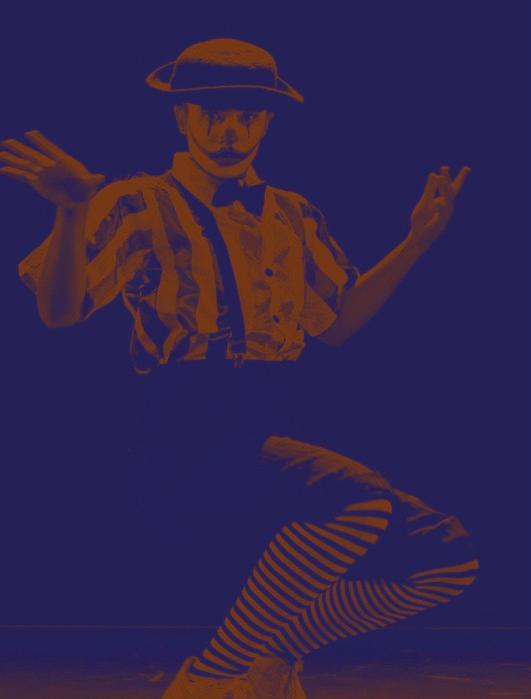
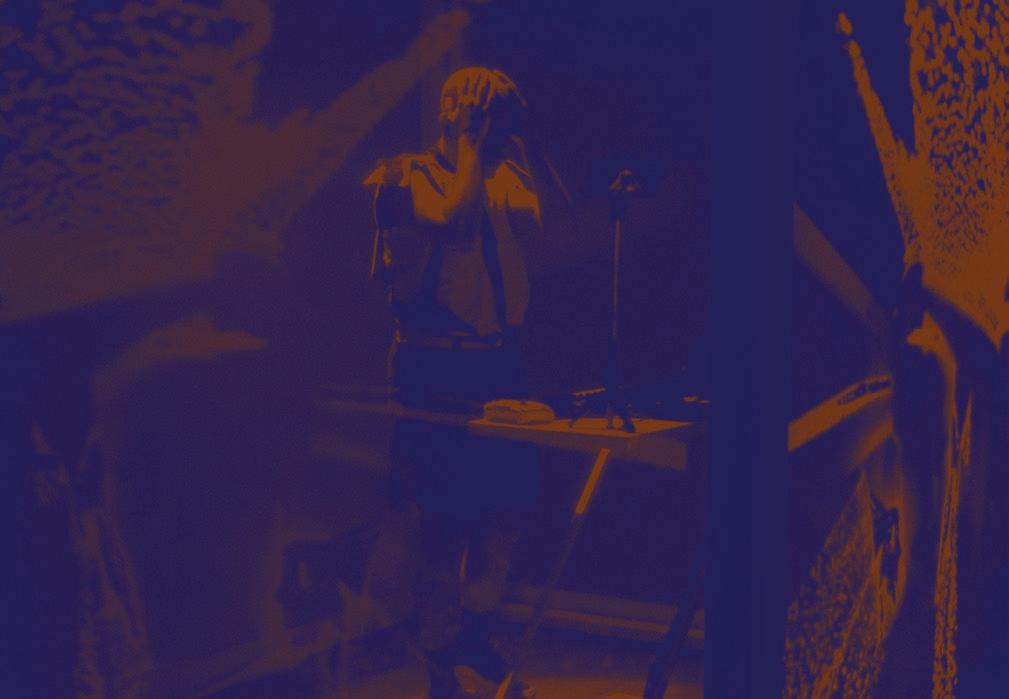
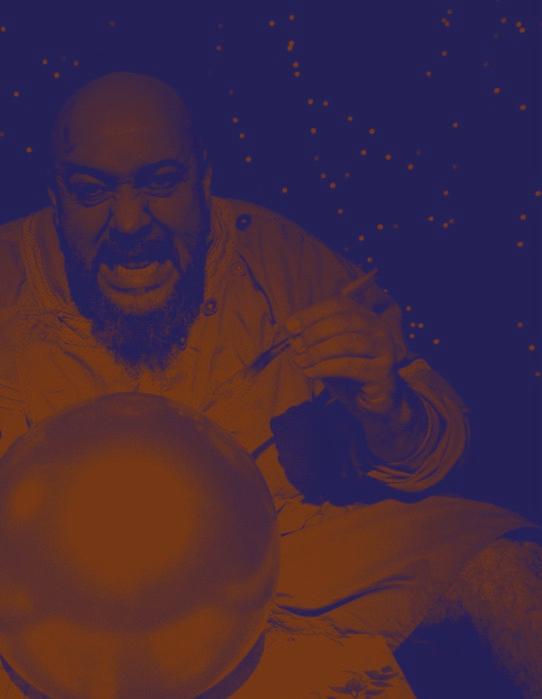


23 FRAGMENTOS DESSES ÚLTIMOS DIAS
23 FRAGMENTS OF THESE LAST DAYS
INSTRUMENTO DE VER E LE TROISIÈME CIRQUE <BRA[DF]/FRA>
32 A FÁBRICA DOS VENTOS
THE WIND FACTORY
TRUPE LONA PRETA <BRA[SP]>
34
A LIFE IN HER DAY –
UMA VIDA NO SEU DIA
HILARY CHAPLAIN <EUA>
36
BIG BANG
BIOLUMINI <BRA[SP]>
38
CAOS – FRAGMENTOS POÉTICOS DO COTIDIANO
CHAOS – POETIC FRAGMENTS OF EVERYDAY LIFE
PAINÉ SANTAMARIA <ARG/BRA[SP]>
40
CIRCO DE LOS PIES
FEET CIRCUS
LA LUNA CIA DE TEATRO <BRA[SC]>
42
COLIBRI – UMA FÁBULA
CIRCENSE LATINO-AMERICANA
HUMMINGBIRD – A LATIN
AMERICAN CIRCUS FABLE
COLETIVO UM CAFÉ DA MANHÃ E CONVIDADOS <BRA[SP]/COL/MEX/PER>
COLETIVO VERTIGEM <BRA[SP]>
CHICO TOLEDO, MAURO COSENZA E THIAGO CAPELLA <BRA[SP/URU]>
ESPETÁCULO
MAURO COSENZA <BRA[SP]/URU>
48
CUIR – COURO LEATHER
ARNO FERRERA E GILLES POLET <BEL> 50
CIA AFUMA <TOG>
FORTE
THREAD CIRCO DE ÉBANOS <BRA[SP]>
HEROLINO, O FAXINEIRO
HEROLINO, THE CLEANER
ERICKSON ALMEIDA <BRA[SP]>
IMMINENCE OF NOW
CIRCAR ARTES DO CORPO <BRA[SC]>
THIAGO ANDREUCCETTI <BRA[SP]> 60
KING KONG FRAN
RAFAELA AZEVEDO <BRA[RJ]> 62
ONDE GUARDO UM SONHO
WHERE I KEEP A DREAM
ADELLY COSTANTINI <BRA[RJ]>
64
ORIRI – A ANCESTRALIDADE ILUMINANDO O PICADEIRO
ORIRI – THE ANCESTRY LIGHTING UP THE CIRCUS TENT
CIA AFUMA, PERNALTAS DO ORUN, TRUPE BAIÃO DE 2 E BLOCO AFRO
ILÚ OBÁ DE MIN <BRA[RJ/SP]/TOG> 66
SOLUS AMOR ONLY LOVE CIA RECIRQUEL <HUN> 68 UM DOMINGO
ON A SUNDAY
PROYECTO MIGRA E GALPÃO DE GUEVARA <ARG> 70
VACÍO - VAZIO
VOID
CIA OMKARA <ALE/COL> 72
YÉ – ÁGUA
WATER
CIRCUS BAOBAB <GUI>

min
Se o mundo está destruído e em pedaços, qual pode ser o próximo passo? Sem buscar respostas definitivas, a obra levanta hipóteses e discussões: afinal, qualquer construção é feita tijolo por tijolo, peça por peça, fragmento por fragmento. “O espetáculo traz para o picadeiro a força e a atualidade de um Brasil que continua, apesar da destruição”, afirma a artista Julia Henning. E se há dor na destruição, ela está representada pelos passos firmados em cacos de vidro em um número de faquirismo. Já os destroços do presente viram objetos de cena.
A narrativa se constrói a partir do conceito de circografia, criado pela diretora do espetáculo, que se baseia na redação ou encenação específica de um espetáculo circense. “É uma
escrita muito fragmentada, onde a trajetória de cada artista se desdobra pouco a pouco”, explica Julia. Além da narrativa que se desenha a partir dos movimentos, objetos e emoções de cada intérprete, há textos sobre momentos históricos do Brasil, sobre situações da vida pessoal dos artistas e sobre o próprio processo de criação, tudo entremeado por números de contorção, acrobacias, aéreos e danças brasileiras, como o passinho carioca e o frevo pernambucano.
O coletivo Instrumento de Ver foi criado em 2002 e tem o processo de criação como fonte de inspiração. Em 2018, o grupo inaugurou o Galpão Instrumento de Ver, espaço multiúso e sede do coletivo em Brasília.
Circography*: Maroussia Diaz Verbèke
Intérpretes-criadores/Creator interpreters: Beatrice Martins, Julia Henning e Maíra Moraes (Instrumento de Ver), André Oliveira, Lucas Maciel e Marco Motta (artistas parceiros)
Assistência de circografia*/ Circography* advisor: Elodie Royer
Direção técnica/ Technical direction: Thomas Roussel
Concepção tecnológica/ Technology conception: Bruno Trachsler
Pesquisa musical/ Music research: Cícero Fraga e Loïc Diaz Ronda
Desenho de luz/ Lighting design: Diego Bresani e Bruno Trachsler

Consultoria cenográfica/ Scenographic advisor: Charlotte Masami Lavault
Operação de som no Brasil/Sound operator in Brazil: João Dimas
Operação de luz no Brasil/Lighting operator in Brazil: Euler Oliveira
Técnica de figurinos/Costume techinique: Emma Assaud
Vídeos/Videos: Cícero Fraga e Luiza Herdy
Fotografias/ Photographs: João Saenger
Arte gráfica/ Graphic design: Bruna Daibert e Lisa Sturacci
Produção no Brasil/ Production in Brazil: Gabriela Onanga, Maíra Moraes e Julia Henning
Comunicação no Brasil/Communication in Brazil: Beatrice Martins e Julia Henning
Comunicação na França/Communication in France: Elodie Royer
Apoio/Support: Institut Français, Embaixada da França no Brasil e LATAM Cargo
Concepção artística/ Concept: Coletivo Instrumento de Ver (BR) e Le Troisième Cirque (FR)
*Circografia n.f. (2015; neologismo de Maroussia Diaz Verbèke em código aberto) 1° Escrita ou direção específica de um espetáculo de circo.
If the world is broken and in pieces, what could the next step be? Without looking for definitive answers, the show raises some hypotheses and discussions: after all, any construction is built brick by brick, piece by piece, fragment by fragment. “The show brings to the stage the strength and currentness of a Brazil that goes on, despite the destruction”, says Julia Henning. And if there is pain in the destruction, it is represented by the steps on shards of glass, in an act of fakirism. The remains of the present, on the other hand, become props for the scene.
The narrative is built from the concept of “circography”, created by the show director, and it is based on the writing of a circus show. “It’s a very fragmented writing, where the
trajectory of each artist unfolds little by little”, explains Julia.
In addition to the narrative that follows the movements, objects and emotions of each performer, there are speeches about historical moments in Brazil, about situations in the personal lives of the artists and about the creative process itself. And there are contortion and acrobatic acts, and Brazilian dances, such as the passinho from Rio and the frevo from Pernambuco.
The collective Instrumento de Ver was created in 2002 and has the creative process as a source of inspiration. In 2018, the group opened the Galpão Instrumento de Ver, a multipurpose place and headquarters for the collective in Brasília.
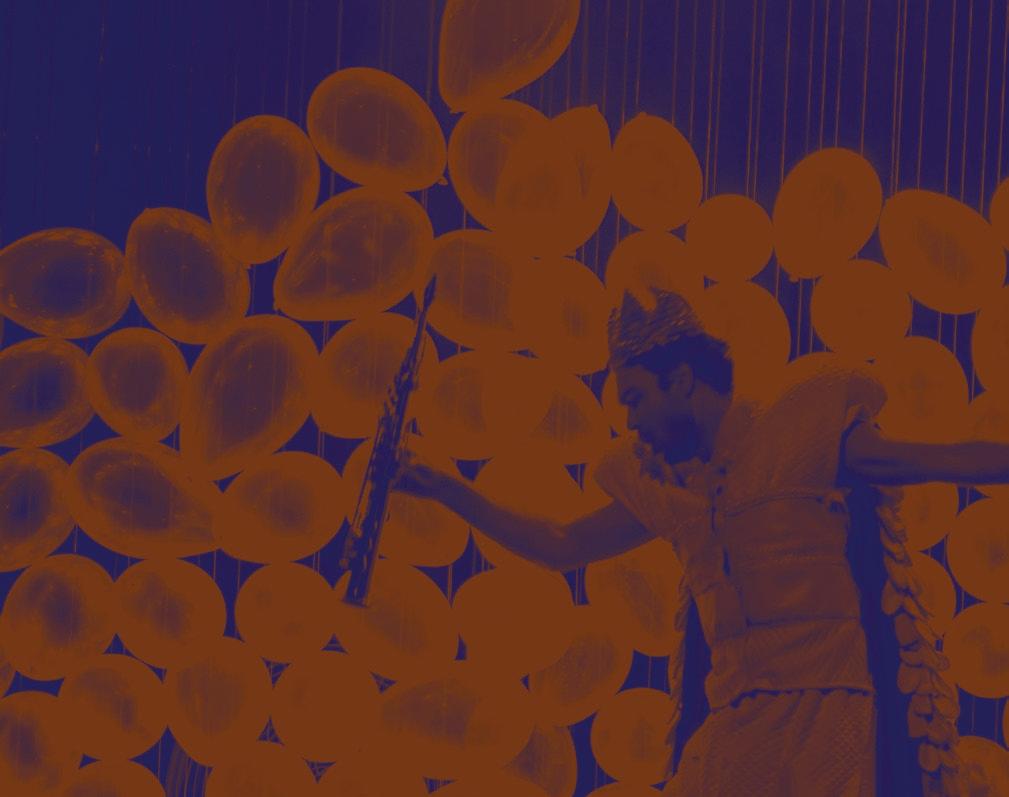
Em um reino não muito distante, o trabalho das pessoas é encher bexigas. Todos os dias, do começo ao fim do expediente, o povo sopra bexiga por bexiga, sem ter acesso a nenhuma delas depois: um soldado as recolhe e leva todas elas para o rei. O problema é que ali as bexigas são tudo que o povo almeja: elas são o sustento, o alimento, o lazer. E se, em algum momento, os trabalhadores perceberem que fazem a parte mais difícil e se recusarem a continuar, sem mudanças nas condições de trabalho?
A narrativa, conduzida por palhaços, destaca a comicidade física. É pelo corpo, pelas imagens e pela música executada ao vivo que os artistas se relacionam entre si e com o público. “Crianças não estão alheias às crises. Elas carecem de acolhimento e
elaborações. Aqui, a trupe aborda a contradição histórica a que estamos submetidos: ter nas mãos a possibilidade real de abundância, que garante a vida de todos na Terra, e a miséria dada pela lógica de produção”, explicam Sergio e Joel Carozzi, atores e diretores do espetáculo.
A Trupe Lona Preta é um coletivo de pesquisa que há 18 anos desenvolve ações na periferia de São Paulo. Composta de artistas que trafegam entre diversas linguagens artísticas, como música, teatro, artes plásticas e cinema, tem como uma de suas principais marcas o diálogo intenso com as classes menos favorecidas da sociedade. L 55 min

In a kingdom not far away, people’s job is to inflate balloons. Every day, from the beginning to the end of the day, workers blow up balloon by balloon, without having access to any of them: a soldier collects and takes them all to the king. But the balloons are everything people could crave for: they are sustenance, food, leisure. What if, at some point, the workers realize that they have done the hardest part and refuse to continue, unless working conditions change?
The narrative, conducted by clowns, highlights the physical comedy. It is through the body, the images and the live music that the artists relate to each other and to the audience. “Children are not immune to crises. They lack acceptance and elaborations. Here, the Troupe approaches the historical
Direção/Direction: Alexandre Matos, Joel Carozzi e Sergio Carozzi
Elenco/Cast: Alexandre Matos, Joel Carozzi, Sergio Carozzi e Wellington Bernado
Direção musical/ Musical direction: Joel Carozzi e Wellington Bernado
Figurino/ Costume design: Laura Alves
Iluminação/ Lighting design: Giuliana Cerchiari
Cenário/Set design: Sergio Carozzi e Joel Carozzi
Produção/Production: Trupe Lona Preta
Produção executiva/ Executive production: Henrique Alonso
Ilustração/ Illustrator: Kei Isogai
contradiction to which we are subjected: having in our hands the real possibility of abundance, which guarantees life to everyone on Earth, and the misery caused by the logic of production”, explain Sergio and Joel Carozzi, actors and directors of the show.
Trupe Lona Preta is a collective that has been developing activities in the most remote neighborhoods of São Paulo for eighteen years. The multi-artists work with music, theater, visual arts and cinema, and one of their main features is the intense dialogue with the underprivileged classes of society.

L 60 min
Parecia um café da manhã como outro qualquer. Mas, de repente, de dentro da caixa de cereais, surge um anel de diamantes. A partir desse fato inusitado, a vida da mulher em cena muda completamente. O anel se transforma em símbolo de noivado, e assim ela imagina o namoro, o futuro casamento, o bebê que chegaria na sequência. E essa vida inteira acontece no tempo de um dia, entre uma refeição e outra, entre a hora de acordar e a de dormir.
A obra é uma comédia-solo sobre a promessa de sermos felizes para sempre ao lado de outra pessoa. Uma mistura de comédia física, teatro de objetos, marionetes e teatro clássico. Quase sem palavras, a narrativa se desenvolve com o uso inventivo de objetos do cotidiano e cria um mundo
imaginário do qual o público participa como testemunha dos eventos.
“O espetáculo não é sobre uma mulher solitária em busca de amor, é sobre uma mulher que cria a vida que deseja”, afirma Hilary Chaplain, palhaça, atriz e criadora do trabalho. Com o A Life in her Day – Uma Vida no seu Dia, dirigido por Avner Eisenberg, Hilary já se apresentou em mais de 20 países. Também atuou na peça The Tempest – A Tempestade, na Broadway e no Teatro Delacorte, em Nova Iorque, e fez parte do elenco do premiado filme Forrest Gump – O contador de histórias, de 1994.

It was like any other breakfast. But suddenly, from inside the cereal box, a diamond ring appears. From that unusual fact, the life of the woman on the stage changes completely. The ring becomes a symbol of engagement, and that’s how she imagines dating an imaginary boyfriend, her future wedding, the baby that would arrive afterwards. And this whole life takes place in the span of a day, between one meal and another, between waking up and falling asleep.
It is a solo show about the promise of being happy forever with someone else. A mix of physical comedy, object theater, puppetry and classical theater. Almost without words, the narrative develops with the inventive use of everyday objects and creates an imaginary world in
Direção/Direction: Avner Eisenberg
Criação, cenografia e figurino/ Creation, set design and costume design: Hilary Chaplain
Iluminador no Brasil/Lighting operator in Brazil: Paulo Souza
Tradução de textos de produção/ Translation: Kênia Cardoso
Produção no Brasil/ Production in Brazil: Márcia Nunes e Bianca Fero
which the audience participates as witnesses of the events.
“This is not a show about a lonely woman looking for love. This show is about a woman who creates the life she wants”, says Hilary Chaplain, clown, actress and the show creator. With A Life in her Day, directed by Avner Eisenberg, Hilary has already performed in more than 20 countries. She also acted in the play The Tempest, on Broadway and at the Teatro Delacorte, in New York, and was part of the cast of the award-winning movie Forrest Gump, in 1994.

Um único ponto muito denso e muito quente. Uma explosão. A origem do espaço-tempo. Se fosse possível sintetizar a origem do universo, essas seriam as principais etapas iniciais. É claro que ninguém tem certeza do que aconteceu há bilhões de anos, mas a teoria do Big Bang é uma das mais aceitas pela comunidade científica até os dias de hoje.
Essa ideia de que no começo tudo era muito quente, quase uma esfera de fogo, é a inspiração para o espetáculo dirigido por Bárbara Francesquine. “Por meio de múltiplas formas de manifestações do fogo, o espetáculo conta as etapas de criação do universo, de forma lúdica e imaginativa”, afirma a artista.
A pirofagia (que é a arte de manipular o fogo) conduz a encenação, combinada a coreografias que envolvem números acrobáticos, de equilíbrio, ilusão e malabarismo. Aos poucos, o fogo se transforma e revela acessórios que são também bambolês, bastões, claves, saias, asas e coroas. A iluminação dada pelas chamas torna cada movimento mais do que especial para quem assiste. A apresentação ainda conta com música ao vivo, feita com instrumentos de percussão.
O coletivo Biolumini tem mais de 20 anos de existência e é especializado em espetáculos pirofágicos. Suas apresentações incluem malabarismo, equilibrismo, acrobacias, figurinos e letreiros com fogo, sendo referência na pesquisa e produção desse tipo de performance no país.

A very dense and very hot spot. An explosion. The origin of spacetime. If it were possible to summarize in a few words the origin of the universe, these would be the main initial stages. Of course, no one is sure what happened billions of years ago, but the Big Bang theory is one of the most accepted by the scientific community.
The idea that in the beginning everything was very hot, almost a sphere of fire, is the inspiration for the show directed by Bárbara Francesquine. “Through multiple forms of fire manifestations, the show talks about the creation of the universe, in a playful and imaginative way”, says the artist.
Pyrophagy (which is the art of manipulating fire) is the star of the
Direção/Direction: Bárbara Francesquine Intérpretes-criadores/Cast: Bárbara Francesquine, Gustavo Ollitta, Isadora Faro, Isis Talismã, Giovana Cattaruzzi e Luisa Crucet
Percussionista/ Percussionist: Flávio Rodrigues
Trilha sonora/ Soundtrack: Alexandre Salomão Iluminação/ Lighting design: Letícia Trovijo Militão
Figurino/ Costume design: Modista Ateliê
Produção executiva/ Executive production: Tatiana Ferraretto
show, combined with choreographies involving acrobatic and balancing acts, illusion and juggling. Gradually, the fire transforms and reveals accessories that are also hula hoops, skirts, wings and crowns. The lighting given by the flames makes each movement more than special for those who watch. The presentation also features live music, made with percussion instruments.
The Biolumini collective was created more than 20 years ago and specializes in shows with pyrophagy. Its performances include juggling, balancing acts, acrobatics, costumes and signs with fire, being a reference in the research and production of this type of performance in the country.

L 40 min
Em Caos – Fragmentos Poéticos do Cotidiano , objetos como roupas, sapatos, chapéus e gravatas criam vida nas mãos da malabarista, que se questiona sobre as repetições dos dias, as obrigações e as máscaras sociais que vestimos cotidianamente.
“Quantas personagens cabem em um guarda-roupa? Quantas combinações criamos? Quando podemos ser nós mesmas?”, questionam Painé Santamaria, idealizadora e intérprete, e Carol Cony, diretora do espetáculo.
O trabalho mescla manipulação de objetos do dia a dia com técnicas de malabarismo clássico, criando imagens que dão ares de fantasia à narrativa. Os movimentos são coreografados e inspirados nos rituais cotidianos e a história dá, a cada
roupa e a cada movimento, intenções e significados diferentes.
“O espetáculo propõe uma crítica à imagem esperada das mulheres. A partir de gestualidades poéticas e movimentos que criam um universo carregado de humor, o espectador é convidado a desestabilizar seu próprio cotidiano”, completam.
Esse é o primeiro espetáculo sem falas criado por Painé Santamaria, que é malabarista, palhaça, musicista e diretora, especializada em malabarismo contemporâneo e espetáculos de rua. Sua marca como artista, presente em suas pesquisas e criações, é a inserção de reflexões sobre sua identidade latino-americana e sobre suas vivências como mulher no meio artístico.
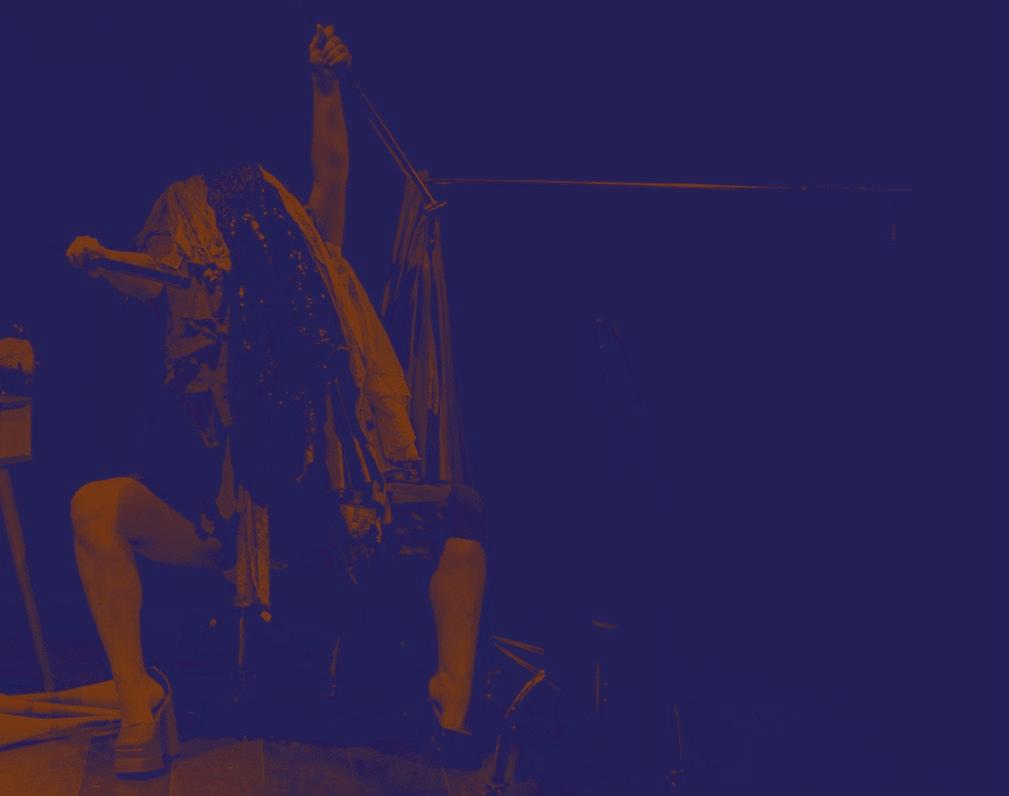
In Chaos – Poetic Fragments of Everyday Life, objects such as clothes, shoes, hats and ties come to life in the hands of the juggler, who questions herself about the repetitions of everyday life, the obligations and social masks we wear on a daily basis. “How many characters fit in a wardrobe? How many combinations did we create? When can we be ourselves?”, ask Painé Santamaria, creator and performer, and Carol Cony, director of the show.
The work mixes manipulation of everyday objects with classic juggling techniques, creating a fantasy aesthetic. The movements are choreographed and inspired by everyday rituals and the story gives each outfit and each movement different intentions and meanings.
Direção/Direction: Carol Cony Dariano
Assistente de direção/Assistant director: Tassio Folli
Cenografia, ideia original e intérprete/Set design, concept and cast: Painé Santamaria
Figurino/ Costume design: Laura Alves
Trilha sonora/ Soundtrack: Tetê Purezempla
Iluminação e operação de luz/ Lighting designer and operator: Serafim do Mundo
Produção/Production: Karina Secco (TocA arT)
“The show proposes a critique of the expected image of women. From poetic gestures and movements that create a universe full of humour, the audience is invited to destabilize its own daily life”, says Painé.
This is the first non-speaking show created by Painé Santamaria, juggler, clown, musician and director, specialized in contemporary juggling and street shows. Her mark as an artist, both in her research and creations, is the insertion of reflections on her Latin American identity and on her experiences as a woman in the artistic world.
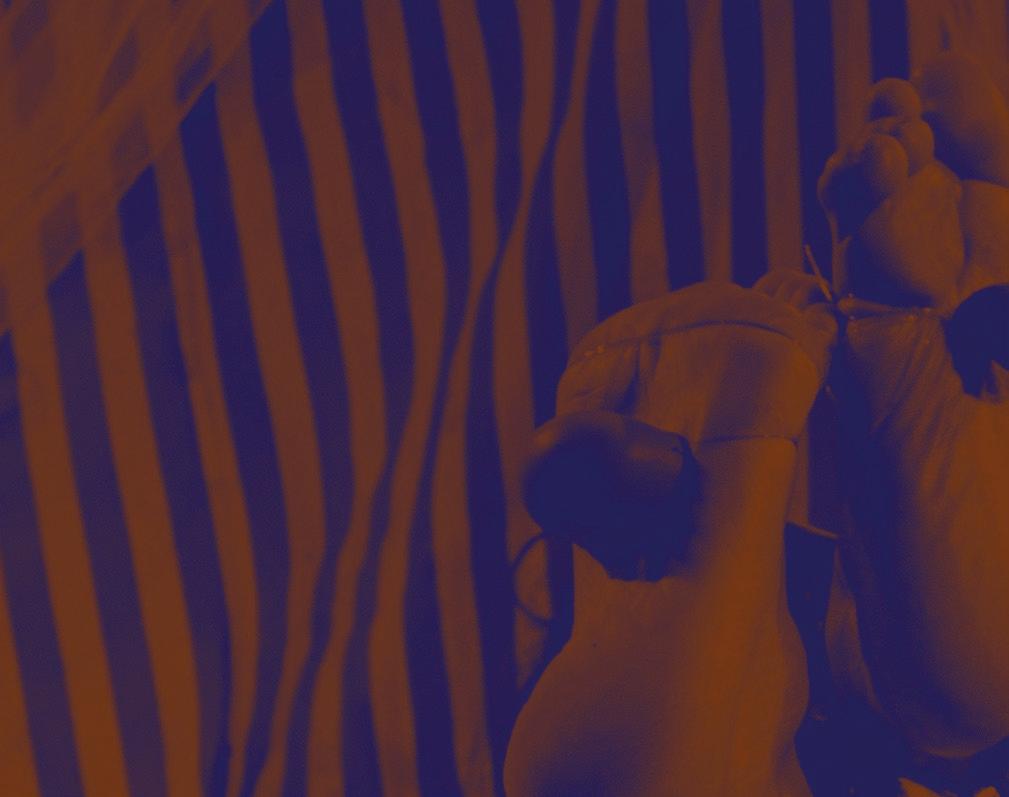
L 35 min
Asmeline é uma palhaça que possui pés e pernas diferentes: Pezão e Pezinho são duas personalidades que dividem um mesmo corpo e assumem as características de duas figuras da palhaçaria clássica, o “branco” (aristocrata que encarna a figura de poder) e o “augusto” (extravagante, provocador).
Ao animar seus próprios pés e os transformar em bonecos, a palhaça abusa da comicidade e de técnicas do teatro de animação. “Também faço acrobacia de solo e aéreos no tecido acrobático, colocando um corpo com deficiência em um lugar de risco, onde não costuma ser visto”, enfatiza Emeli Barossi, palhaça e criadora do espetáculo. Outra das camadas narrativas é a audiodescrição, pensada na concepção do trabalho.
A narrativa conduz o público, de forma lúdica, por questões como acessibilidade e inclusão. “Ressignifica, assim, o papel que corpos diversos ocuparam por muito tempo na história do circo, onde eram ridicularizados ou tratados como aberrações para atrair público”, recorda Emeli.
Fundada em 2016, a La Luna Cia de Teatro é formada por quatro artistas que pesquisam música, cultura popular, palhaçaria e pedagogia teatral, e vem se consolidando nos últimos anos com trabalhos que propõem uma mescla dessas linguagens.
Atuação e concepção/ Cast and concept: Emeli Barossi
Assessoria de direção e audiodescritor/ Assistant director and audio describer: Pedro Torres
Trilha sonora/ Soundtrack: Pedro Torres e Ana Claudia Dal Zot
Iluminação e operação de luz/ Lighting design and operator: Thiago de Castro Leite
Figurino/ Costume design: Adriana Barreto
Cenário/Set design: Adriana Barreto e Emeli Barossi
Assessoria em palhaçaria/ Clowning advisor: Greice Miotello
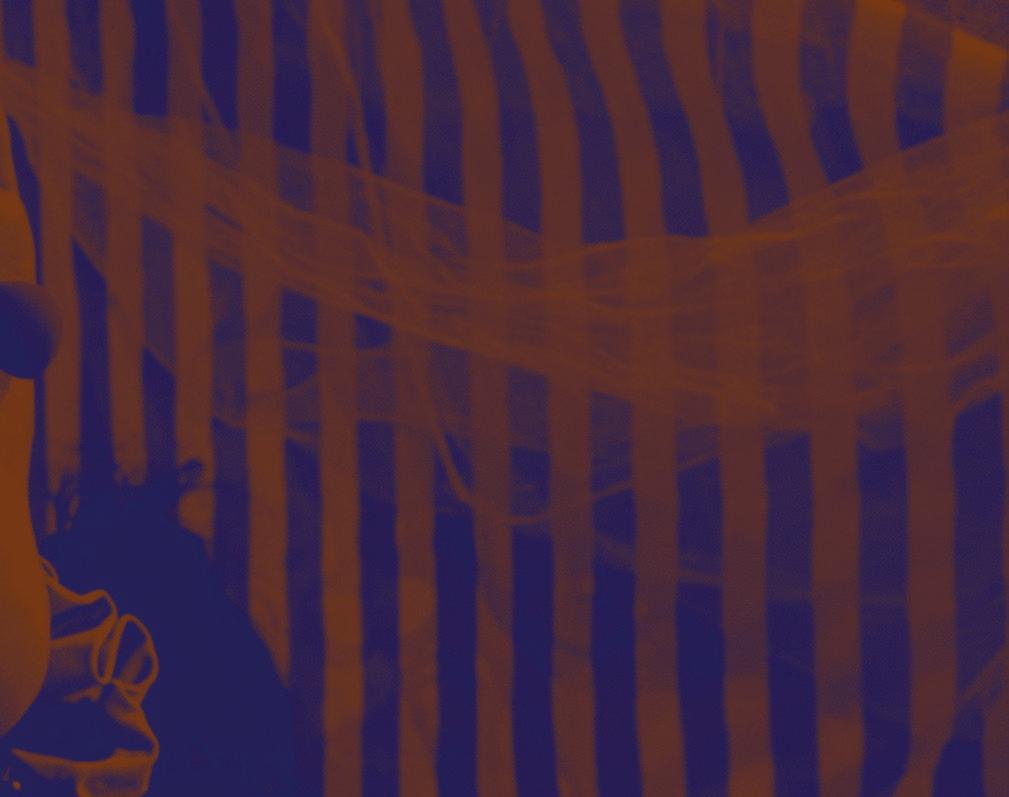
Asmeline is a clown who has two different feet and legs: Pezão (big foot) and Pezinho (little foot) are two personalities that share the same body and take on the characteristics of two classic clown figures, the “white clown” (a powerful aristocrat) and the “auguste” (extravagant, provocative).
By animating her own feet and transforming them into puppets, the clown uses comedy and animation theater techniques. “I also do some acrobatic acts, putting a disabled body in a risky place, where it is not usually seen”, emphasizes Emeli Barossi, clown and creator of the show. Another layer of the narrative is the audio description, envisioned since the conception of the work.
Assessoria circense em acrobacia e aéreo/Acrobatic casting advisor: Potyra Najara
Assessoria em acessibilidade/ Accessibility advisor: A Corda em Si e Suzi Daiane
Produção/Production: La Luna Cia de Teatro
The narrative discusses issues such as accessibility and inclusion in a playful way. “Thus, it gives new meaning to the role that diverse bodies have had for a long time in the history of the circus, where they were ridiculed or treated as aberrations in order to attract an audience”, remembers Emeli.
Founded in 2016, La Luna Cia de Teatro is a collective formed by four artists. They research music, popular culture, clown techniques and theatrical pedagogy, and have been consolidating themselves in recent years with shows that mix these artistic languages.
COLETIVO UM CAFÉ DA MANHÃ E CONVIDADOS
HUMMINGBIRD – A LATIN AMERICAN CIRCUS FABLE

L 60 min
Os colibris, um gênero de beija-flor, são pássaros típicos da América Latina, e os únicos capazes de voar para a frente e para trás. A leveza e a liberdade dessas aves dão o tom do espetáculo, que reúne técnicas de circo, cinema e teatro. A leveza vem dos números aéreos. Já a resistência é representada pela capoeira que se une à roda cyr (grande arco em que o artista se equilibra para girar).
O espetáculo conta com números de mastro chinês, parada de mão (quando o artista fica em posição vertical invertida e equilibra-se com as mãos), força capilar (preso pelos cabelos, o artista apresenta seu número) e corda-bamba, além de utilizar a técnica da máscara larvária (máscaras com formas simplificadas da figura humana). Cada técnica se
relaciona a diferentes aspectos de mitos latino-americanos e com a história de formação desses povos.
“Discutimos o decolonialismo, uma narrativa não usual no circo, a busca de uma identidade latino-americana que, assim como a ave que dá nome ao projeto, vai para frente e para trás na história. Nossos laços são mais fortes que a distância”, afirma Ronaldo Cahin, diretor e roteirista da performance.
O trabalho teve origem em 2020, com o objetivo de criar um espetáculo circense em formato de cinema. Para o projeto, o Coletivo Um Café da Manhã convidou artistas da Colômbia, do México e do Peru, e o processo de pesquisa foi realizado a distância.
Direção e roteiro/ Direction and script: Ronaldo Cahin
Direção técnica/ Technical direction: Daniel Elias
Elenco/Cast: Alba Moncayo, Ana Coll, Christian Triviño, Daniel Elias, Eliara Queiroz, Helder Lacunza, Jose Henry, Jovani Almeida, Laura Lloreda, Paulo Candusso, Paulo Maeda, Tainara Takua e Tania Larrea
Produção circense/ Circus production: Ana Coll
Cenografia/ Set design: Frederico Filippi
Video mapping: Julia Rodrigues e Erre Erre
Trilha sonora/ Soundtrack: DJ PG
Desenho de luz/ Lighting design: Alexandre Zullu

Hummingbirds are typically from Latin America, and the only birds capable of flying forwards and backwards. The lightness and freedom of these birds set the tone of the show, which brings together circus, cinema and theater techniques. The lightness comes from the aerial acts. Resistance, on the other hand, is represented by the capoeira that joins the cyr wheel (a large ring, inside of which the performer stands and moves in order to spin and roll).
The show features Chinese pole acts, handstand (supporting the body in an inverted vertical position by balancing on the hands), hair hanging (the performer presents their act while suspended by their hair), tightrope and larval masks (masks with simplified forms of the human face). Each
Figurino/ Costume design: Tatiana Sélio
Idealização/Concept: Coletivo Um Café da Manhã e Nascedouro Gestão Cultural
Produção executiva/ Executive production: Milena Marques e Elisa Taemi
technique relates to different aspects of Latin American myths, and to the history of the origin of its people.
“We discuss decolonialism, an unusual narrative in the circus, the search for a Latin American identity that, like the bird that gives the project its name, goes back and forth in history. Our bonds are stronger than the distance”, says Ronaldo Cahin, director and screenwriter of the performance.
The project was developed in 2020, with the goal to create a circus show with cinema influences. The Collective Um Café da Manhã invited artists from Colombia, Mexico and Peru, and the research process was carried out remotely.
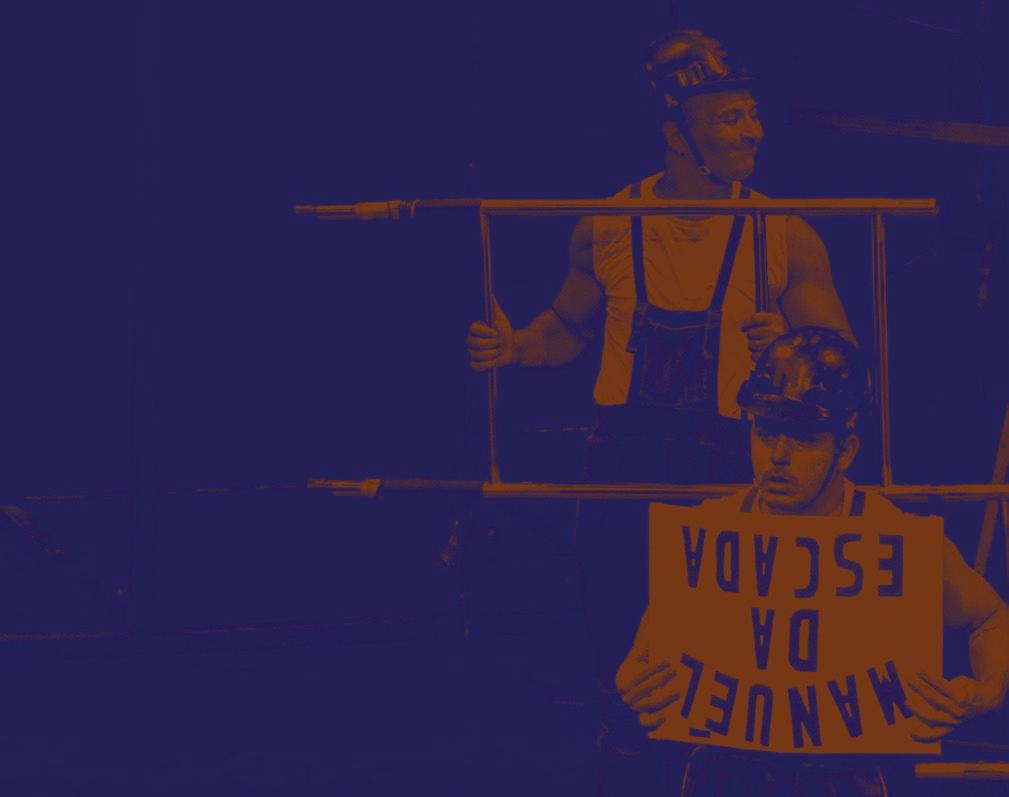
L 50 min
Com o crescimento das cidades brasileiras, é comum que elas pareçam estar sempre em obras. Construções novas para todos os lados, paredes que surgem de um dia para o outro. E são os “construtores” as pessoas que fazem tudo isso acontecer. Esse é o mote do espetáculo do Coletivo Vertigem, que coloca em cena a rotina dos trabalhadores da construção civil, mas com uma diferença importante: como seria o dia a dia deles se todas as suas atividades estivessem permeadas por... circo?
Nesses dias de trabalho dos cinco construtores em cena, o público acompanha números de malabares, de equilíbrio em escada, acrobacias, tecido em gota (uma modalidade de número aéreo em que o artista se
equilibra em um tecido preso em formato de gota) e muita palhaçaria.
A escolha por um cenário de construção civil não é aleatória. Formado em 2020 por artistas circenses que têm mais de 20 anos de carreira, o Coletivo Vertigem tem como foco a pesquisa vertical no aparelho de trampwall (um trampolim instalado junto a uma parede, em que os artistas interagem com o trampolim e com a parede ao mesmo tempo). “Somos o único coletivo no país que se dedica à pesquisa do trampwall, modalidade circense recentemente introduzida no Brasil”, lembra Felipe Oliveira, intérprete e criador do espetáculo. E há mesmo cenas inesquecíveis desses construtores correndo verticalmente pela parede que compõe o cenário.
Direção/Direction: Pablo Nordio
Assistência de direção, roteiro e produção/Assistant director, script and production: Felipe Oliveira
Dramaturgia/ Playwright: Coletivo Vertigem
Intérpretes-criadores/Cast: Felipe Oliveira, Jessika Criolézio, Robson Cruz, Ítalo
Tapia e Matheus Davi
Trilha sonora/ Soundtrack: Rodrigo Marconato Zanettini
Desenho e operação de luz/Lighting designer and operator: Dodô Giovanetti
Operação de som/ Sound operator: Heberth Felipe
Figurino/ Costume design: Alessandro Marques
Fotografias/ Photographs: Melissa Haidar
Confecção da parede de trampwall/ Trampoline: Márcio Tápia

With the growth of Brazilian cities, it is common for them to always seem to be under construction. New constructions everywhere, walls that appear from one day to the next. And the “builders” are the people who make it all happen. The Coletivo Vertigem shows the routine of civil construction workers, but with an important difference: what would their daily lives be like if all their activities were permeated by... circus?
During workdays of the five builders on stage, the audience sees juggling and balancing acts, acrobatics, aerial silks (aerial acts in which the artist performs on a fabric attached in the shape of a drop) and lots of clowning.
The choice for a civil construction scenery is not random. Created in 2020 by circus artists with more than 20
years of career, Coletivo Vertigem focuses on vertical research in the trampwall (a trampoline installed next to a wall, in which artists interact with the trampoline and the wall around it at the same time). “We are the only collective in the country dedicated to trampwall research, a circus modality recently introduced in Brazil”, remembers Felipe Oliveira, performer and creator of the show. And there are unforgettable scenes of these builders running vertically along the wall that makes up the scenery.
INSTALAÇÃO
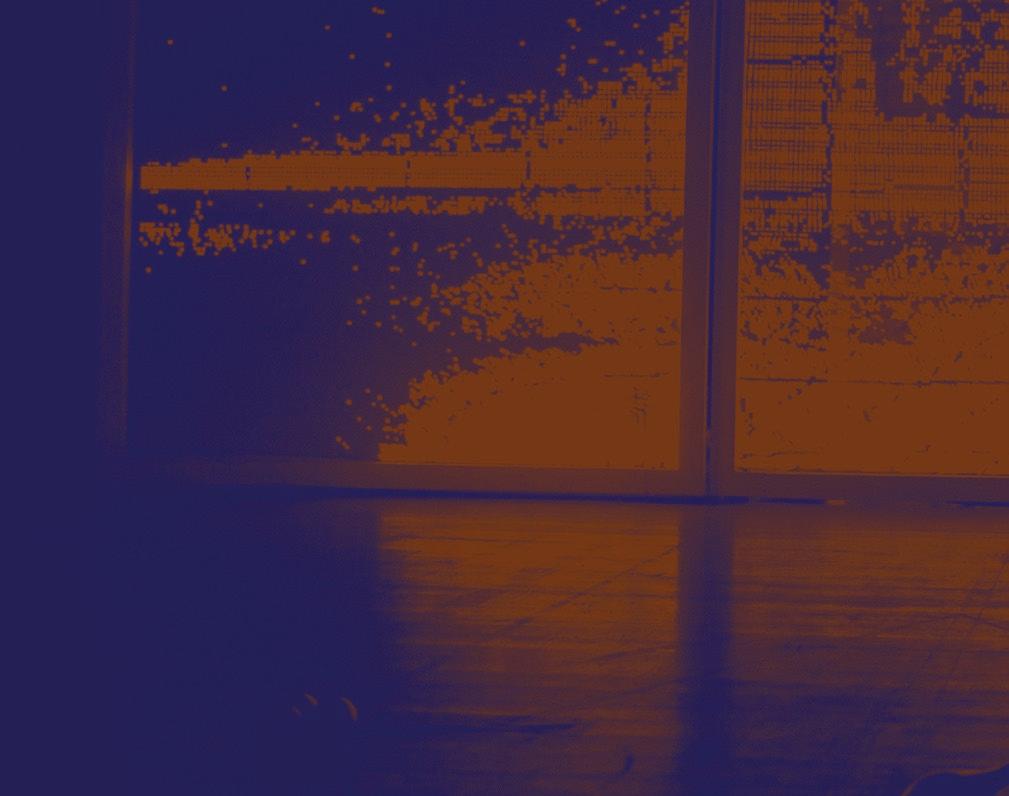
L 25 min
É possível fazer circo fora dos palcos e picadeiros? Na instalação interativa Ctrl + Z, uma experiência inédita no Brasil, os universos físico e digital se unem como possibilidades de experimentação artística e permitem que o público tenha seu momento de brilhar no palco, brincando de ser artista e de fazer circo. Se na vida não é possível desfazer algo que já aconteceu, nas plataformas tecnológicas o Ctrl + Z é nossa possibilidade de voltar atrás.
“A ideia surgiu durante a pandemia da covid-19, quando o contato ficou bastante restrito. A atividade, então, propõe um jogo lúdico com a tecnologia, resgatando nossa fisicalidade”, afirmam Chico Toledo, Mauro Cosenza e Thiago Capella, criadores da exposição.
Nesse jogo interativo entre corpo e máquina, sensores de movimento captam as ações dos participantes, criando imagens da manipulação de objetos físicos e virtuais, com efeitos projetados em tempo real. Diariamente, a instalação também será ativada com apresentações ao vivo do artista Mauro Cosenza.
Destinada a todos os públicos, a atividade foi idealizada pelos artistas Mauro Cosenza, Thiago Capella e Chico Toledo. Mauro Cosenza é multiartista especializado em artes circenses. Sua linha de pesquisa vincula malabarismo, dança e humor. Thiago Capella é artista visual, especializado em tecnologias digitais. E Chico Toledo é músico, sonoplasta, cineasta e jornalista cultural.
Intérprete criador, arte digital e desenho interativo/ Concept, cast and digital art: Mauro Cosenza
Direção cênica/ Scenic director: Alisson Araújo
Trilha sonora/ Soundtrack: Bruno Tognola e Chico Toledo
Processamento de vídeo em tempo real/ Real-time video processing: Thiago Capella
Cenografia e figurino/Set and costume design: Rafaela Santos
Cenotecnia/ Scenotechnics: Alicio Silva
Sonoplastia/ Sound design: Bruno Tognola, Chico Toledo e Mauro Cosenza
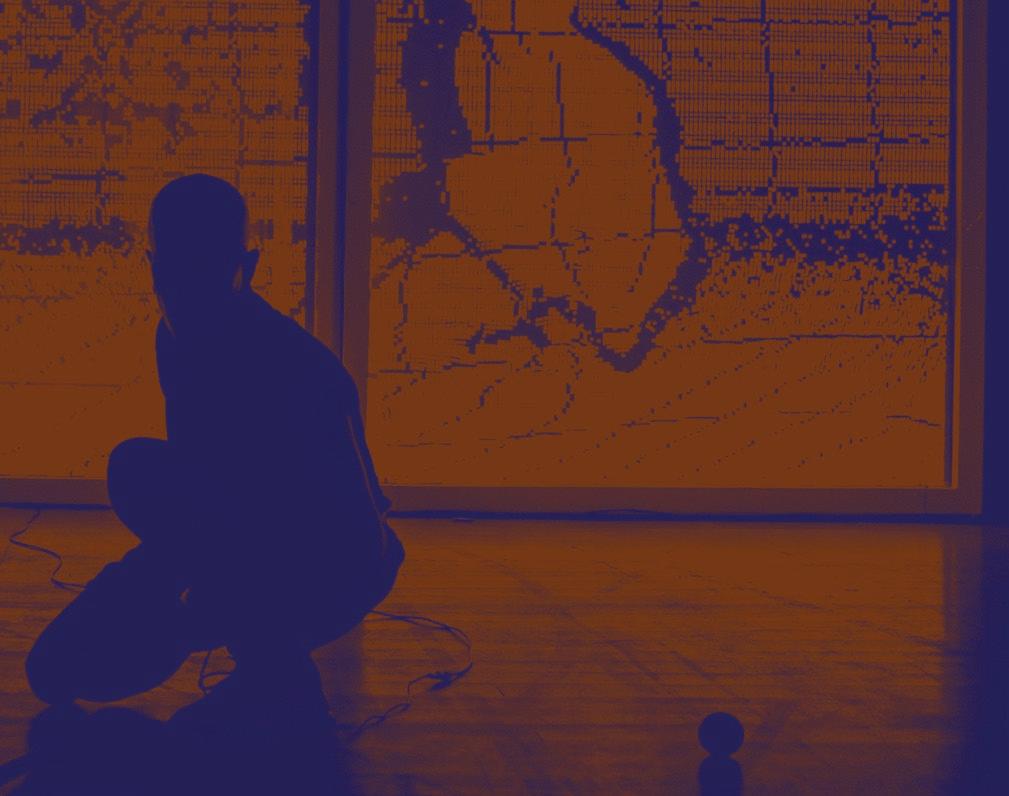
Is it possible to do circus outside the stages and the circus rings? In the interactive installation Ctrl+Z, an unprecedented experience in Brazil, the physical and digital universes come together as possibilities for artistic experimentation and allow the audience to have their moment to shine on stage, playing at being an artist and doing circus. If it is not possible to undo something that has already happened in real life, the Ctrl+Z is our possibility to go back on technological platforms.
“The idea came up during the Covid-19 pandemic, when contact with other people was very restricted. The activity, then, proposes a playful game with technology, rescuing our physicality”, say Chico Toledo, Mauro Cosenza and Thiago Capella, creators of the exhibition.
Produção executiva e recursos tecnológicos/ Executive production and digital resources: Circulus Ópera
In this interactive game between body and machine, motion sensors capture the participants’ actions, creating images of the manipulation of physical and virtual objects, with effects being projected in real time. The installation will also be activated daily with live performances by the artist Mauro Cosenza.
Aimed at all audiences, the activity was conceived by artists Mauro Cosenza, Thiago Capella and Chico Toledo. Mauro Cosenza is a circus multi-artist. His research links juggling, dance and humour. Thiago Capella is a visual artist, specialized in digital technologies. And Chico Toledo is a musician, sound designer, filmmaker and cultural journalist.

45 min
Como seria um relacionamento em que não fosse almejado o poder sobre o outro, mas sim o poder junto com o outro? Com tom intimista e flertando com o erotismo, Cuir – Couro é um dueto sobre as noções de tração e atração. Os dois homens em cena manipulam o corpo um do outro em uma luta consensual formada por belas cenas acrobáticas, em meio ao que parece ser um relacionamento que abarca intimidade, gentileza e ferocidade na mesma medida.
“No espetáculo, enfrentamos os aspectos tóxicos da virilidade para abrir um espaço de discussão sobre intimidade e fragilidade”, afirma Arno Ferrera, diretor artístico do trabalho e um dos circenses em cena. Os figurinos são inspirados em arreios de couro, como os usados
INÉDITO NAS AMÉRICAS
por cavalos, e são fundamentais na composição dos movimentos. Em diversas cenas, um corpo é levantado pelo outro e movimentado apenas com a fixação das mãos no arreio. “Durante a criação, entrevistamos pessoas que trabalham no campo e aram a roça com seus cavalos, e as discussões a partir desses encontros inspiraram o trabalho”, lembra Arno.
No palco, a formação como dançarino contemporâneo e professor de ioga de Gilles Polet e a formação de ginasta de Arno Ferrera criam uma linguagem específica para o show. “Do ponto de vista técnico ou narrativo, nos afastamos da forma usual de se fazer circo contemporâneo. Mas será que há apenas uma maneira de escrever circo?”, finaliza Arno.
Direção artística/ Direction: Arno Ferrera
Criação/Concept: Arno Ferrera, Mika Lafforgue e Gilles Polet
Intérpretes/Cast: Arno Ferrera e Gilles Polet
Olhar externo/ Outside perspective: Paola Rizza
Olhar coreográfico/ Choreographic perspective: Benjamin Kahn e Gilles Polet
Olhar sonoro/ Sound perspective: Amaury Vanderborght
Criação de luz/ Lighting design: Florent Blanchon
Técnico de luz e som/Lighting and sound operator: Pierre-Jean Faggiani
Artesanato de adornos/Adornment: Jara Buschhoff

Concepção de figurinos/ Costume design: Jennifer Defays
Produção/Production: Anaïs Longiéras
Administração/ Administration: Les Halles de Shaerbeek
Produção da companhia/ Cuir’s production: Un loup pour l’homme e Alexandre Fray
Produção no Brasil/ Production in Brazil: Fernanda Vilela (Equi|ibre)
Fotografias/ Photographs: Valérie Frossard
Vídeo/Video: Romain Vennekens
Imprensa/Press: Estelle Laurentin
Grafismo/Graphism: Ekta
Coprodução/ Co-production: Le Bateau Feu, SN de Dunkerque (FR), Theater op De Markt, Dommelhof (BE), Larural, Créon (FR), Festival Perspectives e Sarrebrück (DE)
Apoio/Support: Wallonie-Bruxelles International
How would a relationship be in which shared power is more important than power over the other? With an intimate tone and flirting with eroticism, Cuir – Leather is a duet about the notions of traction and attraction. The two men on stage manipulate each other’s bodies in a consensual fight formed by beautiful acrobatic scenes, in the midst of what seems to be a relationship that embraces intimacy, kindness and ferocity in equal measure.
“In the show, we face the toxic aspects of virility in order to open a space for discussion about intimacy and fragility”, says Arno Ferrera, the show artistic director and performer. The costumes are inspired by leather harnesses, like those used by horses, and are fundamental in the composition of the movements. In many scenes,
one body is lifted by the other and moved only by fixing the hands on the harness. “During the creative process, we interviewed people who work in the fields and plow the fields with their horses, and the discussions that emerged from these meetings inspired the work on stage”, recalls Arno.
On stage, Gilles Polet’s training as a contemporary dancer and yoga teacher and Arno Ferrera’s training as a gymnast create a specific language for the show. “From a technical or narrative point of view, we deviated from the usual way of doing contemporary circus. But is there only one way to make circus?”, concludes Arno.
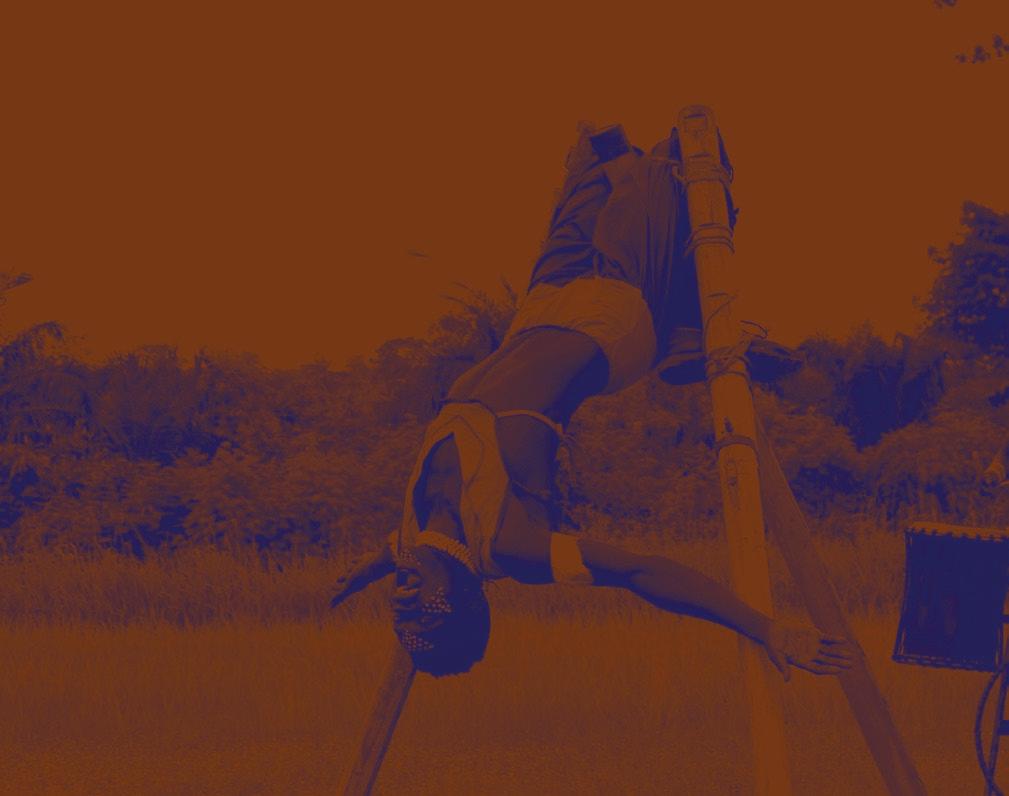
L 30 min
Afuma é o nome de uma samambaia africana que cresce agarrada a troncos de madeira, sem nunca tocar o chão. No Togo, nação da África Ocidental situada no Golfo da Guiné, a planta simboliza o andador, os caminhantes, os homens que nunca caem. É de lá que vêm os artistas circenses de Edukikan – Coração Valente, que se equilibram em pernas de pau a mais de três metros de altura do solo enquanto dançam, lutam e fazem as pazes, criando uma atmosfera frenética de movimento.
Durante o espetáculo, os três pernaltas montam figuras acrobáticas diversas, adaptando suas tradições togolesas de equilíbrio em pernas de pau às técnicas mais usadas no circo contemporâneo. “As figuras foram imaginadas em conjunto e levaram
meses de trabalho para se concretizarem”, lembra Jean Louis Jaeger, também conhecido como Mr. Victor, produtor e cofundador da Cia Afuma. Os números, que também incluem cenas de malabarismo, ocorrem ao som de música ao vivo, com ritmos percussivos de diferentes regiões do Togo e de outros países.
Pertencentes a famílias de pernaltas, os fundadores do grupo foram treinados por mestres tradicionais antes de estudarem as técnicas do circo contemporâneo. Nos últimos anos, realizaram apresentações em diversos festivais artísticos de países africanos e europeus, e esta é a primeira vez do grupo no Brasil.

Afuma is the name of an African fern that grows clinging to wooden trunks, without ever touching the ground. In Togo, a West African nation located on the Gulf of Guinea, the plant symbolizes the walker, the men who never fall. That’s where the artists of Edukikan – Brave Heart come from. In the show, they balance on stilts more than three meters above the ground while dancing, fighting and making peace, creating a frenetic atmosphere of movement.
Throughout the show, the three waders assemble different acrobatic figures, adapting their Togolese traditions of balancing on stilts to contemporary circus techniques. “The figures were created collectively and took months of work to come true”, recalls Jean Louis Jaeger, also known as Mr.
Direção Geral/ General Direction: Jean Louis JaegerMr. Victor
Músicos percussionistas/ Percussionists: Krol Aymeric e Tchala Kossi
Elenco/Cast: Apedo Kossi Marcellin, Ayena Kassegne Kossi e Kinglo Tchoagnimoan Honore
Pesquisa de trilha sonora/Music research: Coletivo Afuma
Produção/Production: Francesco Leonetti
Produção no Brasil/ Production in Brazil: Bel Toledo
Victor, producer and co-founder of Cia Afuma. The acts, which also include juggling scenes, take place to the sound of live music, with percussive rhythms from different regions of Togo and other countries.
Belonging to families of waders, the founders of the group were trained by traditional masters before studying contemporary circus techniques. In recent years, they have performed at various artistic festivals in African and European countries, and this is the group’s first time in Brazil.

Em cena, artistas negros tecem a dramaturgia a partir das narrativas de seus próprios corpos. Ao mesmo tempo que buscam a si mesmos, condensam-se no coletivo.
São oito as representações: a força do leão como possibilidade de alcançar os objetivos; a música como recuperação; a dança como superação; a maternidade como força motriz; a ancestralidade, costura de inteligências físicas e sociais; o circo, ferramenta de inserção social; as questões de gênero e de raça, potências para quebra de padrões; e o poder das conexões.
“Quinta produção da companhia, Fio Forte é a linha que liga a expressão da alma com a liberdade de pensamento”, afirma Bel Toledo, produtora executiva da companhia.
Primeiro grupo circense de artistas negros do estado de São Paulo, formado em 2007, o Circo de Ébanos ainda traz ao palco números que mesclam referências do circo de lona com tendências contemporâneas, passando por contorcionismo, acrobacia e paradas de mão (em posição vertical invertida, o artista se equilibra com as mãos). L 50 min
Os fios fortes inspiram desde a criação dos figurinos, produzidos artesanalmente com fios, criando tranças variadas, até um número inédito. “Poucos artistas brasileiros realizam o ‘multi cordes’, número coletivo em que os artistas se entrelaçam aos fios de uma cortina e ficam presos apenas pelo pé ou pela mão, enquanto apresentam suas habilidades”, explica Bel.
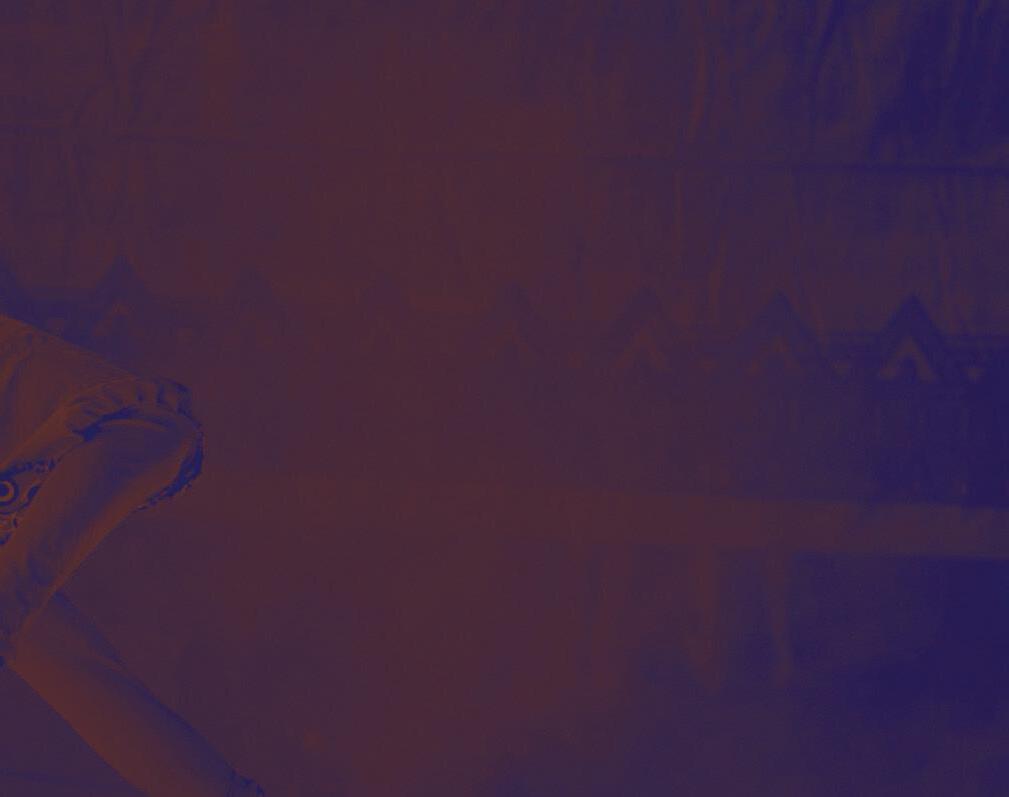
On stage, black artists use their own bodies to create the dramaturgical narrative of the show. At the same time that they search for themselves, they focus on the collective.
There are eight representations: the strength of the lion as a possibility of achieving goals; music as recovery; dance as resilience; motherhood as a driving force; ancestry that blends physical and social intelligence; the circus, a tool for social insertion; gender and race issues, powers to break standards; and the power of connections.
“The company’s fifth production, Strong Thread connects the soul’s expression with freedom of thought”, says Bel Toledo, executive producer of the company.
Direção/Direction: Kelson Barros Wangles
Intérpretes-criadores/Cast: Bruna Viana, Jacqueline Gomes, Lais Dantas, Mateus Santos, Simone Santos, William Kreff e Wesley Peixinho
Direção de movimentos circenses/Direction of circus movements: Mônica Ala
Iluminação/ Lighting design: Dedê Ferreira
Rigger: Dennis Inoue
Produção executiva/ Executive production: Bel Toledo
The strong threads inspire the creation of costumes — handcrafted with threads, creating varied braids — and an unprecedented act. “Few Brazilian artists perform the ‘multi cordes’, a collective act in which the artists intertwine with the threads of a curtain and are held only by the foot or by the hand, while they show their skills”, explains Bel.
The first circus group of black artists in the state of São Paulo, created in 2007, Circo de Ébanos still brings to the stage acts that mix references from the traditional circus with contemporary trends, including contortionism, acrobatics and handstands (supporting the body in an inverted vertical position by balancing on the hands).
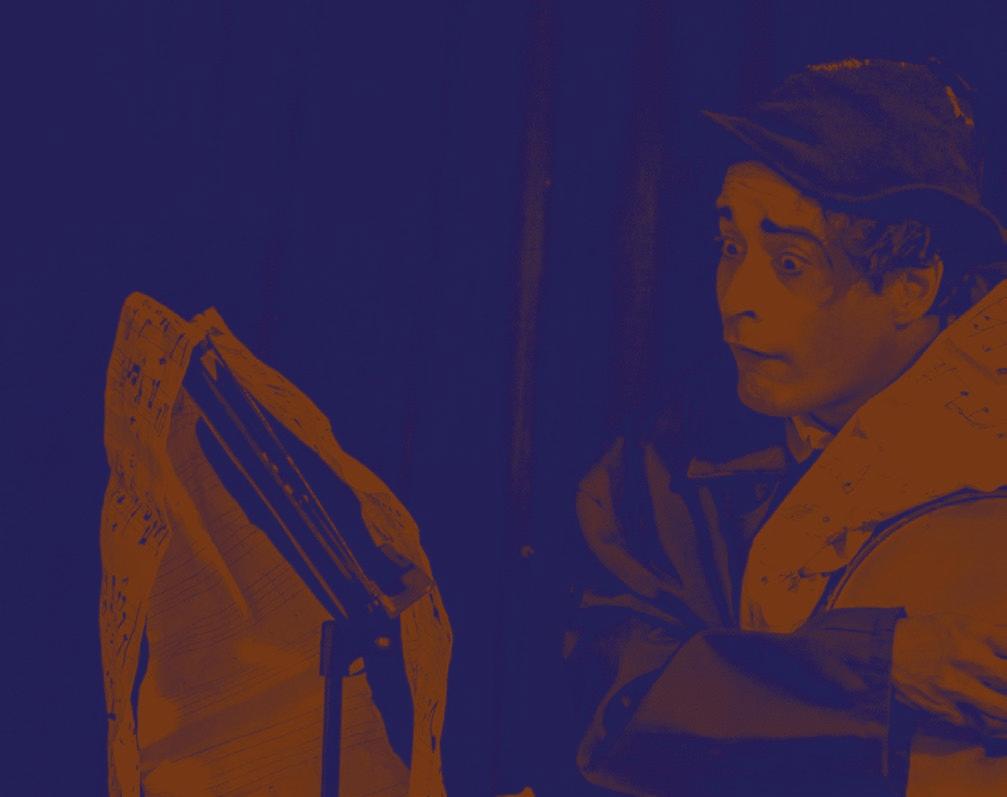
L 45 min
Um faxineiro começa a trabalhar no circo. Encantado com o que vê à sua volta e percebendo que está sozinho no picadeiro, se deixa levar pela imaginação e brinca de ser artista.
A vassoura, o balde e o espanador de pó se transformam em malabares, a faxina é seu show circense. “Em Herolino, o Faxineiro, a construção cênica passa pelo olhar do palhaço que, de forma lúdica, cômica e genuína convida o público a se conectar com o estado do brincar e a embarcar na história. Quão interessante e divertido pode ser o cotidiano quando ressignificamos nosso olhar sobre ele?”, pontuam Erickson Almeida e Ronaldo Aguiar, palhaço e diretor do espetáculo.
A comicidade física dá o tom da narrativa, que se constrói na tentativa
do palhaço de realizar alguma virtuose, rindo das próprias dificuldades. Apesar de ter como fio condutor o palhaço, o trabalho também apresenta números de equilibrismo, malabarismo, acrobacia de solo e música.
Erikson Almeida é um multiartista, formado pela Escola Nacional de Circo e pelo Programa de Formação de Palhaços para Jovens dos Doutores da Alegria. Herolino, o Faxineiro é resultado de sua pesquisa de mais de dez anos sobre comicidade física e palhaçaria clássica.

A cleaner starts working at the circus. Delighted with what he sees around him and realizing that he is by himself in the stage, he imagines how it would be being an artist. The broom, the bucket and the mop become jugglers, the cleaning is their circus show. “In Herolino, the Cleaner, the scenic construction passes through the eyes of the clown who, in a playful, comical and genuine way, invites the audience to connect with the state of playing and to embark on the story. How interesting and fun can everyday life be when we reframe our view of it?”, point out Erickson Almeida and Ronaldo Aguiar, clown and director of the show.
Physical comicity sets the tone of the narrative, which is built on the clown’s attempt to perform some virtuosity, laughing at his own
Direção/Direction: Ronaldo Aguiar
Roteiro/Script: Erickson Almeida e Ronaldo Aguiar
Elenco e trilha
sonora/Cast and soundtrack: Erickson Almeida
Cenário/Set design: Maria Zuquim
Figurino/ Costume design: Cleuber Gonçalves
Fotografias/
Photographs: Ariane Artioli
Coordenação de palco/Stage manager: Geisa Helena
Coordenação de produção/Production coordinator: Cristiani Zonzini
difficulties. Despite having the clown as a guiding principle, the work also features balancing acts, juggling, acrobatics and music.
Erikson Almeida is a multi artist, formed by the Escola Nacional de Circo and by the Clowns Training Program for Young People of Doutores da Alegria. Herolino, the Cleaner is the result of more than ten years of research into physical comedy.

50 min
Iminência do Agora propõe uma suspensão do tempo. Se, na vida cotidiana, é comum nos perdermos em pensamentos sobre como será o futuro ou sobre tudo que já foi vivido, aqui o objetivo é estar presente em cada gesto. Mais do que uma proposta, a atenção se torna necessidade, já que sem ela o risco se impõe: uma única distração pode ser fatal quando, em cena, uma grande tora de madeira gira continuamente, por exemplo.
Para Adilso Machado, diretor artístico do grupo, o risco é fator fundante de suas criações. “Temos inclusive um jogo, o ‘Flertar com o Risco’, desenvolvido e utilizado pelo grupo, que envolve objetos, espaço, som, elenco e plateia. O objetivo não é vencer: é estar em estado de atenção o tempo todo, mas flertando com o risco, com
os medos, os limites e seus desencadeamentos”, revela.
O interessante é que, ao focar o olhar, também é possível ver o que não se via antes: o outro. Em um espetáculo que traz influências do circo e da dança, as situações rotineiras são abordadas de forma crítica, discutindo como a urgência do tempo e o modo caótico como o ser humano costuma lidar com ele influenciam os corpos e suas relações com o presente.
Em atividade desde 2016, a companhia propõe releituras do próprio fazer circense que, ao buscar possibilidades de perguntas e respostas no corpo, também se torna capaz de provocar questionamentos sobre o mundo atual.
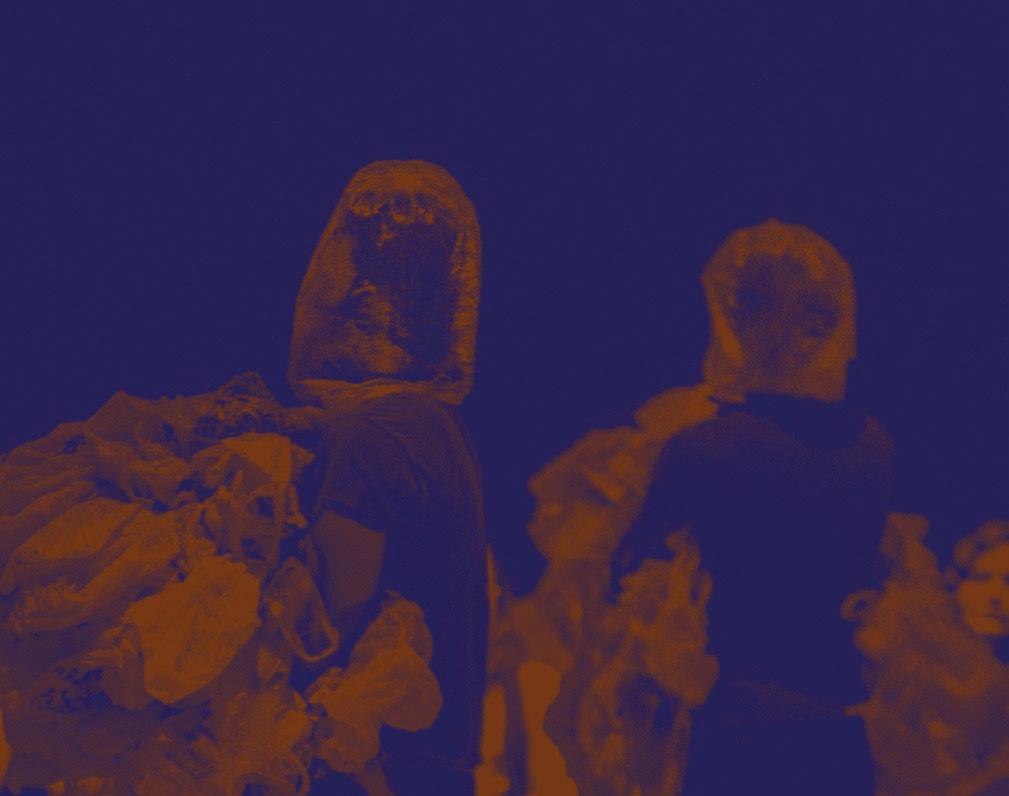
Imminence of Now proposes a suspension of time. If, in everyday life, it is common to get lost in thoughts about what the future will be like or about everything that has already been experienced, here the goal is to be present in each gesture. After all, attention becomes a necessity, since without it the risk is imposed: a single distraction can be fatal when, on stage, a large log of wood rotates continuously, for example.
For Adilso Machado, artistic director of the group, risk is a founding factor in their creations. “We even have a game, Flertar com o Risco (flirting with risk), developed and used by the group, which involves objects, places, sound, cast and audience. The objective is not to win: it is to be in a state of attention all the time, but flirting
Direção artística/ Artistic director: Adilso Machado
Elenco e criação/ Cast and concept: Adilso Machado, Bianca Vieira, Eduarda Heinen, Felipe Quérette, Luiza Z, Otero e Sanara Schusler
Design de luz/ Lighting design: Irani Brunner
Consultoria de figurino e produção/ Costume advisor and production: Karin Serafin
Auxiliar de montagem/ Stage assistant: Thiago Solla Schmitz
Projeto gráfico/
Design: Felipe Quérette e Diogo Vaz Franco
Fotografias/ Photographs: Cristiano Prim e Gabriel Stella
Produção/Production: Karin Serafin
with risk, with fears, limits and their triggers”, he reveals.
The interesting thing is that, when focusing the gaze, it is also possible to see what was not seen before: the other. In a show that brings influences from circus and dance, day to day situations are approached critically, discussing how the urgency of time and the chaotic way in which human beings tend to deal with it influence bodies and their relationships with the present.
Created in 2016, the company proposes new thoughts about circus: by seeking the body for new possibilities, questions and answers, the circus becomes capable of provoking questions about the current world.
ITHACA THIAGO ANDREUCCETTI <BRA[SP]>
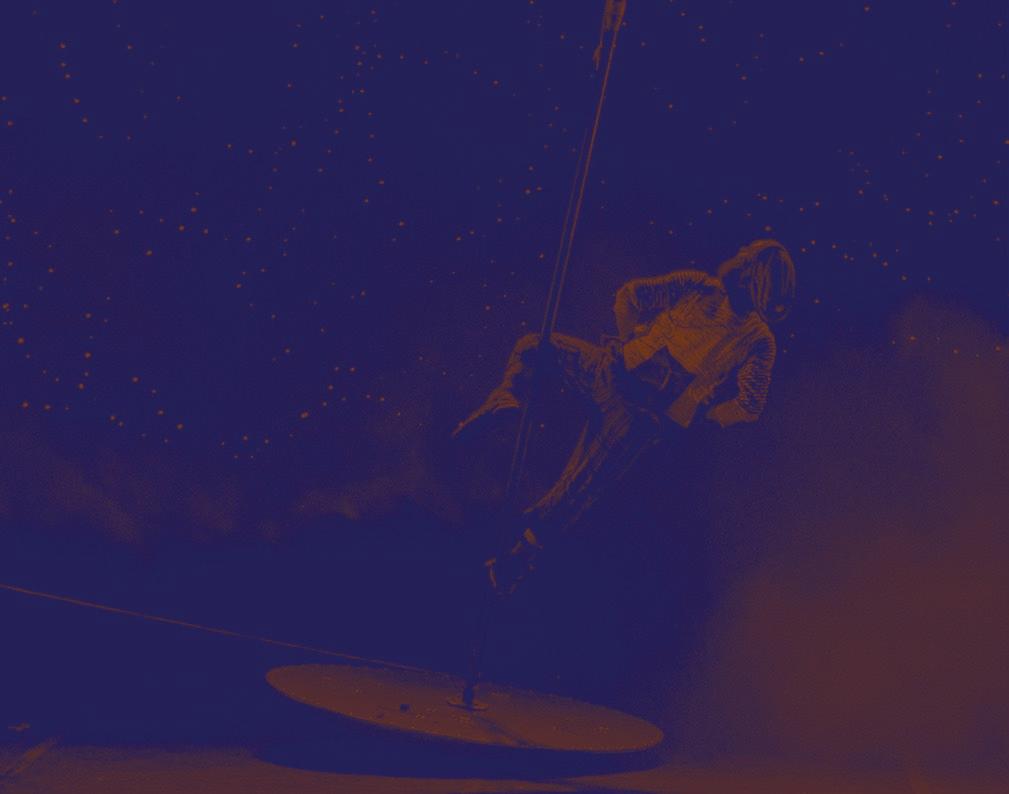
Diz a mitologia grega que Ítaca foi a terra natal de Ulisses, rei que viveu por décadas viajando a bordo de um navio. Aqui, Ítaca é também o nome do pequeno barco-casa onde vive o palhaço Santiago, até o dia em que uma tempestade o leva a uma ilha deserta. Lá, as urgências da vida se traduzem em gestos, rabugices e sonhos desse marinheiro solitário perdido em alto-mar. O trabalho começou a ser criado em 2020, no auge da pandemia da covid-19, então “questionamentos humanos como morte, saudade, medo e confinamento fazem parte do DNA da peça e se expressam de maneira simbólica e poética através do palhaço”, explica Thiago Andreuccetti, artista e idealizador do espetáculo, que
utiliza técnicas de teatro físico na composição do personagem.
Além da palhaçaria e do improviso, a narrativa se constrói a partir de experimentações com o uso do mastro sem base fixa, apoiado em uma estrutura que lembra uma bola cortada ao meio: o mastro é o barco-casa, adaptado para que o público tenha a ilusão de uma embarcação no oceano, se movendo pelo ritmo das ondas.
Thiago Andreuccetti começou a construção de Ítaca após dois anos excursionando pelas Américas como palhaço do Cirque du Soleil. Formado em 2006 pela Fundação das Artes, em São Caetano do Sul (SP), sempre estudou técnicas de teatro que abordam o corpo como ferramenta de expressão.
Direção/Direction: Luciana Viacava
Idealização, atuação e coordenação geral/ Concept, acting and coordination: Thiago Andreuccetti
Dramaturgia/ Playwright: Nereu Afonso da Silva
Trilha sonora/ Soundtrack: Alexandre Maldonado
Concepção de luz/ Lighting design: Giuliana Cerchiari
Técnica e operação de luz/Lighting operator: Ana Matie
Técnico de som/ Sound operator: Cic Morais
Criação, contrarregra e sonoplastia/Creative collaboration, stage and recorded voices: Ivy Donato


Construção do mastro cubulto/Construction of the mast: Cenografia
Sustentável, Evas
Carreteiro e Art&Solda
Mastro/Mast: Gaia Pole
Adereços/Props: Tetê Ribeiro e Ivy Donato
Sombras/Shadows: Lucas Luciano
Figurinos/ Costume design: Marichilene Artisevskis
Costureira/ Dressmaker: Judite Lima
Envelhecimento do figurino/ Costume aging: Foquinha
Nariz de palhaço/ Clown nose: Carol do Amaral
Fotografias/ Photographs: Mariana Serzedelo e Weslei Soares
Produção executiva/ Executive production: Caruá Produções (Marina Mioni)
Greek mythology says that Ithaca was the birthplace of Ulysses, a king who lived for decades traveling aboard a ship. Here, Ithaca is also the name of the small houseboat where the clown Santiago lives, until the day a storm takes him to a deserted island. There, the urgencies of life are translated into the gestures, annoyances and dreams of this lonely sailor lost on the ocean.
The ideia for the show occurred in 2020, at the height of the Covid-19 pandemic, so “human questions such as death, fear and confinement are part of the play’s DNA and are expressed in a symbolic and poetic way through the clown”, explains Thiago Andreuccetti, artist and creator of the show, which uses physical theater techniques to compose his character.
The clown and the improvisation are part of the narrative, as the mast without a fixed base, supported by a structure that resembles a ball cut in half: the mast is the houseboat, adapted to create the illusion of a ship on the ocean, moving to the rhythm of the waves.
Thiago Andreuccetti started creating Ithaca after two years touring the Americas as a clown with Cirque du Soleil. Graduated in 2006 from Fundação das Artes, in São Caetano do Sul (SP), he has always studied theater techniques.

18 60 min
O número da mulher gorila faz parte do imaginário de quem foi criança e adolescente entre as décadas de 1950 e 1980. Era assim: uma mulher, presa em uma jaula, olha para o público com olhar ameaçador. Aos poucos, como se entrasse em transe, ela se transforma em um gorila, derruba os ferros da jaula e corre em direção à plateia.
Apesar de o número ter ficado esquecido na lembrança de quem hoje tem pelo menos 40 anos de idade, os corpos das mulheres continuam sendo alvo de ridicularização e violência, nos mais diversos espaços. Em King Kong Fran, Rafaela Azevedo subverte a lógica patriarcal de exploração do corpo da mulher e, em cena, são os homens que se transformam em corpos objetificados e silenciados. “A inversão das práticas escancara
a violência a que as mulheres são submetidas”, afirma Rafaela, palhaça, atriz e codiretora do espetáculo.
Em cena, Fran narra o papel que historicamente coube às mulheres no circo, mesclando técnicas de palhaçaria, teatro e performance. A mulher gorila é o motivo para trazer à tona estereótipos de gênero e situações de violência praticadas contra as mulheres.
Rafaela Azevedo é atriz, palhaça e diretora do Laboratório Estado de Palhaça e Palhaço, escola on-line de palhaçaria. Neste ano, King Kong Fran foi indicado nas categorias de melhor performance, melhor direção e melhor espetáculo no Prêmio Prio do Humor.
Direção e dramaturgia/ Direction and playwright:
Rafaela Azevedo e Pedro Brício
Direção musical/ Musical direction: Letrux
Assistência de direção/Assistant director: Tamie Panet
Direção de arte/ Art direction: Gabriela Prestes e Carola Leal
Assistência de direção de arte/ Assistant art director: Álvaro Antônio Ferreira
Cenografia/ Set design: Carola Leal, Gabriela Prestes e Álvaro Antônio Ferreira
Figurino/ Costume design: Natascha Falcão

The gorilla woman act is part of the imagination of Brazilians who were children and adolescents between the 1950s and 1980s. It was like this: a woman, trapped in a cage, looks at the audience with a threatening gaze. Gradually, as if going into a trance, she transforms into a gorilla, breaks free from the cage and runs towards the audience.
Although the act has been forgotten in the memory of those who are at least 40 years old today, women’s bodies continue to be the target of violence. In King Kong Fran, Rafaela Azevedo subverts the patriarchal logic of exploiting women’s bodies and, on stage, it is men who are transformed into objectified bodies and victims of silencing. “The inversion of practices exposes the violence to which women
Iluminação/ Lighting design: Ana Luzia de Simoni
Identidade visual/ Visual identity: Gabriela Prestes
Operadora de som/ Sound operator: Joana Guimarães
Operadora de luz/ Lighting operator: Cris Ferreira
Produção/Production: Giulia Nina
are subjected”, says Rafaela, clown, actress and co-director of the show.
On stage, Fran narrates the role that historically fell to women in the circus, mixing clown techniques with theater and performance. The gorilla woman is the reason for bringing up gender stereotypes and situations of violence practiced against women.
Rafaela Azevedo is an actress, clown and director of the Laboratório Estado de Palhaça e Palhaço, an online school for clowns. This year, King Kong Fran was nominated for best performance, best direction and best show at the Prio do Humor Awards.

Onde guardamos nossos sonhos? No coração? Na cabeça? Dentro do travesseiro de dormir? Ou numa lembrança que logo será esquecida? Para as crianças, os sonhos sempre ganham intensidade: o onírico e a imaginação são tão importantes quanto a realidade. Então é fácil, para elas, transformar o aparelho circense de acrobacia em uma estrutura de parquinho de praça, em um trepa-trepa que pode ser também casa, cama e ponte. Ou transformar travesseiros gigantes em nuvens, máscaras, rostos de animais em pernas de mulher. Aliás, são os travesseiros que ficaram gigantes ou foi o corpo da mulher, que começa a aparecer entre eles, que encolheu?
Se nos sonhos tudo é possível, neles também dá para se imaginar do tamanho do pai e da mãe. Por meio
de acrobacias aéreas realizadas no equipamento circense que remete às memórias da infância e desenvolvido especialmente para o espetáculo, está uma proposta de reflexão: “Como é virar adulto dentro da imaginação de uma criança?”, pergunta Adelly, atriz, produtora e criadora da performance. A coreografia dos movimentos tem como referência brincadeiras como a guerra de travesseiros, e a narrativa conta ainda com manipulação de objetos e máscaras. Formada em 2007 pela Escola Nacional de Circo do Rio de Janeiro e em 2009 pela Scola di Circo Vertigo, na Itália, Adelly Costantini tem como foco a pesquisa de expressões de artes cênicas para crianças.
Direção de produção e atuação/Cast and production: Adelly Costantini
Direção e figurino/ Direction and costume design: Flavio Souza
Criação/Concept: Adelly Costantini e Flavio Souza
Trilha sonora original/Soundtrack: Marcelo Callado
Cenografia/ Set design: Estúdio Chão –Antônio Pedro Coutinho
Criação e confecção de adereços/Props: Anderson Dias
Desenho da estrutura/Apparatus design: Tuca Benvenutti
Mixagem/ Sound mixing: Gustavo Benjão

Where do we keep our dreams? In the heart? In the head? Inside the sleeping pillow? Or in a memory that will soon be forgotten? For children, dreams are always more intense: for them, imagination is as important as reality. So it’s easy for them to transform the circus acrobatic equipment into a playground structure, into a jungle gym that can also be a house, a bed and a bridge. Or turn giant pillows into clouds, masks, animal faces. By the way, is it the pillows that have become gigantic or is it the woman’s body, which begins to appear between them, that has shrunk?
If everything is possible in dreams, you can also imagine yourself the size of your father, the size of your mother. Through aerial acrobatics performed on a circus equipment that
Iluminação/ Lighting design: Dodô Giovanetti Cenotecnia/ Scenotechnics: José Maranhão
Fotografias/ Photographs: Renato Mangolin
Registro audiovisual/ Audiovisual record: Alexandre Maia
recalls childhood memories and was developed especially for the show, there is a proposal for reflection: “what is it like to become an adult in a child’s imagination?”, asks Adelly, actress, producer and performance creator. The choreography of movements is based on games such as pillow fights, and the narrative also includes manipulation of objects and masks.
Graduated in 2007 by the Escola Nacional de Circo in Rio de Janeiro and in 2009 by the Scola di Circo Vertigo, in Italy, Adelly Costantini focuses on researching expressions of the performing arts for children.

Oriri significa nascer, elevar-se. A palavra remete à origem, à ancestralidade. “A África teve seus filhos espalhados por meio da diáspora. Exú Yangí, agente do tempo, fomenta o reencontro dessas estrelas negras multiplicadas, que se metamorfosearam em povos diferentes, mas com o mesmo sangue”, explica Mafalda Pequenino, diretora artística do cortejo.
Os eixos narrativos da apresentação passam pela encruzilhada, pelo reencontro, pela expansão e pelo alargamento do agora e, além da técnica da perna de pau, o público acompanhará palhaços, números de portagem e malabarismo.
“A proposta é potencializar a teatralidade dos artistas, elemento fundador da expressividade do corpo negro africano há milênios. Ocupar a encruzilhada do picadeiro com nossas negruras”, afirma Mafalda. O cortejo será resultado da
residência Corpo, Território Ancestral – Procura-se Memória, que acontece durante o festival com as companhias Afuma, Pernaltas do Orun, Trupe Baião de 2 e Bloco Afro Ilú Obá de Min.
Os fundadores da Cia Afuma pertencem a famílias de pernaltas e é essa tradição que está por trás de suas criações, que também incluem técnicas de circo contemporâneo. Já os Pernaltas do Orun e a banda fazem parte do Bloco Afro Ilú Obá de Min, referência étnico-cultural do carnaval paulistano. Nas criações do coletivo, destacam-se a cultura popular brasileira, a força feminina, a herança africana e os movimentos de resistência. Por fim, a Trupe Baião de 2 é formada por Rachel Monteiro e Guilherme Awazu, que no cortejo se unem ao elenco do espetáculo Caminho da Saracura, idealizado por eles. Rachel possui formação em teatro físico e em perna de pau, e Guilherme é professor de circo e preparador físico.
Ilú Obá De Min e Pernaltas do Orun
Direção geral e roteiro/Direction and script: Mafalda Pequenino
Elenco/Cast: Mafalda Pequenino, Hideo Kushiama, Verônica Gomes, Sara Hana, Elidy Moreira, Eduardo Carvalho, Cléo Dias, Marcelo Marques, Eduardo Guimarães, Juliana Justiniano e Fabio Costta (Pernaltas do Orun)
Trilha sonora ao vivo/Live music: Banda Ilú Obá De Min - Daniela Apolinário, Karine Marques, Lisandra Ramalho, Teresa Teles, Jaqueline Cunha, Maria Vasconcelos, Bárbara Magalhanis, Helisa Ignacio, Nanci Saran, Giselle de Paula, Fabiana Xavier e Ariane Carmo
Voz corpórea/ Body language: Girlei Miranda

Direção musical/
Musical direction: Beth Beli e Adriana Aragão
Pensamento corporal/ Body thinking: Mafalda Pequenino, Eduardo Guimarães e Fábio Costta
Figurino e adereço/ Costume and props: Abmael Henrique
Assistente de direção de cena/Assistant stage director: Marcelo Maquês
Produtora/Producer: Rita Teles
Produção executiva/ Executive production: Núcleo Coletivo das Artes Produções
Assistentes de produção/Production Asssistants: Rosi Belisário e Rosy Silva
Equipe de suporte – segurança/Support team – security: Denise Alves e Angelica Alves
Oriri means to be born, to rise. The word refers to origin, to ancestry.
“Africa had its children scattered through the diaspora. Exú Yangí, agent of time, encourages these multiplied black stars to meet. They are metamorphosed into different peoples, but with the same blood”, explains Mafalda Pequenino, artistic director of the show.
The narrative axes go through the crossroads, the meetings, the expansion and enlargement of the present time and, in addition to the stilt technique, the audience will see clowns, juggling and circus acts in which one person carries and throws the other into the air.
“The purpose is to potentialize the theatricality of artists, a founding element of the expressiveness of the African black body for millennia. We occupy the crossroads of the stage with our blackness”, says Mafalda. The show will be created by the creative
Trupe Baião de 2
Elenco/Cast: Rachel Monteiro, Guilherme Awazu, Karen Nashiro, Alex Bingó, Lemon e Rogerio Nascimento
Produção/Production: Trupe Baião de 2
Cia Afuma Músicos percussionistas/ Percussionists: Krol Aymeric e Tchala Kossi
Elenco/Cast: Apedo Kossi
Marcellin, Ayena Kassegne Kossi e Kinglo Tchoagnimoan Honore
Produção/Production: Francisco Leonetti
Produção no Brasil/ Production in Brazil: Bel Toledo
residency Ancestral Territory Bodys –In Search of Memory, which takes place during the festival with the companies Afuma, Pernaltas do Orun, Trupe Baião de 2 and Bloco Afro Ilú Obá de Min.
The founders of Cia Afuma belong to families of waders and their traditions are behind their creations, which also include contemporary circus techniques. Pernaltas do Orun and the band are part of the Bloco Afro Ilú Obá de Min, an ethnic-cultural reference of the carnival in São Paulo. In the collective’s creations, Brazilian popular culture, female strength, African heritage and resistance movements stand out. Finally, the Troupe Baião de 2 is formed by Rachel Monteiro and Guilherme Awazu, who in this show join the cast of Caminho da Saracura, idealized by them. Rachel has training in physical theater and stilts, and Guilherme is a circus teacher and physical trainer.
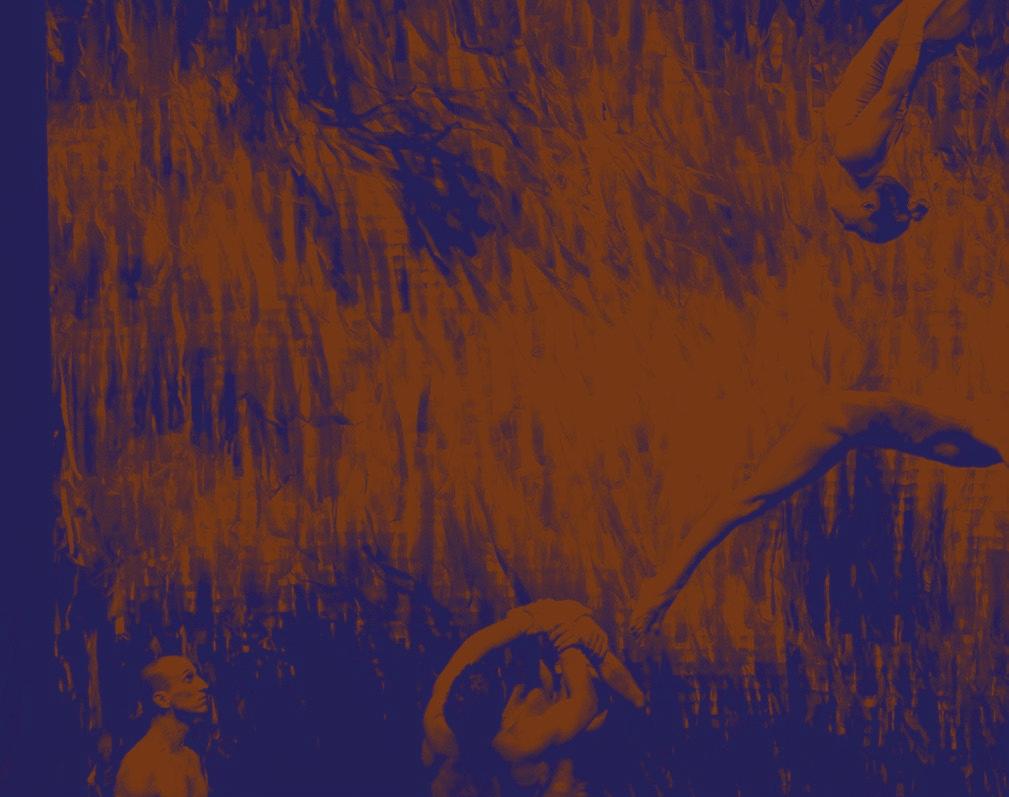
L 75 min
Quantas pessoas, ideias e coisas podemos amar durante uma vida? E de quantos modos diferentes esse sentimento pode se manifestar? É em torno dessa ideia que acontece Solus Amor, espetáculo que funde circo contemporâneo com movimentos de dança clássica e moderna.
No palco, a música original e as diferentes manifestações do amor, explorando suas camadas e formas possíveis, se mesclam a tonalidades frias de luz e figurino, enquanto os artistas performam um verdadeiro balé aéreo. Recursos acústicos e visuais intimamente unificados são um aspecto fundamental do trabalho.
“O cirque danse (circo-dança, em português) é um gênero criado com e pela companhia ao longo de vários anos”,
INÉDITO NAS AMÉRICAS
explica Bence Vági, diretor artístico da Recirquel e diretor-coreógrafo do espetáculo. Nesse balé aéreo, o público acompanhará cenas de acrobacia, equilíbrio e força capilar, além de números com uma marionete realista que traz ao palco um urso polar.
“Solus Amor é sobre fé e amor, sobre a natureza e o universo. O espetáculo aborda esses temas de modo que, ao invés de excluir, inclui os espectadores que querem refletir junto”, afirma Bence.
Fundada em Budapeste, capital da Hungria, em 2012, a Recirquel é hoje uma das principais companhias de circo contemporâneo do mundo, representando um estilo único de circo combinado com dança e teatro, o cirque danse.
Direção e coreografia/Director and choreographer: Bence Vági
Elenco/Cast: Gergely Bagdi, László Farkas, Ádám Fehér, Zita Horváth, Renátó Illés, Gáspár Téri, Yevheniia Obolonina, Eszter Seguí-Fábián, Kristóf Várnagy, Csilla Wittmann e Gábor Zsíros
Trilha sonora/ Soundtrack: Edina Szirtes
Áudio/Sound: Gábor Terjék
Cenário/Set: Péter Klimó
Marionetes/Puppets: Janni Younge
Design de cortina/ Floating curtain design: Péter Klimó, Bence Vági e Tamás Vladár
Figurinos/Costumes: Emese Kasza

Produção dos figurinos/Costumes produced by: Klára Muladi
Desenho de luz/ Lighting design: Attila Lenzsér e József Pető
Coreografia das acrobacias aéreas/ Aerial acrobats’ choreography: Renátó Illés
Designer de movimentos aéreos e diretor técnico/ Flight designer and technical director: Tamás Vladár
Orientador de dança/ Dance captain: Zita Horváth
Assistência de direção artística/ Assistant creative director: Gábor Zsíros
Assistência de direção/Assistant director: Aliz Schlecht
Direção técnica/ Technical direction: Aldrey Hibbeln Rigger: Pablo Nordio
Produção no Brasil/ Production in Brazil: Corpo Rastreado
How many people, ideas and things can we love in one lifetime? How many ways can this feeling manifest itself? It is around this idea that Solus Amor – Only Love takes place, fusing contemporary circus with classical and modern dance movements.
On the stage, original music and the different manifestations of love — its layers and possible forms — are mixed with cold shades of light and costumes, while the artists perform an aerial ballet. Closely unified acoustic and visual features are a key aspect of the work.
“Cirque danse is a genre created with and by the company over several years”, explains Bence Vági, artistic director of Recirquel and directorchoreographer of the show. In this
aerial ballet, the audience will follow scenes of acrobatics, balance and hair hanging, in addition to acts with a realistic puppet that brings a polar bear to the stage.
“Solus Amor – Only Love is about faith and love, about nature and the universe. The show approaches these themes in such a way that, instead of excluding, it includes spectators who want to reflect together”, says Bence.
Created in Budapest, capital of Hungary, in 2012, Recirquel is one of the world’s leading contemporary circus companies, representing a unique style of circus combined with dance and theater, the cirque danse.
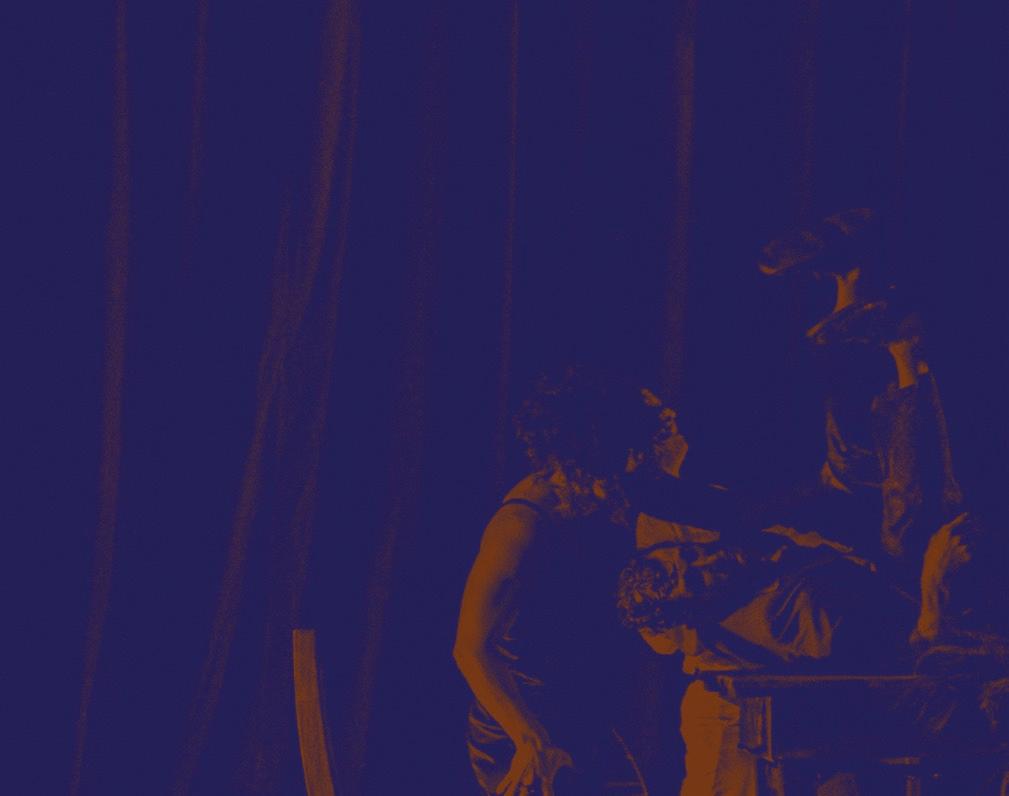
Era para ser um domingo qualquer de uma família aristocrática em decadência. Mas a chegada de um convidado traz à tona os comportamentos mais primitivos de cada um, expondo os mecanismos patriarcais que regem as relações no núcleo familiar.
“Em Um Domingo, a técnica circense se mescla com o teatro e a dança, criando um percurso guiado pelo corpo, pelo texto, pela surpresa, pelas imagens e pelo espetacular. É circo e teatro ao mesmo tempo”, afirmam Tomas Soko e Tato Villanueva, integrantes do Proyecto Migra e parte do elenco. As técnicas circenses — entre elas acrobacia, suspensão capilar, malabarismo, trapézio e arco e flecha — são apresentadas em meio a situações cotidianas. Uma prateleira suspensa
vira trapézio. Laranjas e xícaras se transformam em objetos de malabares.
“O espetáculo possui uma dramaturgia inovadora para o circo latino-americano contemporâneo. Não é mais um espetáculo de circo, de teatro ou de dança, mas uma proposta cênica global, que nasce do jogo teatral e combina elementos circenses, de ilusionismo, ópera e música urbana, gerando uma mistura estética típica da obra”, completam Tomas e Tato.
O Proyecto Migra é uma uma plataforma de circo contemporâneo fundada em 2015. No transcurso destes anos se constituiu como uma referência na América Latina pela qualidade e singularidade de suas propostas. Os diálogos entre circo, teatro e dança estão no cerne das criações do grupo.
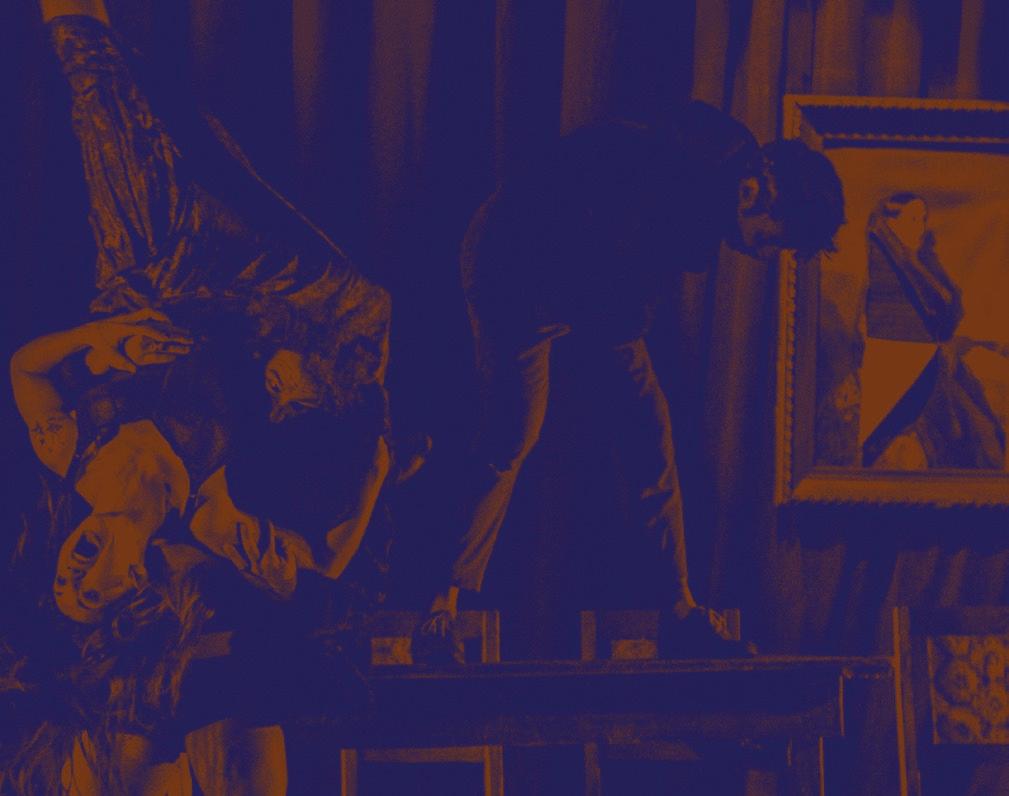
It was supposed to be like any ordinary Sunday in the everyday life of an aristocratic family in decay. But the arrival of a guest brings out the most primitive behaviors in each person, exposing the patriarchal mechanisms that govern relationships in the family nucleus.
“In On a Sunday, circus technique mixes with theater and dance, focusing on the body, the text, the surprise, the images and the spectacular. It’s circus and theater at the same time”, say Tomas Soko and Tato Villanueva, members of Proyecto Migra and part of the cast.
Circus techniques — including acrobatics, hair hanging, juggling, trapeze and archery — are presented in the midst of everyday situations. A suspended shelf
Direção/Direction: Florent Bergal
Elenco/Cast: Juan Carlos Fernandez Alvez, Sofia Galliano, Gabriela Parigi, Tomas Sokolowicz, Florencia Valeri e Tato Villanueva
Figurinos/ Costume design: Celina Santana
Desenho de luz/ Lighting design: Ricardo Sica
Técnica de luz/ Lighting operator: Maria Laura Saban
Produção executiva/ Executive production: Maria Paz Cogorno
Produção geral/ Overall production: Pierpaolo Olcese
Produção no Brasil/ Production in Brazil: Marina Ferreira –Eu.Circ Produções Artísticas
becomes a trapeze. Oranges and cups become juggling objects.
“The show has an innovative dramaturgy for the contemporary Latin American circus. It is no longer a circus, theater or dance show, but a global scenic proposal, which is born from the theatrical rules and combines elements of illusionism, opera and urban music, generating a typical aesthetic mixture”, complete Tomas and Tato.
Proyecto Migra is a contemporary circus platform created in 2015. Over the years, it has become a reference in Latin America for the quality and uniqueness of its shows. Dialogues between circus, theater and dance are at the heart of the group’s creations.
CIA OMKARA <ALE/COL>

O vazio é uma espécie de fratura, uma desconexão. Mas como retomar as conexões consigo mesmo e com o planeta em um mundo em que a tecnologia ganha cada vez mais espaço? “O espetáculo surge de uma reflexão motivada pela crise atual da humanidade e a necessidade de compartilhar essa experiência. Em um mundo cada vez mais afetado pelas crises ecológica, humanitária e social, fica evidente que nosso estilo de vida atual não é sustentável”, afirma o diretor Oskar Mauricio Rojas Guasca.
O espetáculo combina teatro físico com dança e técnicas aéreas circenses, como força dentária (quando o artista é suspenso pela boca), tecido acrobático e corda. Os recursos visuais e a música ao vivo ajudam a criar uma atmosfera que reflete
a evolução da relação dos seres humanos com o mundo natural e com a tecnologia.
Temas como memória, conexão com a natureza, renascimento e morte são explorados. “O homem procura uma maneira de escapar para um espaço diferente. Em sua dança aérea, ele se encontra no limite, no ponto de equilíbrio entre a força e a fragilidade do risco”, ressalta Oskar.
Formada por artistas de diversas nacionalidades que coincidem no espaço e no tempo em Berlim (Alemanha), a Cia Omkara tem como proposta de criação a ideia de que o presente deve ser revisto para possibilitar a construção de um futuro em que cada um dos artistas e todos os seres humanos queiram viver.

The void is a kind of fracture, a disconnection. But how to reconnect with yourself and the planet in a world where technology is having more and more importance? “The show arises from a reflection motivated by the current crisis of humanity and the need to share this experience. In a world increasingly affected by environmental, humanitarian and social crises, it is evident that our current lifestyle is not sustainable”, says director Oskar Mauricio Rojas Guasca. The show combines physical theater with dance and circus aerial techniques, such as acrobatic acts and teeth hang (when the artist is suspended by their teeth). With visual aids and live music, they create an atmosphere that reflects the evolution of humans’ relationship with the natural world and technology.
Direção e intérprete/Direction and cast: Oskar Mauricio
Trilha sonora, narrativa e música ao vivo/Soundtrack and live music: Lih Qun Wong
Artes visuais/ Visual arts: Maximilian Mittermeier
Voos contrapeso e rigger/Balance and rigger: Bitschi Gernot
Iluminação/ Lighting design: Elena Ruiz Lencioni
Olhar externo/ Outside perspective: Anna Katharina Andrees
Produção executiva e olhar externo/ Executive production and outside perspective: Lucila Prestach
Produção no Brasil/ Production in Brazil: Karina Secco (TocA arT)
Subjects such as memory, connection with nature, rebirth and death are covered. “The man looks for a way to escape. In his aerial dance, he finds himself at the limit, at the point of balance between the strength and the fragility of risk,” points out Oskar.
Created by artists of different nationalities who coincide in place and time in Berlin (Germany), Cia Omkara has the idea that the present must be revised to enable the construction of a future in which each of the artists and all human beings want to live.
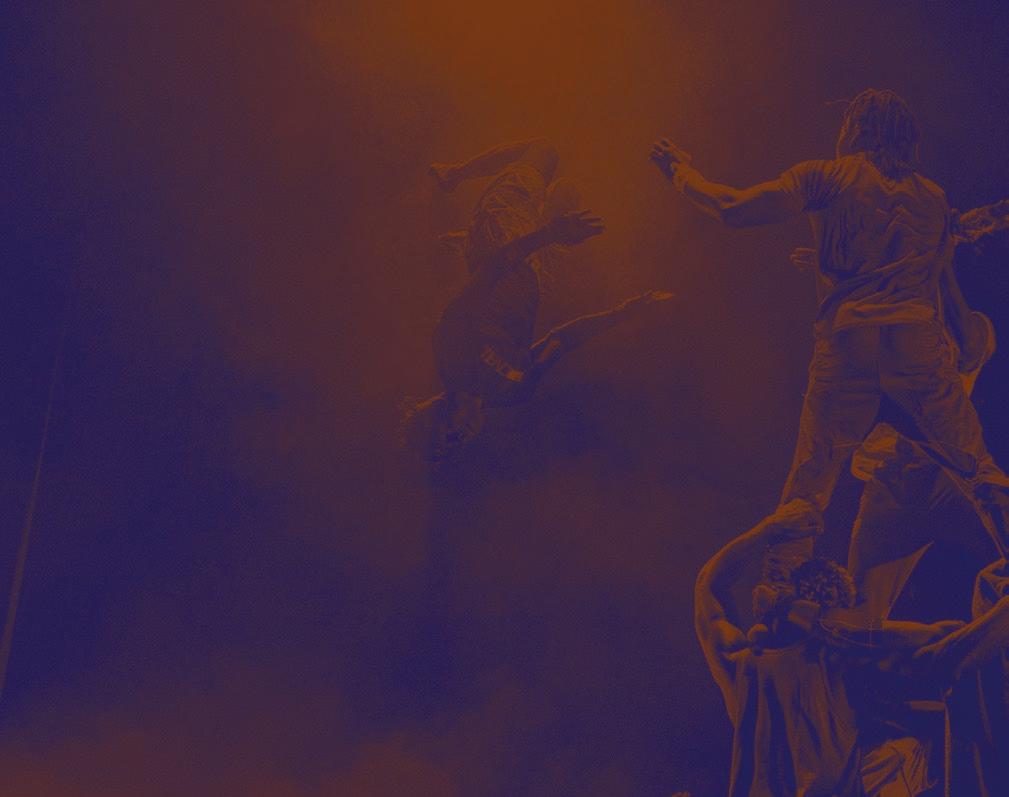
Segundo a Organização das Nações Unidas (ONU), 25% da população mundial não têm acesso à água potável. A disputa por esse bem precioso é o mote para a construção do espetáculo, que coloca em cena artistas da Guiné, país da África Ocidental. A narrativa se inicia com os personagens disputando uma garrafa de água, em acrobacias coletivas de tirar o fôlego.
“O espetáculo explora novos territórios criativos, onde os indivíduos são extremamente interdependentes, e onde só a solidariedade e a escuta do outro permitem a sobrevivência do grupo”, afirma o produtor Richard Djoudi.
Além das questões ambientais, estão em cena situações de violência de gênero, corrupção e desigualdade social, permeadas por muitos números
INÉDITO NAS AMÉRICAS
de acrobacia: os artistas formam diferentes figuras acrobáticas e pirâmides humanas, além de usarem técnicas de contorcionismo. A coreografia se inspira em danças tradicionais, hip-hop, krump e técnicas de teatro.
“Os artistas de Yé – Água treinam principalmente em pisos duros e, dessa forma, podem explorar novas abordagens em diferentes técnicas circenses, o que garante a originalidade do espetáculo”, enfatiza Richard.
O Circus Baobab é um circo social criado em 1998, tendo a atividade artística como ferramenta de intervenção e inclusão social. Para a construção de Yé – Água, os artistas realizaram residências na Guiné e concluíram a construção do espetáculo na França.
Direção/Direction: Yann Ecauvre
Direção artística/ Artistic director: Kerfalla Camara
Elenco/Cast: Bangoura Hamidou, Bangoura Momo, Camara Amara
Den Wock, Camara Bangaly, Camara
Ibrahima Sory, Camara Moussa, Camara Sekou, Keita Aicha, Sylla Fode Kaba, Sylla M’Mahawa, Youla Mamadouba e Camara Facinet
Compositores/ Songwriter: Yann Ecauvre e Jérémy Manche
Diretor acrobático/ Acrobatic director: Damien Drouin
Coreografias/ Choreography: Nedjma Benchaïb e Mounâ Nemri
Figurinista/ Costume designer: Solène Capmas

Iluminação/ Lighting designers: Clément Bonnin e Cécilia Moine
Direção de cena/ Stage director: Cécilia Moine
Direção técnica/ Technical direction: Christophe Lachevre
Produção/Production: Circus Baobab, R’en Cirque e Richard Djoudi
Promoter/Promoter: Mélanie Verdeaux
Parceiro criativo/ Creative partner: Cirque Inextremiste
Direção técnica no Brasil/Technical direction in Brazil: Mark Bromilow
Coordenação de produção no Brasil/ Production in Brazil: Cristiani Zonzini – La Stupenda Produções Artísticas
Produção executiva no Brasil/Executive production in Brazil: Damaris Santos e Suia Legaspe
Apoio institucional/ Institutional support: Consulado-Geral do Brasil em Marselha
According to the United Nations (UN), 25% of the world’s population does not have access to safe drinking water. The dispute over this precious resource is the motto for the creation of Yé – Water, a show that puts on stage artists from Guinea, a West African country. The narrative begins with fights over a bottle of water, in breathtaking collective acrobatics.
“The show explores new creative territories, where individuals are closely interdependent, and where solidarity and listening to others allow the group to survive”, says the producer Richard Djoudi.
In addition to environmental issues, situations of gender violence, corruption and social inequality are in focus, permeated by many acrobatic acts:
the artists create different acrobatic figures and human pyramids, in addition to using contortionism techniques. The choreography is inspired by traditional dance, hip-hop, krump and theater techniques. “Yé – Water artists train mainly on hard floors and, in this way, they can explore new approaches in different circus techniques, which brings the originality of the show”, emphasizes Richard.
Circus Baobab is a social circus created in 1998, which works with artistic activity as a tool for intervention and social inclusion. For the creation of Yé – Water, the artists held residencies in the Guinean capital and concluded the construction of the show in France.
76
ELEMENTOS
INTERCOMPLEMENTARES
INTERCOMPLEMENTARY ELEMENTS
ERIN BALL <CAN>
78
ENTRE SALTOS
BETWEEN JUMPS
MANO A MANA <BRA[SP]>
80 HA!
PURI YAGUARETE <BRA[SP]>
82
INTERVENÇÃO DE BAMBOLÊ
HULA HOOP ARTISTIC INTERVENTION
PIPA LUKE <BRA[SP]/ECU>
84
OLIMPÍADAS DE MALABARISMOS
JUGGLING OLYMPICS
CIA SUPER CIRCO <ARG/BRA[SP]/CHI/VEN>

L 20 min
Quais são os corpos que, historicamente, ficaram de fora de cenas que envolvem risco, como os números aéreos no circo? E quais são os amores que ficaram de fora das construções dramatúrgicas circenses ao longo dos anos?
Neste espetáculo, Erin Ball e Maxime Beauregard contam uma história de amor queer entre duas pessoas com diferentes deficiências. Erin teve suas duas pernas amputadas abaixo do joelho e, a partir desse fato, reformulou e redescobriu como as habilidades aéreas ressoam e ganham significado em seu corpo. Nesta parceria com Maxime, que sofre de dores crônicas, o foco está nos movimentos inovadores das técnicas aéreas apresentadas.
“A acessibilidade está no cerne do trabalho. Como performers queers e com deficiência, trabalhamos a partir de um espaço que prioriza o cuidado com nossos corpos como artistas”, afirmam Erin e Maxime, criadores e intérpretes do espetáculo. A concepção aconteceu em parceria com consultores e pessoas especializadas na dramaturgia para espetáculos protagonizados por pessoas com deficiência.
Erin e Maxime se conheceram em um projeto que reuniu artistas circenses com diferentes tipos de deficiências. “Nós nos apaixonamos e, além de nos complementarmos muito bem pessoalmente, trabalhamos em conjunto de um modo incrível. Temos os mesmos objetivos artísticos”, completam.

Which bodies have historically been left out of risk scenes, such as aerial acts in the circus? And what types of love were left out of circus dramaturgical creations over the years?
In this show, Erin Ball and Maxime Beauregard present a queer love story between two people with different disabilities. Erin had a bilateral below knee amputation, and from that moment on, they reformulated and rediscovered how aerial skills resonate and gain meaning in their body. In this partnership with Maxime, who experiences chronic pain, the artists explore innovative aerial technique movements that work with their bodies.
“Accessibility is at the forefront of the work. As queer and disabled performers, we work from a space that
Elenco/Cast: Erin Ball e Maxime Beauregard
Produção no Brasil/ Production in Brazil: Erika Mesquita
Assistente de produção/Assistant producer: Iacy Mesquita Coello
prioritizes accessibility and care for ourselves, as artists”, say Erin and Maxime, creators and performers of the show. The conception took place in partnership with consultants and people specialized in dramaturgy for shows starring people with disabilities.
Erin and Maxime met on a project that brought together circus performers with different types of disabilities. “We fell in love, and in addition to complementing each other really well personally, we work incredibly well together. We have the same artistic goals”, they conclude.

L 10 min
A intervenção acontece em um aparelho circense conhecido como barra russa, que é uma espécie de mastro flexível. Funciona assim: duas pessoas, as bases, seguram as pontas dessa barra horizontalmente, em seus ombros. Enquanto isso, uma terceira pessoa performa movimentos aéreos em cima desse aparelho. A técnica combina as habilidades da ginástica artística com especialidades circenses como equilíbrio, acrobacias e parada de mão (que é quando um artista fica em posição vertical invertida e equilibra-se com as mãos).
“Quando começamos a pesquisa, não encontramos nenhuma companhia que desenvolvesse esse trabalho no Brasil. Então criamos nossa própria barra e desde 2022 apresentamos a intervenção em festivais e eventos”, afirma
Marília Mattos, artista circense e cofundadora da companhia Mano a Mana, junto a Dyego Yamaguishi. A intervenção é para todos os públicos, então qualquer pessoa que esteja atravessando o espaço pode parar para assistir.
Criada em 2019, a Mano a Mana une a experiência dos artistas com acrobacias de solo e números de portagem (técnica circense em que uma pessoa carrega e lança a outra ao ar). Em 2021, o artista Rodrigo Yazigi se uniu ao duo e, nesse momento, os três iniciaram as pesquisas com barra russa. Além de ministrar oficinas sobre a técnica, o grupo também disponibiliza material audiovisual para ensinar outros artistas a construírem esse tipo de barra.

The artistic intervention takes place in a circus apparatus known as russian bar, which is a kind of flexible pole. It works like this: two people, the bases, hold the ends of the bar horizontally, on their shoulders. Meanwhile, a third person performs aerial movements on top of the bar. The technique combines artistic gymnastics skills with balancing, acrobatics and handstand (supporting the body in an inverted vertical position by balancing on the hands).
“When we started the research, we didn’t find any company that developed this kind of work in Brazil. So we created our own russian bar and in 2022 we started presenting Entre Saltos –Between Jumps at festivals and events”, says Marília Mattos, circus artist and co-founder of the company Mano a Mana,
Criação e concepção/Concept: Mano a Mana
Elenco/Cast: Dyego Yamaguishi, Marília Mattos e Rodrigo Yazigi Trilha original/ Soundtrack: Ivan Alves
Produção/Production: Quica Produções, Thaís Venitt e Thaís Cris
with Dyego Yamaguishi. This artistic intervention is for all audiences, so anyone passing through the place can stop to watch.
Created in 2019, Mano a Mana unites experiences with solo acrobatics and circus acts in which one person carries and throws the other into the air. In 2021, the artist Rodrigo Yazigi joined the duo and, at that moment, the three began their research with russian bars. In addition to giving workshops on the technique, Mano a Mana also provides audiovisual material to teach other artists how to build russian bars.
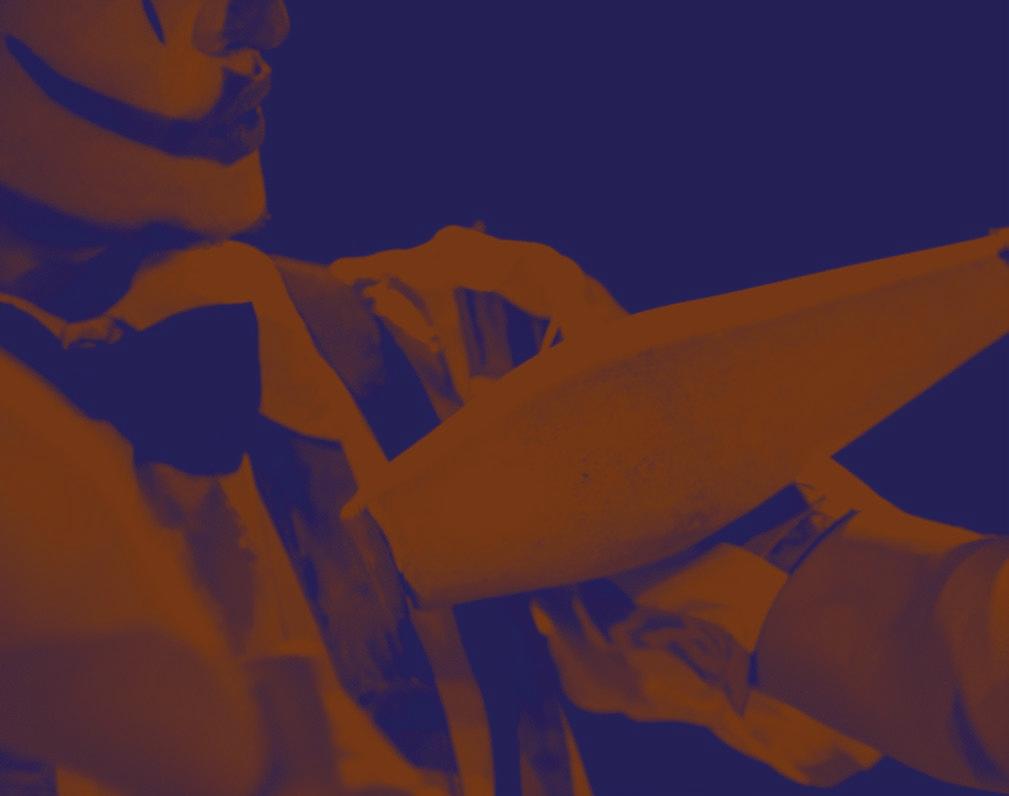
L 15 min
O malabarismo é o ponto inicial da construção cênica realizada pelo palhaço Perigo, interpretado por Puri Yaguarete, artista trans masculino que coloca seu corpo como protagonista da performance. “Só esse fato já traz consigo o conceito de ressignificação”, ressalta Puri. “A performance cria espaços e imaginários que incluem nossos corpos em lugares plurais, usando a queda, que convencionalmente é ligada ao trágico ou a algo ruim, como ponto de elevação da energia performática, fazendo com que o público observe e repense o lugar do erro.”
HA! surge da união do circo com o vogue, que é um tipo de dança que utiliza posições típicas de modelos na criação coreográfica, a partir de movimentos corporais definidos por
linhas e poses. “O resgate ancestral se dá por meio da palhaçaria e os malabares não convencionais aliados aos movimentos do vogue fazem da performance um lugar de desconstrução de ideias coloniais”, afirma Puri. Nascido no interior do Rio de Janeiro, o artista iniciou sua prática em 2015, com a arte de rua. Hoje é artista visual, ator, educador, palhaço, malabarista, performer e dançarino, além de pesquisar as interações possíveis entre vogue e circo.
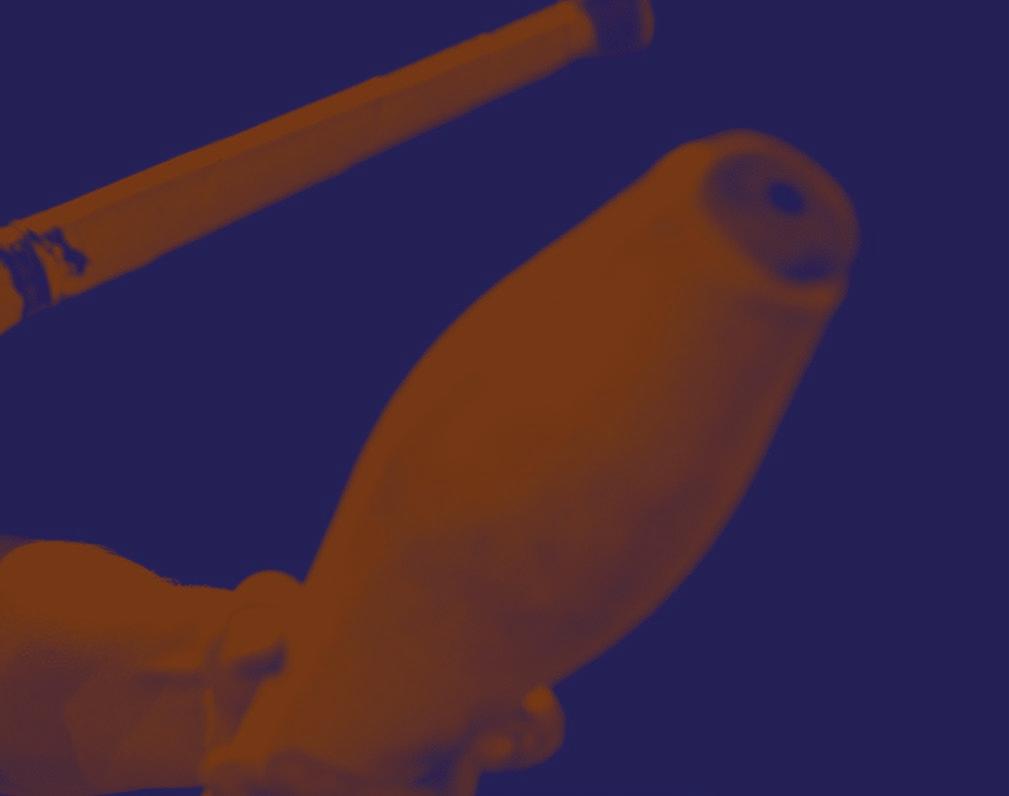
Juggling is the starting point of the scenic construction carried out by the clown Perigo, played by Puri Yaguarete, a trans male artist who places his body as the protagonist of the show.
“This fact brings with it the concept of resignifying the body”, emphasizes Puri. “The performance creates imaginaries that include our bodies in more places than usual, using the fall, which is conventionally linked to the tragic or something bad, as a point of elevation of the performance, making the audience rethink the place of error.”
HA! combines circus and vogue, which is a type of dance that uses typical positions of models in choreographies, based on body movements defined by poses. “The ancestral rescue takes place through clowning. The
unconventional juggling combined with vogue movements deconstruct colonial ideas”, says Puri.
The artist was born in the interior of Rio de Janeiro and started his practice in 2015, with street art. Today he is a visual artist, actor, educator, clown, juggler, performer and dancer. He also researches the possible interactions between vogue and circus.

Bambolê é brincadeira, diversão, mas também é exercício físico e... circo. Nesta intervenção interativa, para públicos de todas as idades, a artista equatoriana Pipa Luke apresenta as diversas formas de giro do bambolê, em partes do corpo como cabeça, boca, braço, tronco e joelhos, além de ensinar alguns jogos e truques para os participantes. A atividade inclui manipulação individual e coletiva do bambolê.
A história do objeto tem início no Egito antigo, há mais de três mil anos, quando se acredita que as crianças brincavam de girar com aros. A difusão do passatempo, no entanto, veio na década de 1950, quando fábricas de brinquedos lançaram o produto comercialmente.
Artista circense, produtora e diretora audiovisual, Pipa é malabarista especializada em bambolê. “Atualmente, desenvolvo pesquisas sobre manipulação de objetos, integrando a técnica a temáticas relacionadas às minhas vivências, abordando as questões da negritude, da resistência e do empoderamento das mulheres negras”, afirma.
Desde 2019, a artista trabalha e realiza atividades no Centro de Memória do Circo, em São Paulo (SP), e integra a rede de elenco da ONG Palhaços Sem Fronteiras Brasil.

Hula hoop is play, fun, but it’s also physical exercise and... circus. In this interactive artistic intervention, for audiences of all ages, Ecuadorian artist Pipa Luke presents the different ways of rotating the hula hoop, in body parts such as the head, the mouth, the arms, the torso and the knees. Pipa also teaches some games and tricks to the participants. The activity includes individual and collective manipulation of the hula hoop.
The history of the object begins in ancient Egypt, over three thousand years ago, when it is believed that children played spinning with hoops. The diffusion of the hobby, however, came in the 1950s, when toy factories launched the product commercially.
Circus artist, producer and audiovisual director, Pipa is a juggler specialized in hula hoops. “Currently, I research the manipulation of objects, integrating the technique with my experiences, giving light to issues such as blackness, resistance and empowerment of black women”, she says.
Since 2019, the artist has been working and carrying out activities at the Centro de Memória do Circo (Circus Memory Center), in São Paulo (SP), and is part of the NGO Clowns Without Borders Brazil.
<ARG/BRA[SP]/CHI/VEN>

L 80 min
O malabarismo é a arte de manipular objetos com precisão e agilidade. Para fazer malabarismo, os artistas podem usar argolas, claves, bolinhas, pratos, facas, serrotes, caixas e até objetos iluminados por fogo. Manter todos eles no ar já parece trabalho suficiente para quem não domina a técnica, mas nesta intervenção os oito artistas em cena ainda competem para ver quem consegue ficar mais tempo sem deixar nenhum de seus malabares cair.
Cada artista representa um país, como nas competições olímpicas, e os juízes são filósofos gregos, uma referência à origem dos jogos na Grécia Antiga. Há competições com cinco, seis e até sete objetos manipulados ao mesmo tempo, além de desafios em que os artistas disputam
corrida fazendo malabarismos e unem outros esportes à atividade circense. Enquanto o público torce para os malabares não caírem, os juízes comediantes fazem as vezes de mestres de cerimônia.
“O intuito não é a competição em si, mas o mergulho no universo das mundialmente famosas competições de malabarismos”, lembra Richard Santos, diretor artístico da Cia Super Circo. Richard é também autor do livro
Aspectos fundamentais do malabarismo, que promove a técnica circense como arte e esporte, além de ter inspirado a criação dos jogos presentes na intervenção.
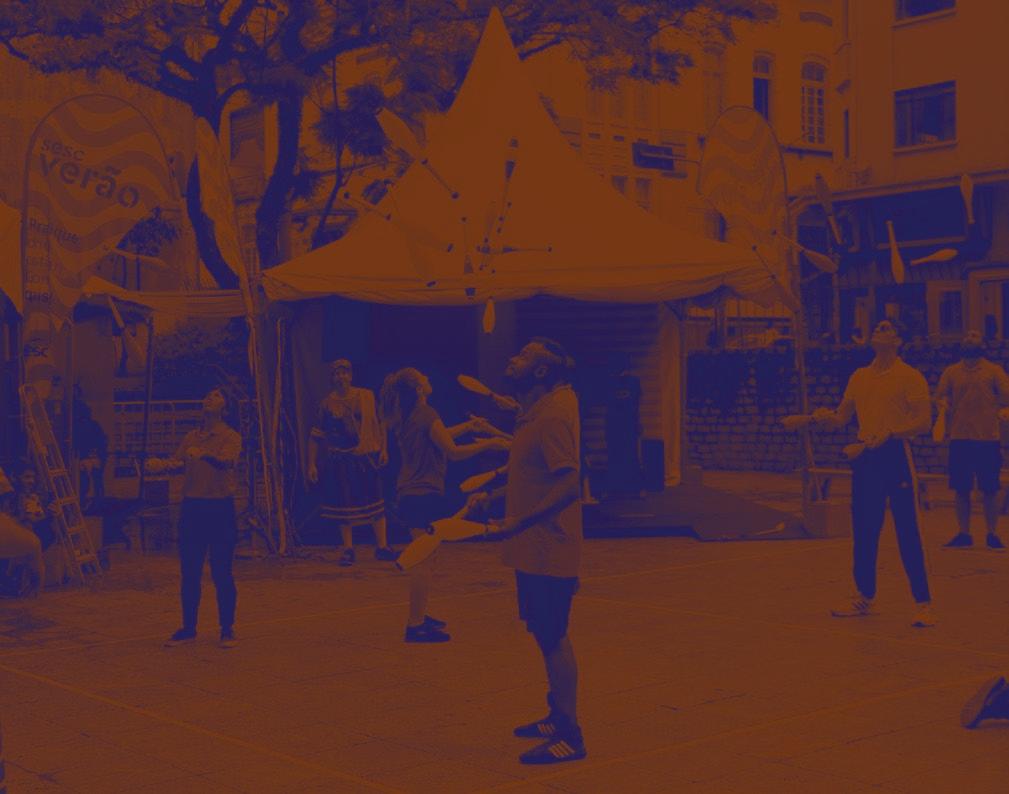
Juggling is the art of manipulating objects with precision and agility. To juggle, artists can use rings, balls, plates, knives, boxes and even objects lit by fire. Keeping all of them in the air already seems enough work for someone who hasn’t mastered the technique, but in this artistic intervention the eight artists on stage still compete to see who can stay the longest without letting any of their juggling fall.
Each artist represents a country, as in the Olympic Games, and the judges are Greek philosophers, a reference to the origin of the games in Ancient Greece. There are competitions with five, six and even seven objects manipulated at the same time, in addition to challenges in which artists compete in a race and combine other sports with circus
Direção geral/ Direction: Richard Santos
Elenco/Cast: Yosmar Anais Sanchez Lizcano, Mario Eliseo Garay Olivares, Caroline Aline Rigoletto Querobin, Anderson Pereira da Silva, Lucas Lopes, Aramis Nicolas Gonzales Arias, Caio Cesar Navarrete da Fonseca, Willian Kreff Mattos, Renato César Paio e Richard Cebalos Ruppelt dos Santos
Produção/Production: Giovanna Assumpção Cebalos Ruppelt, Eduardo Matano Cunha e Renato de Sá Belluomini
activity. While the audience hopes the objects don’t fall, the comedian judges act as masters of ceremony.
“The aim is not the competition itself, but diving into the universe of worldfamous juggling competitions”, says Richard Santos, artistic director of Cia Super Circo. Richard is also the author of the book Aspectos fundamentais do malabarismo –Fundamental aspects of juggling, which promotes circus as art and sport. It also inspired the creation of games for this artistic intervention.
88
A ARTE DE TRANS-FORMAR
CORPOS: OFICINA DE CONTORCIONISMO PARA PROFESSORES
THE ART OF TRANS-FORMING BODIES: FLEXIBILITY
WORKSHOP FOR TEACHERS VI MARQUEZ <BRA[SP]>
90
A LIBERDADE DE SER RIDÍCULA
FREEDOM TO BE RIDICULOUS
RAFAELA AZEVEDO <BRA[RJ]>
92
COMÉDIA FÍSICA DO PONTO DE VISTA DO PALHAÇO
PHYSICAL COMEDY FROM A CLOWN POINT OF VIEW
HILARY CHAPLAIN <EUA>
94
CONSTRUÇÃO DE PORTFÓLIO PARA ARTISTAS INDEPENDENTES
PROFESSIONAL PORTFOLIO BUILDING FOR INDEPENDENT ARTISTS
LUI CASTANHO <BRA[SP]>
96
CRIATIVIDADE SUSTENTÁVEL: FERRAMENTAS BÁSICAS PARA A GESTÃO CULTURAL INDEPENDENTE
SUSTAINABLE CREATIVITY: BASIC TOOLS FOR INDEPENDENT CULTURAL MANAGEMENT
CIRCOLAB CULTURAL – JANAÍNA AMARAL E TATO SANCHES <BRA[SP]>
98
OFICINA DE DIREÇÃO CIRCENSE
WORKSHOP FOR CIRCUS DIRECTORS
RONALDO AGUIAR <BRA[SP]>
100
PARQUE DO CIRCO
CIRCUS PARK
COMPANHIA PARQUE DO CIRCO <BRA[SP]>
102
VIVÊNCIA DE MALABARISMOS E PIÕES
EXPERIENCING JUGGLING AND SPINNING TOPS
CARAVANA TAPIOCA <BRA[SP]>
PANELS
104
AS EXPERIÊNCIAS E PERSPECTIVAS DE ARTISTAS COM DEFICIÊNCIAS NO CIRCO
EXPERIENCES AND PERSPECTIVES OF ARTISTS WITH DISABILITIES IN THE CIRCUS
ARIADNE ANTICO, EMELI BAROSSI E ERIN BALL / MEDIAÇÃO: LIGIA HELENA
FERREIRA ZAMARO <BRA[SC/SP]/CAN>
106
NARRATIVAS CIRCENSES E PROCESSOS HISTÓRICOS
CIRCUS NARRATIVES AND HISTORICAL PROCESSES
DEDE FERREIRA, LOI LIMA E MARCO
MOTTA MEDIAÇÃO: LAUDO BONIFACIO
JUNIOR <BRA[SP]>
108
TECNOLOGIAS NOS PROCESSOS DE CRIAÇÕES CIRCENSES
TECHNOLOGIES IN CIRCUS
CREATIVE PROCESSES
MAURO COSENZA E OSKAR MAURÍCIO
MEDIAÇÃO: ARI FELIPE MIACIRO <COL/URU>
EDIÇÕES SESC BOOK LAUNCH
110
A ARTE DO CIRCO NA AMÉRICA DO SUL CIRCUS ART IN SOUTH AMERICA
JULIETA INFANTINO [AUT./ORG.] MEDIAÇÃO: RAFAEL BARROS <ARG/BRA[SP]>
CIRCUS RESIDENCY
112 CORPO, TERRITÓRIO ANCESTRAL – PROCURA-SE MEMÓRIA
ANCESTRAL TERRITORY BODYS –IN SEARCH OF MEMORY
MAFALDA PEQUENINO [DIREÇÃO ARTÍSTICA] <BRA[SP]/TOG>

Às vezes o corpo trava, dá aquela dor, a gente sente o músculo quase rasgando para se esticar. E mesmo com algum treino, não é todo mundo que consegue alcançar os pés sem dobrar os joelhos. Ou se alongar sem sentir os músculos repuxados. Se para os artistas circenses flexibilidade não parece ser um problema, para quem está começando na prática é preciso um pouco mais de perseverança, mas nada que bons professores não consigam ajudar a resolver.
Nesta oficina, que tem como público-alvo professores de circo, de ginástica e de crossfit, fisioterapeutas e instrutores de ioga, a artista Victória Marquez vai desmistificar tabus relacionados à prática de contorcionismo e flexibilidade.
“Na parte teórica, abordo os tabus dessa arte, desmistificando os segredos de uma aula com resultados e TRANSformações. Na parte prática, fazemos uma aula de contorção, com exercícios e métodos para melhorar a flexibilidade e a técnica, tanto para artistas quanto para alunos. Também explico como professores de flexibilidade podem ministrar aulas mais produtivas”, explica Victória, que é artista de circo, ginasta, professora, diretora de movimento e bailarina. Ela é formada pelo Circocan (International School of Circus), em Santa Catarina, e pela Escola Nacional de Circo, no Rio de Janeiro.

Sometimes the body freezes, the pain comes, and we feel the muscles almost tearing to stretch. And even with some training, not everyone can reach their feet without bending their knees. Or stretch without feeling the muscles pulled. If flexibility doesn’t seem to be a problem for circus performers, for those just starting out in practice it takes a little more perseverance. And good teachers can be helpful to solve it.
In this workshop, whose target audience is circus, gymnastics and CrossFit teachers, physiotherapists and yoga instructors, artist Vi Marquez will demystify taboos related to the practice of contortionism and flexibility.
“In the theoretical part, I address the taboos of this art, demystifying the secrets of a class with results
and TRANSformations. In the practical part, we do contortion training, with exercises and methods to improve flexibility and technique, both for artists and for students. I also explain how flexibility teachers can have more productive classes”, explains Vi, who is a circus artist, gymnast, teacher, movement director and dancer. She graduated from Circocan (International School of Circus), in Santa Catarina, and from the National Circus School, in Rio de Janeiro.

Quais os paralelos possíveis entre a arte da palhaçaria e a vida cotidiana de cada um e cada uma de nós? Rir dos erros, das trapalhadas e dos ridículos escancarados pelas ações dos palhaços pode fazer com que as pessoas percebam algo de si mesmas e dos outros?
Neste encontro, a palhaça Rafaela Azevedo expõe essas e outras questões, mergulhando na filosofia do erro, do riso e da inadequação: essas são as matérias que servem de base para a construção de trabalhos de palhaçaria. “A ideia é refletir juntes sobre a necessidade dessa linguagem na sociedade atual”, afirmam Rafaela e Giulia Nina, responsáveis pela atividade.
Indicado especialmente para estudantes de artes cênicas e artistas, A Liberdade de Ser Ridícula é um convite para debater a arte da palhaçaria de maneira simples e acessível, ampliando a discussão para fora do ambiente circense ou artístico em geral.
Rafaela Azevedo é atriz, palhaça, diretora e pesquisadora. Idealizadora, intérprete, codiretora e codramaturga do espetáculo King Kong Fran, parte da programação do festival. É também diretora do Laboratório Estado de Palhaça e Palhaço, escola on-line que difunde a técnica da palhaçaria.

What are the possible parallels between the art of clowning and the daily life of each and every one of us? Can laughing at the mistakes and the ridicule of clowns’ actions make people realize something about themselves and others?
At this meeting, the clown Rafaela Azevedo exposes these and other questions, delving into the philosophy of error, laughter and inadequacy: these are the materials that serve as the basis for the creation of clown work. “The idea is to think together on the need for this language in contemporary society”, say Rafaela and Giulia Nina, responsible for the activity.
Specially designed for performing arts students and artists, A Liberdade de Ser Ridícula – Freedom to Be Ridiculous is an invitation to talk about the art
of clowning in a simple and accessible way, expanding the discussion outside the circus or the artistic world.
Rafaela Azevedo is an actress, clown, director and researcher. Creator, interpreter, co-director and coplaywright of the show King Kong Fran, part of the festival’s program. She is also the director of the Laboratório Estado de Palhaça e Palhaço, an online school that disseminates the technique of clowning.
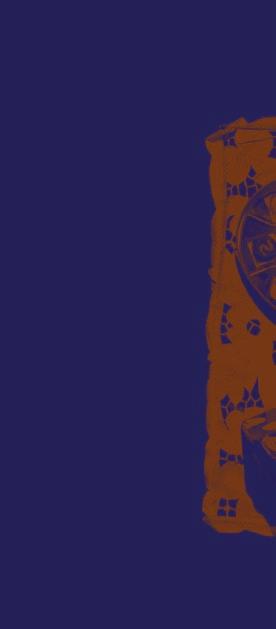
O que faz um palhaço ser mais engraçado do que outros? Qual o caminho que cada artista cômico precisa percorrer para encontrar sua própria voz? Nesta oficina, Hilary Chaplain apresenta ferramentas para os participantes ampliarem seu vocabulário corporal para a criação de humor e ensina técnicas de improvisação, orientando sobre os melhores momentos para transformar gestos simples em risadas da plateia.
A metodologia inclui a realização de jogos e exercícios, com a criação de cenas curtas. “Eu resisti para fazer meu primeiro espetáculo de palhaçaria, porque me via como uma atriz séria. Quando eu finalmente aceitei a possibilidade de que eu era, na verdade, uma palhaça, consegui criar um trabalho extraordinário”, afirma Hilary.
A atriz e palhaça é reconhecida por suas aulas sobre comédia física e palhaçaria voltada para a atuação em espetáculos teatrais e em hospitais. Ao longo dos anos, Hilary elaborou seu próprio método de ensinar as pessoas a serem autênticas, vulneráveis, divertidas e ousadas: esses são os ingredientes necessários para a criação dos melhores shows de palhaçaria. Seu trabalho pode ser conferido no espetáculo A Life in Her Day – Uma Vida no Seu Dia, que faz parte do festival.
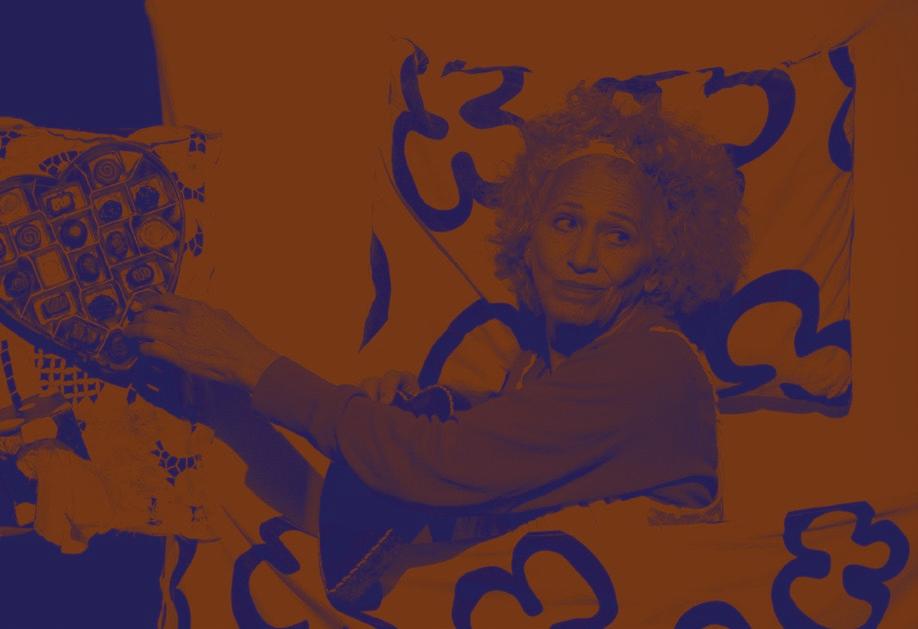
What makes one clown funnier than others? What path does each clown need to take to find their own voice? In this workshop, Hilary Chaplain presents tools for participants to expand their physical vocabulary to create humor. She teaches improvisation techniques, guiding them on how to approach writing the funny and how to transform simple gestures into laughs.
The methodology includes playing games and exercises: the participants will build short pieces of material. “I resisted doing a clown show because I thought of myself as a serious actress. When I finally gave in to the possibility that I was indeed a clown, the show began to joyfully materialize”, says Hilary.
The actress and clown is also known for her classes on physical comedy, theater clowning and hospital clowning. Over the years, Hilary has crafted her own method of teaching people to be authentic and vulnerable, funny and daring: these are the necessary ingredients for creating the best clowning shows. Her work can be seen in the show A Life in Her Day – Uma Vida no seu Dia.
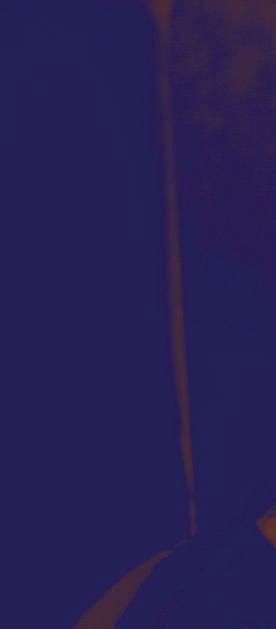
Voltado a artistas independentes, especialmente artistas LGBTQIAPN+, pessoas trans, travestis e não binárias, o curso abordará conceitos de produção e de comunicação, passando por discussões sobre identidade visual, público-alvo e storytelling (técnicas narrativas).
A proposta é que cada participante, ao longo dos encontros, construa seu próprio portfólio, valorizando o que há de especial em seu trabalho artístico e trajetória, e organizando um material que possa ser aplicado em editais e festivais.
“Produzo artistas e festivais LGBTQIAPN+ há anos e acompanho pessoas trans, travestis e não bináries. Durante minha trajetória, entrei em contato com artistas incríveis que
não conseguiam espaço por não dominarem ferramentas que possibilitam o diálogo com as instituições e o mercado de trabalho. A falta de um material bem-estruturado muitas vezes resulta em negativas por parte de instituições de cultura, o que faz com que artistas acabem até desistindo de trabalhar na área”, explica Lui Castanho, mediador dos encontros. Lui é produtor cultural, circense e roteirista. Graduando em produção cultural, trabalha na área desde 2018, com projetos de cultura LGBTQIAPN+.
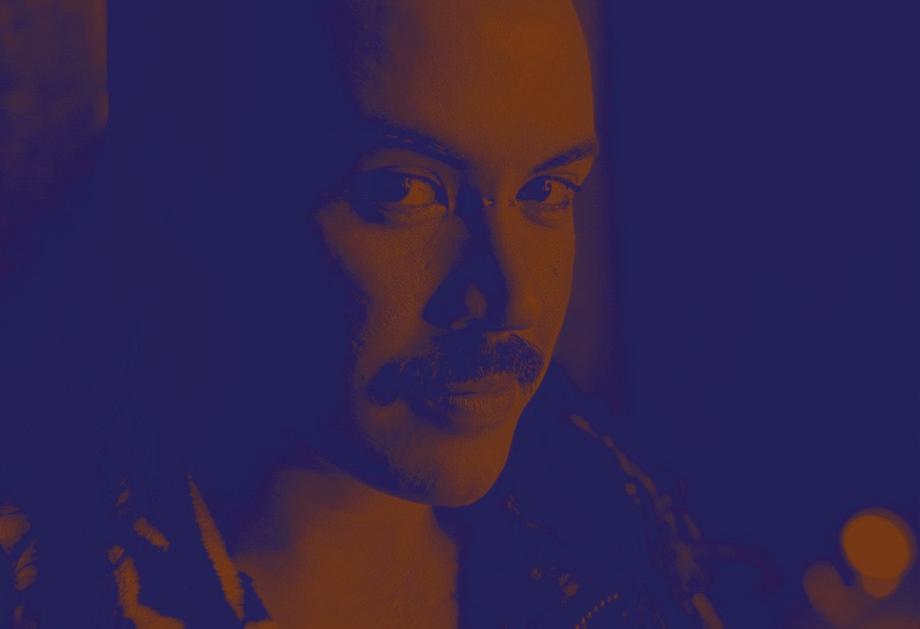
Independent artists — especially LGBTQIAPN+, trans, drag queens and non-binary people — are invited to this workshop. Throughout the meetings, Lui Castanho will talk about production and communication concepts, including discussions on visual identity, target audience and storytelling (narrative techniques).
The purpose is that each participant builds their own professional portfolio, valuing what is special in their artistic work and trajectory, and organizing material that can be applied in festivals.
“I have been producing LGBTQIAPN+ artists and festivals for years and I’ve been paying close attention to trans, drag queens and non-binary people. Throughout my professional
journey, I came into contact with incredible artists who were unable to enter the art world because they did not master tools that enable dialogue with institutions and the job market. The lack of well-structured material often results in denials by cultural institutions, which causes artists to end up even giving up working in the area”, explains Lui Castanho, the mediator of the meetings.
Lui is a cultural producer, circus artist and screenwriter. He is graduating in cultural production and has been working in the area since 2018, with LGBTQIAPN+ artistic projects.

Muitas vezes, artistas circenses são também seus próprios produtores. Mas por onde começar quando o assunto é vender o trabalho artístico? Nesta oficina, artistas, produtores e coletivos poderão compartilhar experiências e dúvidas sobre como colocar ideias no papel e apresentá-las a parceiros, desde a montagem de orçamentos até o planejamento estratégico da própria carreira.
“A oficina apresenta ferramentas práticas e conceitos simplificados para auxiliar os participantes a reconhecerem seu posicionamento no mercado, facilitando o diálogo com instituições e organizações culturais”, afirmam Janaína Amaral e Tato Sanches, fundadores do CircoLab Cultural.
O encontro aborda cinco conteúdos principais: autopercepção, planejamento estratégico e gestão de tempo; cálculo de custos e formulação de orçamentos; apresentação de ideias a parceiros; organização de materiais de trabalho, como sinopses, releases e necessidades técnicas; e discussão sobre termos comuns à profissão, como DRT, ART, ECAD, SBAT, NR35 etc.
Fundado em 2016 por Tato Sanches, artista circense, produtor e filmmaker, e por Janaína Amaral, produtora cultural e mestranda em Economia e Política da Cultura e Indústrias Criativas pela Universidade Federal do Rio Grande do Sul (UFRGS), o CircoLab é um laboratório de pesquisas e experimentações colaborativas que atua na formação, consultoria e mentoria para artistas de circo.

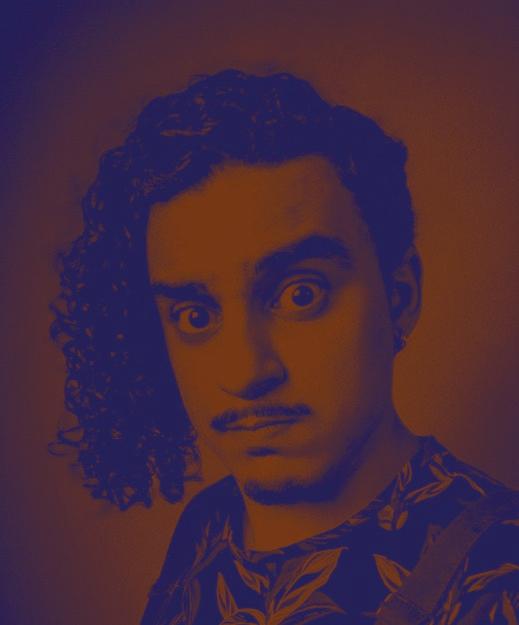
Often, circus performers are also their own producers. But where to start when it comes to selling artwork?
In this workshop, artists, producers and collectives will be able to share experiences and doubts about how to transform ideas into projects and how to show them to partners, from creating and managing budgets to strategic planning for one’s own career.
“The workshop presents practical tools and simplified concepts to help participants recognize their position in the art market, promoting dialogue with cultural institutions and organizations”, say Janaína Amaral and Tato Sanches, founders of CircoLab Cultural.
The meeting covers five main contents: self-perception, strategic planning and time management; costing and budgeting;
presenting research, work, or proposals to partners; organization of work materials, such as synopses, releases and technical needs; and discussion on Brazilian terms such as DRT, ART, ECAD, SBAT and NR35.
Created in 2016 by Tato Sanches, circus artist, producer and filmmaker, and by Janaína Amaral, cultural producer and Master’s Degree student in Economics and Politics of Culture and Creative Industries at the Federal University of Rio Grande do Sul (UFRGS), CircoLab is a collaborative laboratory that works in training, consulting and mentoring circus artists.

Qual o papel da direção artística em um espetáculo circense? Quais os desafios desse ofício no Brasil?
A partir de conteúdos teóricos e práticos, a oficina aborda o processo criativo dentro da sala de ensaio, colocando em foco o entendimento de que o diretor circense é um facilitador do processo de criação.
“Não existem cursos de direção de espetáculos de circo no Brasil. Mas essa é uma linguagem cênica muito complexa, que precisa ter processos formativos e reflexivos específicos.
Construir espaços para que diretores e futuros diretores possam exercitar seu fazer e refletir sobre o que é produzido é necessário para o desenvolvimento da linguagem”, afirma
Ronaldo Aguiar, diretor circense responsável pela oficina.
Voltado a artistas circenses e de outras linguagens cênicas, diretores e alunos de artes cênicas, o encontro apresenta aos participantes os fundamentos estéticos que só existem no circo, como o corpo em risco, além de abordar questões de dramaturgia, música e processos coreográficos que estão à disposição da arte circense na hora da criação.
Ronaldo Aguiar é pernambucano e radicado na cidade de São Paulo há 15 anos. Bailarino, coreógrafo, ator, palhaço e diretor circense, durante sua carreira atuou em dezenas de trabalhos e dirigiu espetáculos de dança, teatro e circo pelo Brasil.
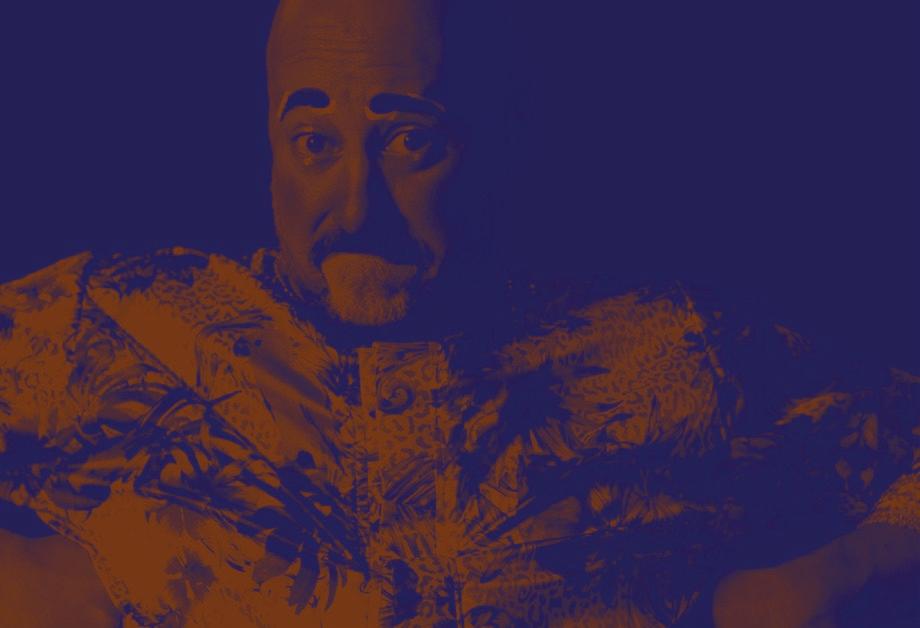
What is the importance of artistic direction in a circus show? What are the challenges of this job in Brazil?
Based on theoretical and practical content, the workshop will focus on the creative process and the understanding that the circus director is a facilitator of the creative process.
“There are no workshops for circus directors in Brazil. But this is a very complex scenic language, which needs to have specific formative and reflective processes. It is important that directors and future directors train themselves to do their own work and reflect on what is produced”, says Ronaldo Aguiar, circus director responsible for the workshop.
Circus artists and artists from other scenic languages, directors and
students of scenic arts are invited to the workshop. The participants will discuss the particular aesthetics of the circus, such as the body at risk, in addition to addressing issues of dramaturgy, music, and choreographic processes, that are available to circus creative processes as well.
Ronaldo Aguiar is from Pernambuco and has been living in the city of São Paulo for 15 years. Dancer, choreographer, actor, clown and circus director, throughout his career he performed in dozens of works and directed dance, theater and circus shows in many Brazilian states.
O Parque do Circo é um espaço de experimentação de atividades corporais ligadas ao circo. Nos diferentes brinquedos e aparelhos interativos, o público pode jogar malabares e realizar acrobacias em trampolins, além de desafiar o próprio equilíbrio e interagir em jogos coletivos. Inspirados em diferentes técnicas circenses, os aparelhos possuem níveis de dificuldade e permitem que cada visitante crie seu próprio circuito de atividades. O objetivo é experimentar o desenvolvimento corporal por meio de brincadeiras.
“Os brinquedos e aparelhos foram confeccionados para facilitar o aprendizado de forma lúdica, coletiva e divertida, mas sem ser competitiva”, explica Gonzalo Caraballo, criador e diretor artístico do Parque

do Circo. As experimentações, individuais e coletivas, buscam resgatar o jeito de brincar das gerações anteriores à popularização das telas e dos brinquedos digitais.
O Parque do Circo foi criado em 2013 por Gonzalo Caraballo, artista circense com mais de 20 anos de trajetória. Desde então, novos equipamentos foram criados para aumentar cada vez mais a inclusão de todos os públicos. Atualmente, os brinquedos e aparelhos também são feitos com material reciclado.
L 240 min
Idealização/Concept: Gonzalo Caraballo e Lua Tatit
Coordenação/ Coordination : Gonzalo Caraballo
Monitores: Julia Barnabé e Lenita Ponce
Produção/Production: Lu Gualda/Palco de Papel Produ

Parque do Circo – Circus Park is an experimental artistic intervention for physical activities related to the circus. In the interactive apparatus, the audience can juggle and perform acrobatics on trampolines, in addition to challenging their own balance and interacting in collective games. Inspired by various circus techniques, the apparatuses have levels of difficulty and allow each visitor to create their own circuit of activities. The goal is to experience body development through play.
“The apparatuses were made to facilitate learning in a playful, collective and fun way, but without being competitive”, explains Gonzalo Caraballo, creator and artistic director of Parque do Circo – Circus Park. Experiments, individual and
collective, seek to rescue the way of playing from those who grew up before the popularization of screens and digital toys.
Parque do Circo – Circus Park was created in 2013 by Gonzalo Caraballo, a circus artist with more than 20 years of experience. Since then, new apparatuses have been created to increase the inclusion of all audiences. Nowadays, the devices are also made with recycled material.
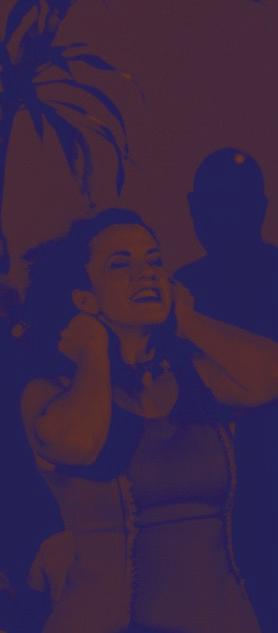
Brincar de jogar pião e de tentar fazer números malabarísticos com bolinhas feitas de meia é daqueles passatempos que muitos adultos de hoje guardam na memória como cenas da infância. Nesta vivência, tanto adultos quanto crianças (a partir dos seis anos ou menores acompanhados por adulto responsável) são convidados a experimentar novas habilidades e podem entrar na brincadeira.
Nas atividades, o equilíbrio e a coordenação motora são postos à prova de forma lúdica e divertida. O equilíbrio é a prova de fogo das experimentações malabarísticas, que acontecem por meio da manipulação de objetos como bolinhas, bambolês, piões e pratos de equilíbrio. Já a
coordenação motora é testada com a experimentação do pião das brincadeiras populares.
Nas duas atividades, “os participantes serão convidados a criar imagens, desafiando a gravidade e trabalhando a movimentação corporal”, afirmam Anderson Machado e Giulia Nina, organizadores da vivência. Os dois são fundadores da companhia Caravana Tapioca, um grupo de circo, teatro e música. Com 12 anos de trajetória, a Caravana Tapioca tem em seu repertório espetáculos que mesclam o clássico e o contemporâneo, buscando realizar um circo com identidade brasileira.
L 180 min Facilitadores da vivência/Experience facilitators: Anderson Machado, Emerson Noise (Tchatcho), Giulia Nina, Karen Nashiro e Paulo dos Santos Produção/Production: Giulia Nina
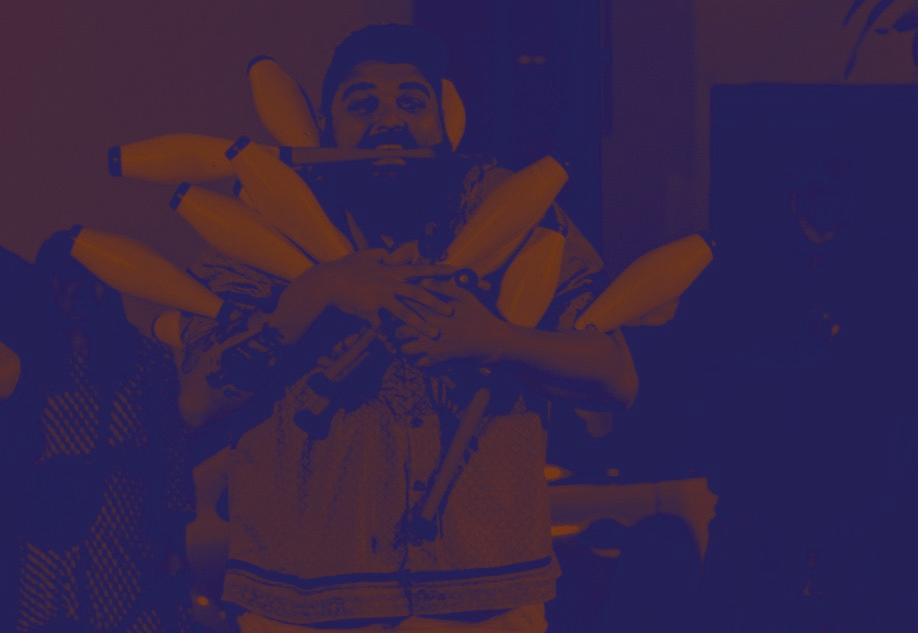
Playing tops and trying to juggle balls made from socks is one of those hobbies that many adults keep in their memories as childhood scenes. In this experience, both adults and children (from six years old or younger accompanied by parents) are invited to try out new skills.
Balance and motor coordination are put to the test, in a playful and fun way. Balance is the key to juggling experiments, which happen through the manipulation of objects such as balls, hula hoops, spinning tops and plates. Motor coordination is the key to spinning top games.
In both activities, “participants will be invited to create images, defying gravity and working on body movement”, say Anderson Machado and Giulia Nina,
organizers of the experience. The two are founders of the company Caravana Tapioca, a circus, theater and music group. With 12 years of experience, Caravana Tapioca has in its repertoire shows that mix the classic with the contemporary, seeking to create a circus with a Brazilian identity.
MESA PANEL
EXPERIENCES AND PERSPECTIVES OF ARTISTS WITH DISABILITIES IN THE CIRCUS
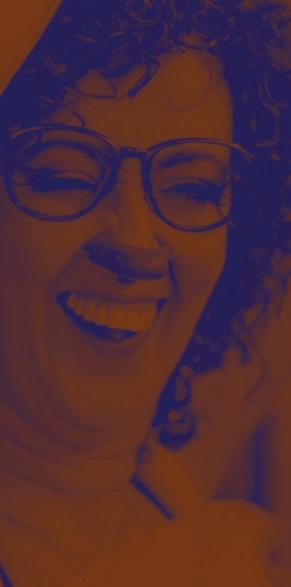
Nas produções circenses contemporâneas, pessoas com diferentes tipos de deficiências ocupam os palcos como protagonistas, explorando as dimensões sociais e políticas do corpo. Neste encontro, os convidados debatem como os corpos diversos se encaixam, se adaptam ou subvertem a relação entre as técnicas circenses e as possibilidades físicas de cada artista. A conversa propõe uma reflexão sobre a presença cada vez mais marcante das pessoas com diferentes deficiências no fazer circense.
Ariadne Antico é palhaça e integrante da companhia A Casa das Lagartixas. Possui um andar que, em suas próprias palavras, é charmoso e fora do eixo.
Emeli Barossi é cofundadora da La Luna Cia de Teatro. Pesquisa palhaçaria relacionada a questões como feminino e corpos disformes. Erin Ball é canadense e teve as pernas amputadas abaixo do joelho. Sua atuação pode ser vista em Elementos InterComplementares. A mediação será feita por Ligia Helena Ferreira Zamaro, assistente na Gerência de Educação para a Sustentabilidade e Cidadania do Sesc São Paulo.

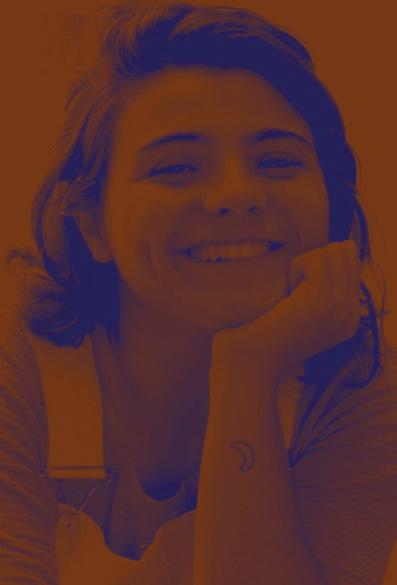

In contemporary circus productions, persons with disabilities occupy the stages as protagonists, exploring the social and political dimensions of the body. In this meeting, the artists discuss how diverse bodies adapt or subvert the relationship between circus techniques and the physical possibilities of each person. The panel proposes reflecting on the increasingly strong presence of persons with disabilities in circus activities.
Ariadne Antico is a clown and member of the company A Casa das Lagartixas. She walks in a charming and off-axis way, in her own words. Emeli Barossi is co-founder of La Luna Cia de Teatro. She researches clowning related to issues such as feminism and diverse bodies. Erin Ball is Canadian and had a bilateral below-knee amputation. Their performance can be seen in Elementos InterComplementares – InterComplementary Elements. The meeting will be conducted by Ligia Helena Ferreira Zamaro, assistant in the Management of Education for Sustainability and Citizenship at Sesc São Paulo.
De que modo a curadoria de um festival pode dar visibilidade ou, por outro lado, apagar narrativas e processos históricos que estejam se desenvolvendo na linguagem artística?
Os espetáculos e as intervenções selecionados para a programação de 2023 do CIRCOS – Festival Internacional Sesc de Circo apontam para corpos, discursos e geografias não hegemônicas, e esses são os temas da mesa Narrativas Circenses e Processos Históricos, com participação de Dede Ferreira, Loi Lima, Marco Motta e mediação de Laudo Bonifacio Junior. Dede Ferreira é artista plástico, produtor cultural e palhaço. Fundador e coordenador da Associação Cultural Quilombaque e cofundador da Cia Trupe Liuds. Loi Lima é atriz, palhaça

e produtora cultural. Migrante, é fundadora da Indômita Cia, que desenvolve pesquisa em palhaçaria com foco em espetáculos para as infâncias pretas. Marco Motta é artista circense baiano radicado na Espanha, e hoje desenvolve trabalho autoral nas áreas do circo e da dança. A mediação será feita por Laudo Bonifacio Junior, Gerente Adjunto no Sesc Campo Limpo.

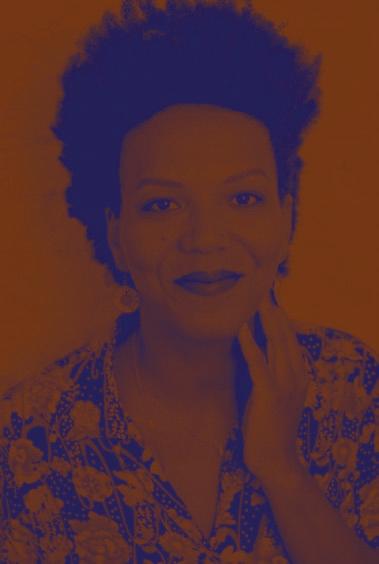
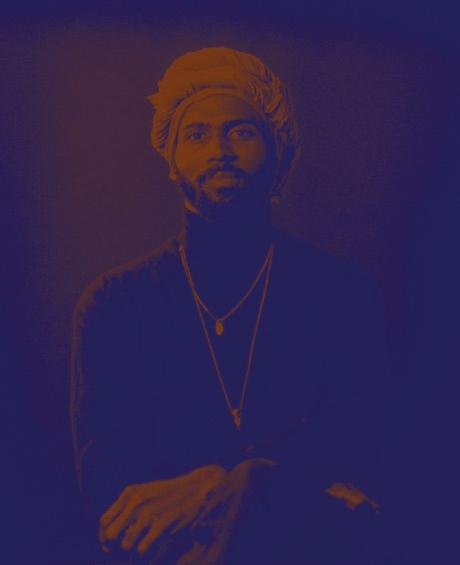
How the curatorship of a festival could give visibility or, on the other hand, erase narratives and historical processes that are being developed in the artistic language?
The shows and artistic interventions selected for the 2023 program of CIRCOS – Festival Internacional Sesc de Circo point to non-hegemonic bodies, discourses and geographies, and these are the discussions promoted by the panel Circus Narratives and Historical Processes, with the participation of Dede Ferreira, Loi Lima, Marco Motta and mediation by Laudo Bonifacio Junior.
Dede Ferreira is a visual artist, cultural producer and clown. Founder and coordinator of Associação Cultural Quilombaque and co-founder of Cia Trupe Liuds. Loi Lima is an actress, clown
and cultural producer. A migrant, she is the founder of Indômita Cia, which develops research in clowning focusing on shows for black childhoods. Marco Motta is a circus artist from Bahia (now based in Spain) who develops authorial work on circus and dance. The meeting will be conducted by Laudo Bonifacio Junior, Deputy Manager in the Sesc Campo Limpo.

Quando o público pensa em espetáculos circenses, talvez a tecnologia digital seja um dos últimos recursos que venha à mente sobre o que fará parte da obra. É claro que o circo se vale de muitos recursos, afinal há montagem de estruturas grandes para que os artistas voem de um lado para o outro em segurança, ou para que as mágicas que acontecem debaixo de nossos olhos não tenham seus segredos revelados para o público. Mas e quando a questão é a tecnologia digital, quais as possíveis intersecções entre as artes circenses e os recursos tecnológicos de última geração?
Nesta conversa, os artistas Oskar Maurício, do espetáculo Vazio, e Mauro Cosenza, criador da instalação interativa Ctrl+Z, debatem os rumos
possíveis da união entre circo e recursos digitais.
Oskar Maurício é formado pela Escola Nacional de Circo Para Todos, na Colômbia, especializado em acrobacias aéreas e em dança contemporânea africana. Mauro Cosenza é multiartista, especializado na criação, direção e produção em artes cênicas circenses. Atualmente investiga a interação do corpo com a arte digital e os dispositivos interativos. A mediação será feita por Ari Felipe, animador cultural no Sesc Belenzinho.

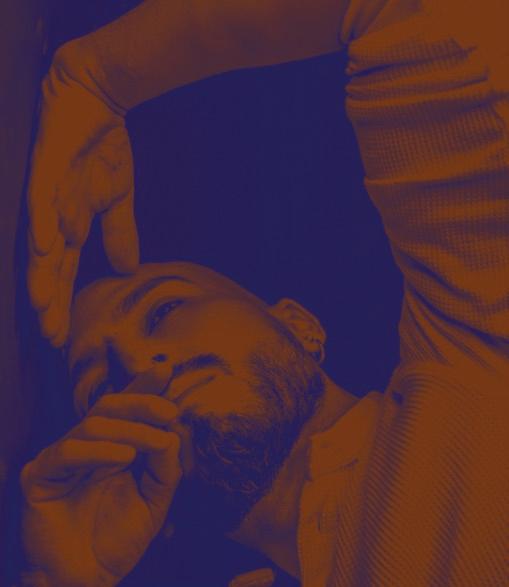
When people think of circus, perhaps digital technology is one of the last resources that come to mind about what will be part of the show. We all know that the circus uses many resources: large structures are set up so that the artists can fly safely from one place to another; magic shows take place under our eyes without having their secrets revealed, and so on. But when it comes to digital technology, what are the possible intersections between circus arts and the latest digital resources?
In this panel, artists Oskar Maurício, from the show Vazio – Void, and Mauro Cosenza, creator of the interactive installation Ctrl+Z, discuss the possibilities for the union between the circus and digital resources.
Oskar Maurício graduated from the Escola Nacional de Circo Para Todos, in Colombia, specializing in aerial acrobatics and contemporary African dance. Mauro Cosenza is a multi-artist: he creates, directs and produces circus activities. He is currently investigating the body’s interaction with digital art and interactive devices. The mediation will be conducted by Ari Felipe, who works programming circus at Sesc Belenzinho.
<ARG/BRA[SP]>
As interfaces estéticas e sociopolíticas das criações circenses de países como Brasil, Argentina, Chile e Uruguai são o tema da obra A Arte do Circo na América do Sul – Trajetórias, Tradições e Inovações na Arena Contemporânea, editada pelas Edições Sesc e lançada durante o festival.
O livro reúne textos de autores sul-americanos e propõe reflexões sobre a história do circo e suas representações na atualidade. As discussões passam pelos conceitos possíveis sobre o que é circo e abordam as tensões entre criatividade e técnica, além das novas experiências circenses no continente.
“Essa publicação nos faz virar a perspectiva da nossa rota de busca, tornando capaz um desejo de
fortalecimento da linguagem circense latino-americana”, afirma Rafael Barros, mediador da mesa. “Mesmo que tenhamos influências europeias, a linguagem circense se desenvolve dentro de nossas particularidades: está em constante construção e se constrói por conta de nossas necessidades”, completa.
Fazem parte da mesa a organizadora da obra a professora argentina Julieta Infantino, doutora em antropologia, e Rafael Barros, doutorando em artes cênicas que também faz a mediação da conversa com o público.
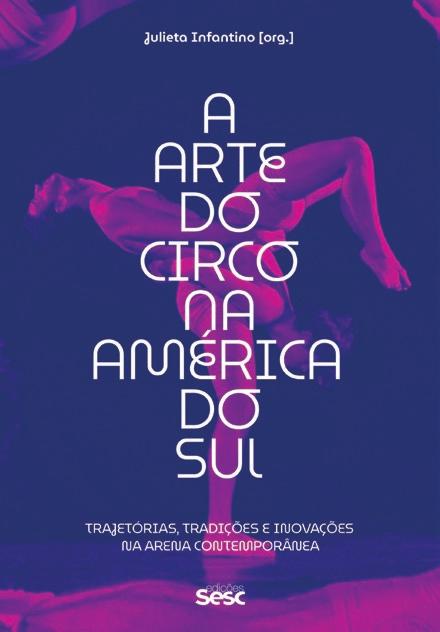
The aesthetic and sociopolitical interfaces of circus creations from countries such as Brazil, Argentina, Chile and Uruguay are the subject of the book A Arte do Circo na América do Sul – Trajetórias, Tradições e Inovações na Arena Contemporânea [Circus Art in South America – Trajectories, Traditions and Innovations in the Contemporary Ring], edited by Edições Sesc and released during the festival.
The book features several articles by South American authors and proposes reflections on the history of the circus and its representations today. The texts present concepts about what a circus is, discuss the tensions between creativity and technique and explore the new circus experiences on the continent.

“This book makes us change the perspective of our search route, enabling a desire to strengthen the Latin American circus language”, says Rafael Barros, the mediator of the panel. “Even though we have European influences, the circus language develops within our particularities: it is in constant construction and it is built because of our needs”, he adds.
The Argentinian professor Julieta Infantino is a Ph.D. in anthropology and the organizer of the book. Rafael Barros is a doctoral student in performing arts and will mediate the conversation with the audience.
RESIDÊNCIA CIRCENSE CIRCUS RESIDENCY
ANCESTRAL TERRITORY BODYS –IN SEARCH OF MEMORY MAFALDA PEQUENINO [DIREÇÃO ARTÍSTICA] <BRA[SP/RJ]/TOG>
A memória e o saber ancestral estão impressos nos corpos, mas como revelá-los no fazer artístico?
Nesta residência, o objetivo é ativar as possibilidades de presença cênica, recuperando a ancestralidade que constitui cada um dos artistas-residentes.
O desenvolvimento das atividades “incluirá exercícios provocativos que estimulam a inscrição do registro corpóreo ancestral, exaltando o sujeito coletivo e a filosofia da continuidade. As práticas serão conduzidas pelas narrativas poéticas de terreiro e por estratégias de aquilombamento”, enfatiza Mafalda Pequenino, diretora artística da atividade.
Diferentes técnicas circenses serão abordadas, incluindo perna de pau e acrobacia. O processo também dará origem ao cortejo que encerrará a programação do festival.
“As companhias que participam da residência (Cia Afuma, Pernaltas do Orun, Trupe Baião de 2 e Bloco Afro Ilú Obá de Min) desenvolvem seus trabalhos há anos, com técnicas e caminhos de pesquisa diferentes, mas com confluências nas suas linguagens e estéticas decoloniais, fundamentais para a mudança de perspectiva da arte e do mundo”, afirma Mafalda, que é atriz e pernalta, além de diretora artística do grupo afro Ilú Obá de Min.
Memory and ancestral knowledge are imprinted on bodies, but how to reveal them in artistic work? In this circus residency, the objective is to activate the possibilities of scenic presence, recovering the ancestry that constitutes each of the artists-in-residence.
The development of activities “will include provocative exercises that encourage the inscription of the ancestral bodies, exalting the collective subject and the philosophy of continuity. The practices will be guided by the poetic narratives of the terreiro and by the strategies of the aquilombamento (a black resistance movement)”, emphasizes Mafalda Pequenino, artistic director of the activity.
Many circus techniques will be covered, including stilts and acrobatics. The process will also create the parade that will be shown at the festival.
“The companies in the residency (Cia Afuma, Pernaltas do Orun, Trupe Baião de 2 and Bloco Afro Ilú Obá de Min) have been developing their work for years, with different techniques and research paths, but with confluences in their languages and decolonial aesthetics, fundamental for changing the perspective of the art and the world”, says Mafalda, who is an actress and wader, as well as artistic director of the afro group Ilú Obá de Min.
Um festival de circo contemporâneo reúne experiências diversas, que colocam em cena o que de mais interessante tem sido produzido na área. Para um festival acontecer, muitos profissionais entram em cena, mesmo que não sejam vistos pelo público. Além dos artistas, diretores e dramaturgos, há aqueles responsáveis pela programação do festival, aqueles a cargo da curadoria e da produção, os profissionais dos bastidores, como os que desenham o som e a luz dos espetáculos, os pesquisadores ligados a universidades e grupos de estudo, as instituições culturais e os espaços e coletivos independentes, entre tantos outros.
Neste encontro, representantes de festivais brasileiros e estrangeiros, além dos artistas e diretores, são convidados para uma troca de experiências e ideias que permitam vislumbrar os caminhos que o circo contemporâneo tem percorrido e as possibilidades para novas produções e realizações. O encontro está aberto para trocas, conversas e debate de ideias.
A contemporary circus festival brings together multiple experiences, which put on stage the most interesting shows that have been produced in a period of time. For a festival to happen, many professionals work hard, even if they are not seen by the audience. In addition to the artists, directors and playwrights, there are those responsible for the festival’s curatorship; those in charge of producing the activities; professionals behind the scenes, such as those who design the sound and the light for the shows; researchers from universities and groups of study; cultural institutions and independent places and collectives, among many others.
At this meeting, coordinators of Brazilian and foreign festivals, artists and directors are invited to exchange experiences and ideas that allow a glimpse of the paths that the contemporary circus has taken and the possibilities for new productions and realizations. The meeting is open for exchanges, talks and debate of ideas.
24 DE MAIO 13h PARQUE DO CIRCO 13 h PARQUE DO CIRCO 19h FIO FORTE
AVENIDA PAULISTA
BELENZINHO
CAMPO LIMPO
CENTRO DE PESQUISA E FORMAÇÃO
CONSOLAÇÃO
GUARULHOS
10h às 17h30 CTRL + Z [INSTALAÇÃO]
10h às 17h30 CTRL + Z [INSTALAÇÃO]
A
16h HEROLINO, O FAXINEIRO
16h HEROLINO, O FAXINEIRO
15h OLIMPÍADAS DE MALABARISMOS
15h EDUKIKAN –CORAÇÃO VALENTE
IPIRANGA 15h ÍTACA 15h ÍTACA
ITAQUERA
10h CRIATIVIDADE SUSTENTÁVEL
18h BIG BANG
PINHEIROS
POMPEIA
14h INTERVENÇÃO DE BAMBOLÊ
19h IMINÊNCIA DO AGORA
16h30 OLIMPÍADAS DE MALABARISMOS
18h BIG BANG
15h ENTRE SALTOS
14h INTERVENÇÃO DE BAMBOLÊ
17h IMINÊNCIA DO AGORA
14h MESA: AS EXPERIÊNCIAS E PERSPECTIVAS DE ARTISTAS COM DEFICIÊNCIAS NO CIRCO
10h às 19h CTRL + Z [INSTALAÇÃO]
14h COMÉDIA FÍSICA DO PONTO DE VISTA DO PALHAÇO 19h VACÍO – VAZIO
14h MESA: NARRATIVAS CIRCENSES E PROCESSOS HISTÓRICOS
SANTANA
VILA MARIANA
20h YÉ! – ÁGUA
18h UM DOMINGO 18h UM DOMINGO
15h ELEMENTOS INTERCOMPLEMENTARES
16h EDUKIKAN –CORAÇÃO VALENTE
19h ELEMENTOS INTERCOMPLEMENTARES
21h YÉ! – ÁGUA
13h ELEMENTOS INTERCOMPLEMENTARES
14h VIVÊNCIA DE MALABARISMOS E PIÕES
16h ELEMENTOS INTERCOMPLEMENTARES
18h YÉ! – ÁGUA
18h OFICINA DE DIREÇÃO CIRCENSE
20h KING KONG FRAN
14h30 CONSTRUÇÃO DE PORTFÓLIO PARA ARTISTAS INDEPENDENTES
19h FIO FORTE
10h às 19h CTRL + Z [INSTALAÇÃO]
19h30 CTRL + Z
14h30 CONSTRUÇÃO DE PORTFÓLIO PARA ARTISTAS INDEPENDENTES
19 h FIO FORTE
10h às 19h CTRL + Z [INSTALAÇÃO]
19h30 CTRL + Z
14h COMÉDIA FÍSICA DO PONTO DE VISTA DO PALHAÇO
19h VACÍO – VAZIO
14h MESA: TECNOLOGIAS NOS PROCESSOS DE CRIAÇÕES CIRCENSES
19h VACÍO – VAZIO
14h30 CONSTRUÇÃO DE PORTFÓLIO PARA ARTISTAS INDEPENDENTES
10h às 19h CTRL + Z [INSTALAÇÃO]
19h30 CTRL + Z
13h INTERVENÇÃO DE BAMBOLÊ 13h INTERVENÇÃO DE BAMBOLÊ
10h às 17h30 CTRL + Z [INSTALAÇÃO]
18h30 CTRL + Z
18h OFICINA DE DIREÇÃO CIRCENSE
21h SOLUS AMOR
13h CIRCO DE LOS PIES 16h CIRCO DE LOS PIES
11h CIRCO DE LOS PIES 14h CIRCO DE LOS PIES
16h EDUKIKAN –CORAÇÃO VALENTE
10h às 17h30 CTRL + Z [INSTALAÇÃO]
14h ORIRI –A ANCESTRALIDADE ILUMINANDO O PICADEIRO
11h CIRCO DE LOS PIES
14h CIRCO DE LOS PIES
14h ENTRE SALTOS
16h OLIMPÍADAS DE MALABARISMOS
14h LANÇAMENTO EDIÇÕES SESC: A ARTE DO CIRCO NA AMÉRICA DO SUL
20h 23 FRAGMENTOS DESSES ÚLTIMOS DIAS
20h 23 FRAGMENTOS DESSES ÚLTIMOS DIAS
14h 23 FRAGMENTOS DESSES ÚLTIMOS DIAS
16h CONSTRUTORES 14h CONSTRUTORES
14h ONDE GUARDO UM SONHO
16h OLIMPÍADAS DE MALABARISMOS
16h CAOS –FRAGMENTOS POÉTICOS DO COTIDIANO
21h SOLUS AMOR 21h SOLUS AMOR 13h PARQUE DO CIRCO
20h CUIR – COURO 20h CUIR – COURO 21h CUIR – COURO 14h A ARTE DE TRANS-FORMAR CORPOS
20h KING KONG FRAN 15h A LIBERDADE DE SER RIDÍCULA
20h KING KONG FRAN
20h COLIBRI – UMA FÁBULA CIRCENSE LATINO-AMERICANA
14h ONDE GUARDO UM SONHO
14h CAOS –FRAGMENTOS POÉTICOS DO COTIDIANO
14h A ARTE DE TRANS-FORMAR CORPOS
14h A FÁBRICA DOS VENTOS 14h A FÁBRICA DOS VENTOS
20h COLIBRI – UMA FÁBULA CIRCENSE LATINO-AMERICANA
14h VIVÊNCIA DE MALABARISMOS E PIÕES
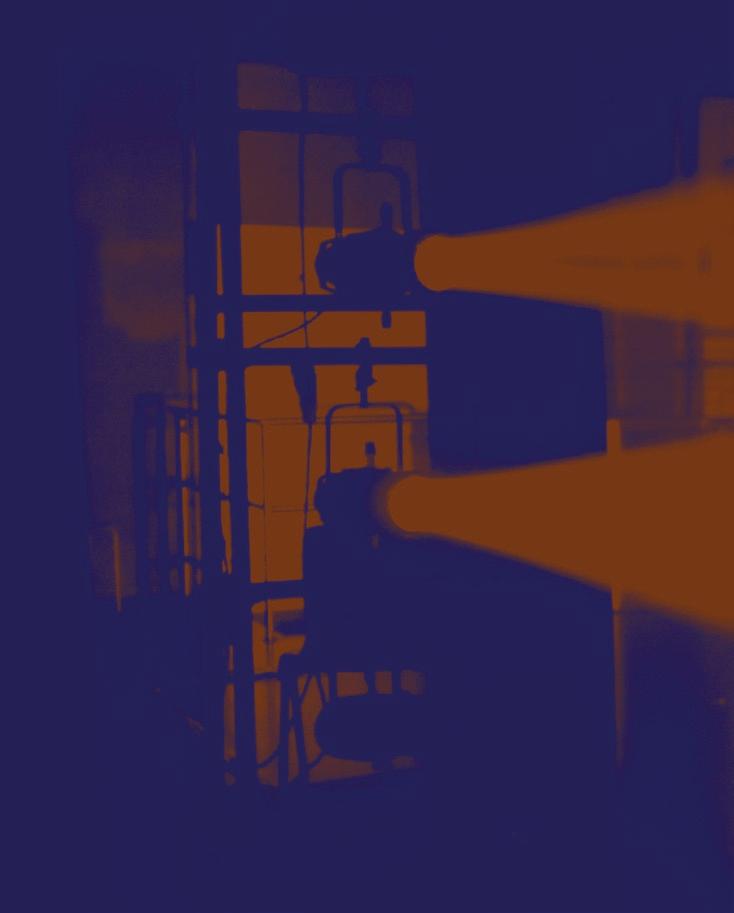
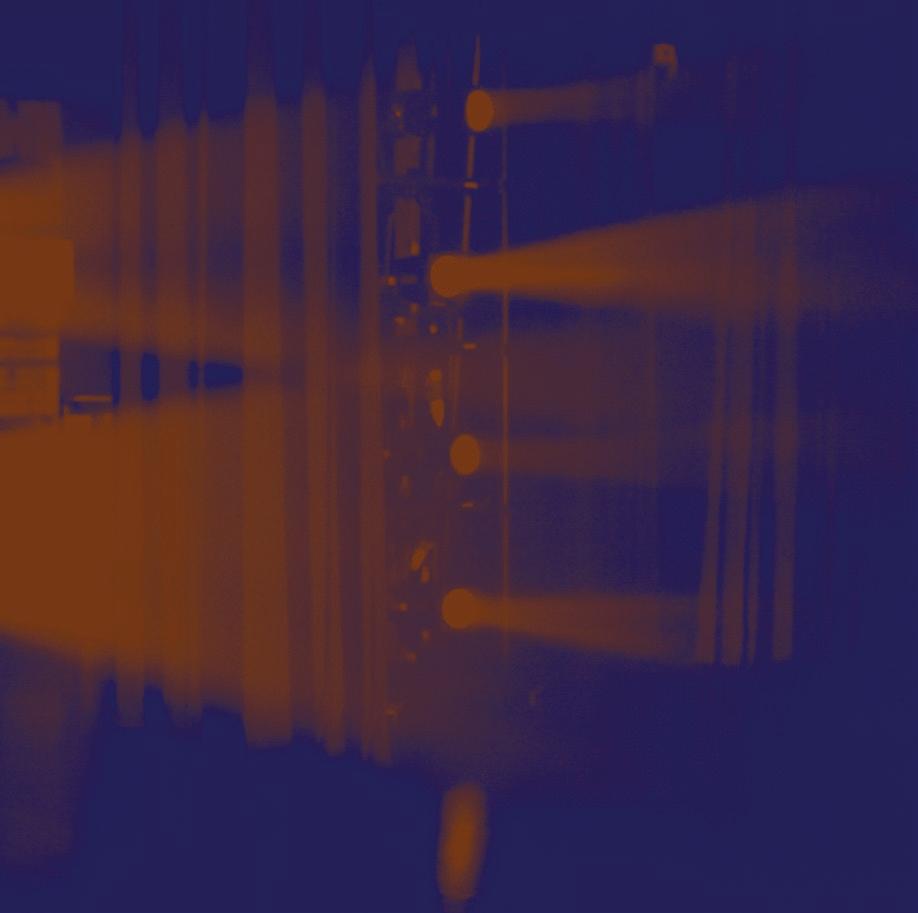
O CIRCOS vai emocionar o público na internet também! Nas redes sociais do Sesc São Paulo e no site, você poderá acompanhar todas as novidades sobre o festival. Textos, fotografias e vídeos vão trazer as curiosidades sobre o evento, bastidores das apresentações, depoimentos de artistas e registros dos espetáculos.
Fique de olho em <sescsp.org.br/circos>
The Sesc International Circus Festival will thrill the audience on the Internet too! On Sesc São Paulo’s social networks and on the website, you will be able to follow all the news about the festival. Articles, photos and videos will show curiosities about the event, what is happening behind the scenes of the presentations, interviews with artists, and recordings of the shows.
Keep an eye on <sescsp.org.br/circos>
< /sesc24demaio>
Rua 24 de Maio, 109, Centro, São Paulo
11 3350-6300
República [400 m]
Anhangabaú [500 m]
São Bento [650 m]
Terminal Bandeira [750 m]
< /sescavpaulista>
Avenida Paulista, 119, Bela Vista, São Paulo 11 3170-0800
Brigadeiro [250 m]
Paraíso [750 m]
< /sescbelenzinho>
Rua Padre Adelino, 1.000, Belenzinho, São Paulo
11 2076-9700
Belém [550 m]
Tatuapé [1.400 m]
4 CAMPO LIMPO
< /sesccampolimpo>
Rua Nossa Senhora do Bom Conselho, 120, Campo Limpo, São Paulo 11 5510-2700
Campo Limpo [500 m]
Vila das Belezas [1.600 m]
Terminal Capelinha [1.200 m]
5 CENTRO DE PESQUISA E FORMAÇÃO
< /cpfsesc>
Rua Dr. Plínio Barreto, 285 - 4º andar, Bela Vista, São Paulo 11 3254-5600
Trianon-MASP [700 m]
Anhangabaú [2.000 m]
Terminal Bandeira [2.000 m]
6 CONSOLAÇÃO
< /sescconsolacao>
Rua Dr. Vila Nova, 245, Vila Buarque, São Paulo 11 3234-3000
Higienópolis-Mackenzie [600 m]
República [900 m]
Santa Cecília [1.000 m]
Terminal Amaral Gurgel [850 m]
7 GUARULHOS
< /sescguarulhos>
Rua Guilherme Lino dos Santos, 1.200, Jardim Flor do Campo, Guarulhos 11 2475-5550
Guarulhos CECAP [2.000 m]
Terminal CECAP [900 m]
8 IPIRANGA
< /sescipiranga>
Rua Bom Pastor, 822, Ipiranga, São Paulo 11 3340-2000
Sacomã [2.200 m]
Ipiranga [2.000 m]
Terminal Vila Prudente [2.800 m]
9 ITAQUERA
< /sescitaquera>
Avenida Fernando Espírito Santo Alves de Mattos, 1.000, Itaquera, São Paulo 11 2523-9200
Itaquera [7.200 m]
Terminal São Mateus [5.200 m]
10 PINHEIROS
< /sescpinheiros>
Rua Paes Leme, 195, Pinheiros, São Paulo 11 3095-9400
Faria Lima [350 m]
Pinheiros [350 m]
11 POMPEIA
< /sescpompeia>
Rua Clélia, 93, Pompeia, São Paulo 11 3871-7700
Barra Funda [2.000 m]
Água Branca [800 m]
Barra Funda [2.000 m]
Parada Barra Funda [2.000 m]
Terminal Lapa [2.100 m]
12 SANTANA
< /sescsantana>
Avenida Luiz Dumont Villares, 579, Santana, São Paulo 11 2971-8700
Jardim São Paulo-Ayrton Senna [850 m]
Parada Inglesa [1.200 m]
Parada Santana [1.700 m]
13 VILA MARIANA
< /sescvilamariana>
Rua Pelotas, 141, Vila Mariana, São Paulo 11 5080-3000
Ana Rosa [750 m]
Paraíso [1.000 m]
Terminal Ana Rosa [750 m]
SHOWS
23 FRAGMENTOS DESSES ÚLTIMOS DIAS
<instrumentodever.com> <letroisiemecirque.com> <instagram.com/instrumentodever> <instagram.com/maroussiadiazverbekepro> <coletivoinstrumentodever@gmail.com>
A FÁBRICA
DOS VENTOS
<instagram.com/trupelonapreta> <hmalonso@gmail.com>
A LIFE IN HER DAY –
UMA VIDA NO SEU DIA <hilarychaplain.com> <instagram.com/hilarychaplain> <hilary@hilarychaplain.com>
BIG BANG
<cargocollective.com/ biolumini/Portfolio> <instagram.com/biolumini_salamandra> <tatiana.outer@gmail.com>
CAOS – FRAGMENTOS POÉTICOS DO COTIDIANO <painesantamaria.com> <instagram.com/painesantamaria> <karina@toca.art.br>
CIRCO DE LOS PIES
<lalunaciadeteatro.com.br> <instagram.com/lalunaciadeteatro> <instagram.com/emelibarossi> <lalunaciadeteatro@gmail.com>
COLIBRI
<instagram.com/umcafedamanha> <instagram.com/albamoncayo> <instagram.com/yoseblon> <instagram.com/circoandante> <instagram.com/requiemduo> <umcafedamanha@gmail.com> <albamnyo.alebrije@gmail.com> <yoseblon@yahoo.com> <circoandante.peru@gmail.com> <requiemduo@gmail.com>
CONSTRUTORES
<instagram.com/coletivovertigem> <coletivovertigemcirco@gmail.com>
CTRL + Z <instagram.com/projeto_ctrl_z> <ctrlz.producao@gmail.com>
CUIR – COURO <diffusion.armour@gmail.com>
EDUKIKAN –CORAÇÃO VALENTE <instagram.com/afuma12> <beltoledooz@gmail.com>
FIO FORTE <instagram.com/circodeebanos> <beltoledooz@gmail.com>
HEROLINO, O FAXINEIRO <instagram.com/erickson.almeida.9> <instagram.com/lastupenda_teatroecirco> <producaostupenda@gmail.com> <circoherolino@gmail.com>
IMINÊNCIA DO AGORA
<karinserafin.wixsite.com/circar> <instagram.com/grupocircar> <machado.adilso@gmail.com> <karinserafin@gmail.com>
ÍTACA
<thiagoandreuccetti.com> <instagram.com/thiandreuccetti> <marina@caruaproducoes.com>
KING KONG FRAN <rafaazevedo.com> <instagram.com/fran.wt> <hafa.azevedo@gmail.com>
ONDE GUARDO UM SONHO <adellycostantini.com> <instagram.com/adellycostantini> <adellycostantini@gmail.com>
ORIRI – A ANCESTRALIDADE ILUMINANDO O PICADEIRO
TRUPE BAIÃO DE 2 <trupebaiaode2.com> <instagram.com/trupebaiaode2>
CIA AFUMA <instagram.com/afuma12> <beltoledooz@gmail.com>
ILÚ OBÁ DE MIN <iluobademin.com.br> <instagram.com/iluoba> <instagram.com/atunko.iluoba> <instagram.com/pernaltasdoorun>
SOLUS AMOR <recirquel.com> <instagram.com/recirquel> <camille@temalproductions.com> <productions@recirquel.com>
UM DOMINGO <linktr.ee/proyectomigra> <instagram.com/proyectomigra> <instagram.com/un.domingo> <contacto@proyectomigra.com> <produccion.undomingo@gmail.com> <eu.circ.producoes@gmail.com>
VACÍO – VAZIO
<oskarmrg.wixsite.com/oskar> <instagram.com/ciaomkara> <arteriaire@hotmail.com> <karina@toca.art.br>
YÉ – ÁGUA
<temalproductions.com/fr> <instagram.com/circus_baobab_familly> <vincent@temalproductions.com> <contact@temalproductions.com>
INTERVENÇÕES ARTÍSTICAS
ARTISTIC INTERVENTIONS
ENTRE SALTOS <manoamana.com> <instagram.com/mano_a_mana> <instagram.com/festivaldecircomam> <duomanoamana@gmail.com>
HA!
<instagram.com/puriyaguarete> <puriyaguarete@gmail.com>
INTERCOMPLEMENTARY ELEMENTS – ELEMENTOS INTERCOMPLEMENTARES <circorebote.com> <instagram.com/erinballcircus> <instagram.com/max_outside_the_box> <kingstoncircusarts@gmail.com>
INTERVENÇÃO DE BAMBOLÊ
<instagram.com/pipa_luke> <pipahulasart10@gmail.com>
OLIMPÍADAS DE MALABARISMOS
<supercirco.com.br> <instagram.com/super.circo> <contato@supercirco.com.br>
PARQUE DO CIRCO
<instagram.com/parquedocirco> <parquedocirco@gmail.com>
VIVÊNCIA DE MALABARISMOS E PIÕES
<instagram.com/caravanatapioca> <contato@caravanatapioca.com>
EDUCATIONAL ACTIVITIES
A ARTE DE TRANS-FORMAR CORPOS: OFICINA DE CONTORCIONISMO PARA PROFESSORES <instagram.com/vimarquezz> <instagram.com/vimarquezacademy> <viccirque@gmail.com>
A LIBERDADE DE SER RIDÍCULA <rafaazevedo.com> <instagram.com/fran.wt> <hafa.azevedo@gmail.com>
COMÉDIA FÍSICA DO PONTO DE VISTA DO PALHAÇO <hilarychaplain.com> <instagram.com/hilarychaplain> <hilary@hilarychaplain.com>
CONSTRUÇÃO DE PORTFÓLIO PARA ARTISTAS INDEPENDENTES <luicastanho.com> <instagram.com/luicastanho> <luicastanhocosta@gmail.com>
CRIATIVIDADE SUSTENTÁVEL: FERRAMENTAS BÁSICAS PARA A GESTÃO CULTURAL INDEPENDENTE <circolabcultural.com.br> <instagram.com/circolabcultural> <circolabcultural@gmail.com> <contato@circolabcultural.com.br>
OFICINA DE DIREÇÃO CIRCENSE <instagram.com/ronaldoaguiar.charlito> <ronaldo.aguiar6@gmail.com>
MESAS PANELS
AS EXPERIÊNCIAS E PERSPECTIVAS DE ARTISTAS COM DEFICIÊNCIAS NO CIRCO <instagram.com/ariadne_dida> <instagram.com/emelibarossi> <instagram.com/erinballcircus>
NARRATIVAS CIRCENSES E PROCESSOS HISTÓRICOS <instrumentodever.com> <instagram.com/loilima08> <instagram.com/indomitacia> <instagram.com/ciatrupeliuds> <instagram.com/quilombaque> <instagram.com/marcomottaart> <loilima08@gmail.com> <indomitacia@gmail.com > <marcomottaart@gmail.com> <dede.ferreirasp@gmail.com> <ciatrupeliuds@gmail.com>
TECNOLOGIAS NOS PROCESSOS DE CRIAÇÕES CIRCENSES <instagram.com/oskar_mauricio_> <instagram.com/mauro_cosenza>
EDIÇÕES SESC
BOOK LAUNCH
A ARTE DO CIRCO NA AMÉRICA DO SUL
<instagram.com/julietainfantino> <instagram.com/circainvestigaccion> <instagram.com/rafa.debarros> <julietainfantino@gmail.com> <rafael.debarros@usp.br>
CIRCUS RESIDENCY
CORPO TERRITÓRIO ANCESTRAL – PROCURA-SE MEMÓRIA
TRUPE BAIÃO DE 2 <trupebaiaode2.com> <instagram.com/trupebaiaode2>
ILÚ OBÁ DE MIN <iluobademin.com.br> <instagram.com/iluoba> <instagram.com/atunko.iluoba> <instagram.com/pernaltasdoorun>
CIA AFUMA
<instagram.com/afuma12> <beltoledooz@gmail.com>
O SESC - o Serviço Social do Comércio é uma instituição privada que promove o bem-estar social, o desenvolvimento cultural e a melhoria da qualidade de vida das pessoas que trabalham nos setores do comércio de bens, serviços e turismo, e da comunidade em geral. O Sesc, por ser mantido pelas empresas dessas áreas, considera como público prioritário seus trabalhadores.
No estado de São Paulo são mais de 40 unidades, onde é possível praticar atividades esportivas, desenvolver hábitos para uma vida mais saudável, participar de excursões e passeios turísticos, adquirir novos conhecimentos e habilidades, frequentar teatros, cinemas, bibliotecas, salas de exposição e outros espaços culturais, além de desfrutar de momentos de lazer com a família e amigos.
Pessoas que trabalham, fazem estágio, atuam de maneira temporária ou se aposentaram em empresas do comércio de bens, serviços e turismo podem fazer gratuitamente a Credencial Plena do Sesc e ter acesso a muitos benefícios. Acesse o app Credencial Sesc SP ou o site <centralrelacionamento.sescsp.org.br> para emitir ou renovar a Credencial Plena de maneira on-line. Nestes mesmos locais também é possível agendar horário para ir presencialmente em uma de nossas Unidades. Mais informações, acesse <sescsp.org.br/credencialplena>
SESC - Social Service of Commerce is a private institution that promotes social well-being, cultural development, and improving the quality of life of people working in the trade in goods, services, and tourism, and the community in general. Sesc, once maintained by companies in these areas, considers its workers a priority public.
In the state of São Paulo, there are more than 40 units where it is possible to practice sports activities, develop habits for a healthier life, participate in excursions and tourist tours, acquire new knowledge and skills, and attend theaters, cinemas, libraries, exhibition halls, and other cultural venues, in addition to enjoying leisure time with family and friends.
People who work, do internships, work temporarily, or have retired from companies in the trade in goods, services, and tourism can apply for the Sesc Full Credential for free and have access to many benefits. Access the Credencial Sesc SP app or the website <centralrelationship.sescsp.org.br> to issue or renew the Full Credential online. In these same places, it is also possible to schedule a time to visit one of our units in person.
For more information, visit <sescsp.org.br/credencialplena>
SESC – SERVIÇO SOCIAL DO COMÉRCIO ADMINISTRAÇÃO
SESC – SOCIAL SERVICE OF COMMERCE REGIONAL ADMINISTRATION OF SÃO PAULO STATE
Presidente do Conselho Regional Chairman of the Council
ABRAM SZAJMAN
Diretor do Departamento Regional Director
DANILO SANTOS DE MIRANDA
SUPERINTENDENTES/ DEPUTY DIRECTORS
Técnico-Social/ Social and Programming
ROSANA PAULO DA CUNHA
Comunicação Social/ Communication
AUREA LESZCZYNSKI VIEIRA GONÇALVES
Administração/ Administration JACKSON DE ANDRADE MATOS
Assessoria Técnica e de Planejamento/ Technical Planning
MARTA RAQUEL COLABONE
Consultoria Técnica/ Technical Consultant
LUIZ DEOCLÉCIO MASSARO GALINA
GERENTES/ MANAGERS
Ação Cultural/ Cultural Action ÉRIKA MOURÃO TRINDADE DUTRA Estudos e Desenvolvimento/ Studies and Development JOÃO PAULO
GUADANUCCI Artes Gráficas/ Graphic Design ROGERIO IANELLI Atendimento e Relacionamento com o Público/ Customer Service and Relationship RICARDO
GENTIL Centro de Produção Audiovisual/ Audiovisual Production Center WAGNER
PALAZZI PEREZ Desenvolvimento de Produtos/ Product Development ÉVELIM MORAES Difusão e Promoção/ Publicity and Promotion
FERNANDO FIALHO Sesc Digital e SescTV/ Digital Sesc FERNANDO AMODEO TUACEK Assessoria de Imprensa/ Press Relations ANA LÚCIA DE LA VEGA Assessoria de Relações Internacionais/ International Affairs
HELOISA PISANI Assessoria Jurídica/ Legal
CARLA BERTUCCI BARBIERI
24 de Maio PAULO CASALE Avenida Paulista
DANIEL HANAI Belenzinho JOSÉ ROBERTO
RAMOS Campo Limpo GRAZIELA NUNES
Centro de Pesquisa e Formação ANDRÉA
NOGUEIRA Consolação ANTONIO MARTINELLI
Guarulhos OSWALDO JUNIOR Ipiranga
LUCIANA ITAPEMA Itaquera RICARDO DE OLIVEIRA SILVA Pinheiros JAYME ANTONIO
PAEZ FILHO Pompeia MÔNICA CARNIETO
Santana LILIA MARCIA BARRA Vila Mariana
KELLY ADRIANO
– FESTIVAL
INTERNACIONAL SESC DE CIRCO
CIRCUS – SESC
INTERNATIONAL CIRCUS FESTIVAL
Coordenação/ Coordination
MARINA TOMAZ ZAN, NATALIE FERRAZ KAMINSKI
Curadoria de Espetáculos/ Artistic Curatorship
AMANDA CRISTINA DA SILVA, ARI FELIPE MIACIRO, JULIO POMPEO, LAYANA PERES DE CASTRO, MARINA TOMAZ ZAN, NATALIE FERRAZ
KAMINSKI E WILLIAN PEREIRA
Equipe/ Team Sesc ALINE RIBENBOIM, ANDRÉ CONCEIÇÃO, ANDRÉ QUEIROZ, BRUNA DAMASCENO, BRUNA MARCATTO, CARLA FURTADO, CARLOS ROCHA, CAROLINA VIDAL FERREIRA, CAROLINE ZEFERINO, CHRISTI LAFALCE, CRISTIANE KOMESU, DANIEL TONUS, DANNY ABENSUR, ELLEN DE ABREU, ÉRICA DIAS, FABIO MATTOS, FERNANDO AMODEO TUACEK, FRANCISCO
MANOEL SANTINHO, FRED ZARNAUSKAS, GABRIELA AMORIM, GREG LIXANDRÃO, GUSTAVO RODRIGUES DE FREITAS, IGOR PIROLA, JOANA EÇA DE QUEIROZ, JOSÉ GONÇALVES JUNIOR, JULIANA RAMOS, KARINA MUSUMECI, LAURA MAGALHÃES, LEANDRO NUNES COELHO, MALU MIRANDA, MARINA VILLAR, MÁRCIA MARQUES, MATHEUS JOSÉ MARIA, NAIARA CÂNDIDO SACILOTTO, PATRICIA SANTOS, PRISCILA NUNES, RAFAELA OMETTO, REGINA GAMBINI, RICARDO FERREIRA, RONALDO DOMINGUES, RUBENS LUTERO, TAMARA DEMUNER, THIAGO MACHADO, TICIANA PARISI, VANESSA FIDALGO, VITOR FRANCISCON, VIVIANE MACHADO LEMOS, WELLINGTON SILVA SANTOS
Produção, Edição e Tradução de Textos/ Text Editing and Production LÚCIA NASCIMENTO
Revisão/ Revision
SAMANTHA ARANA
Identidade Visual e Projeto Gráfico/ Visual Identity and Graphic Design
IAN HERMAN E THAIS FRANCO
Diagramação/ Layout
NATALIA ZAPELLA
Produção/ Production
MARIANA NOVAIS
Agradecimentos
Escritório de Representação em São Paulo do Ministério das Relações Exteriores e ao Consulado Geral do Brasil em Marselha.
Acknowledgments
Representation Office in São Paulo of the Ministry of Foreign Affairs and Consulate General of Brazil in Marseille.
C4962 CIRCOS: Festival Internacional Sesc de Circo / Serviço Social do Comércio - Administração Regional no Estado de São Paulo, 132 p. –
São Paulo: Sesc São Paulo, 2023. –132 p. 2023 – . il.: fotografias. bilíngue. (português/inglês).
ISBN 978-65-89239-49-9
16 a 25 de junho de 2023.
1. Circo. 2. Arte Circense. 3. Festival Internacional Sesc de Circo. 4. Catálogo. I. Subtítulo. II. Catálogo CIRCOS, 2023. III. Serviço Social do Comércio. IV. Sesc São Paulo. VI. Sesc.
CDD 792
< sescsp.org.br/circos >




